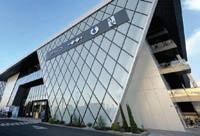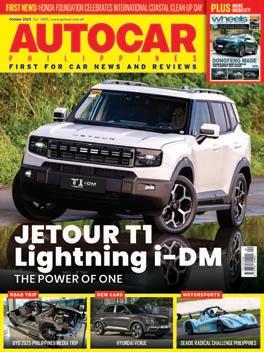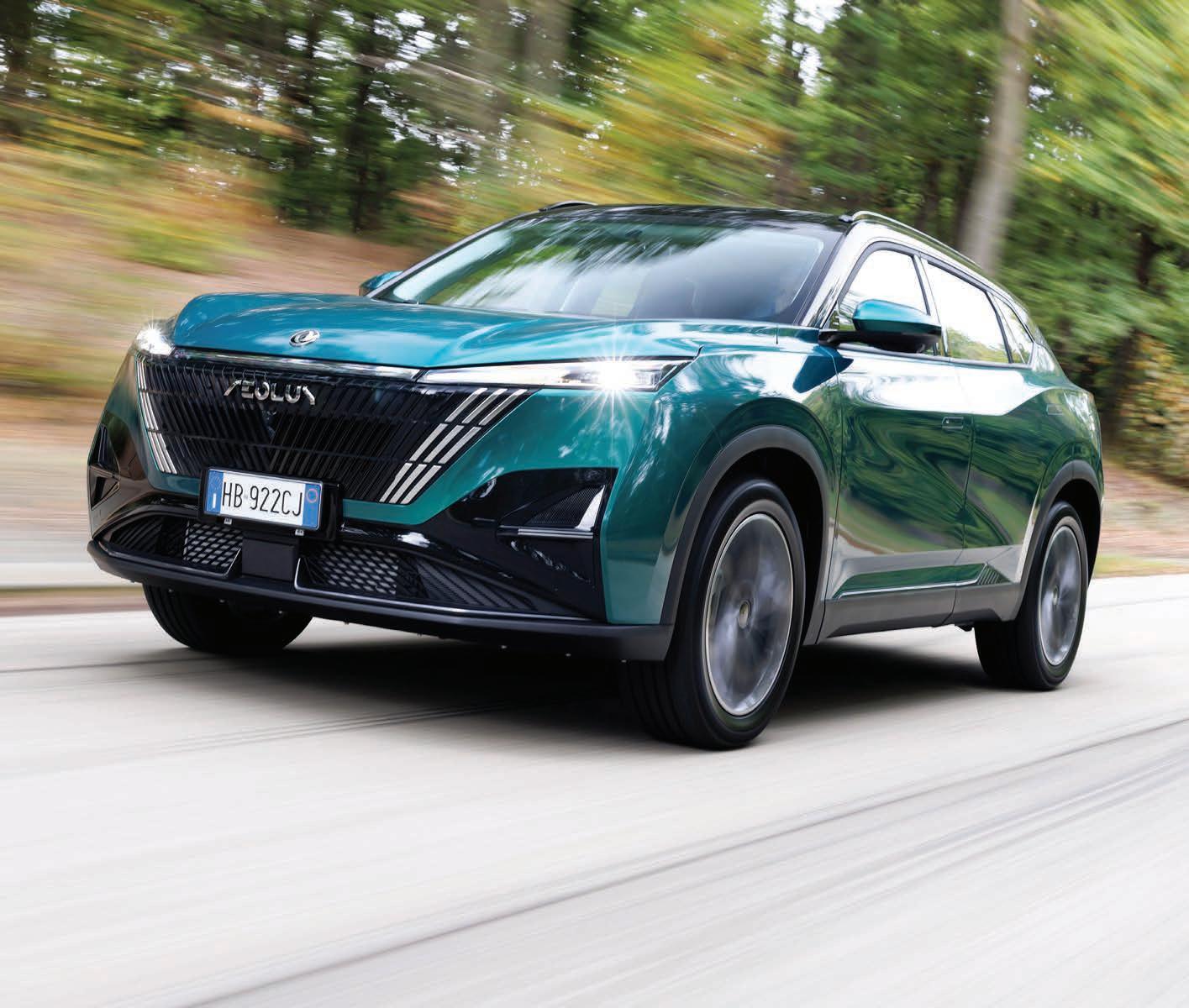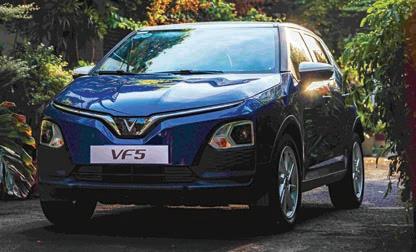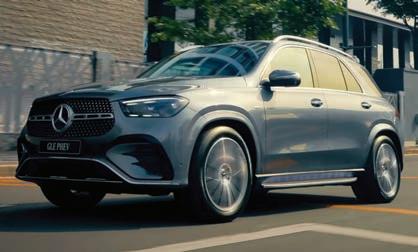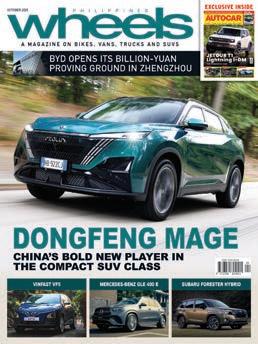
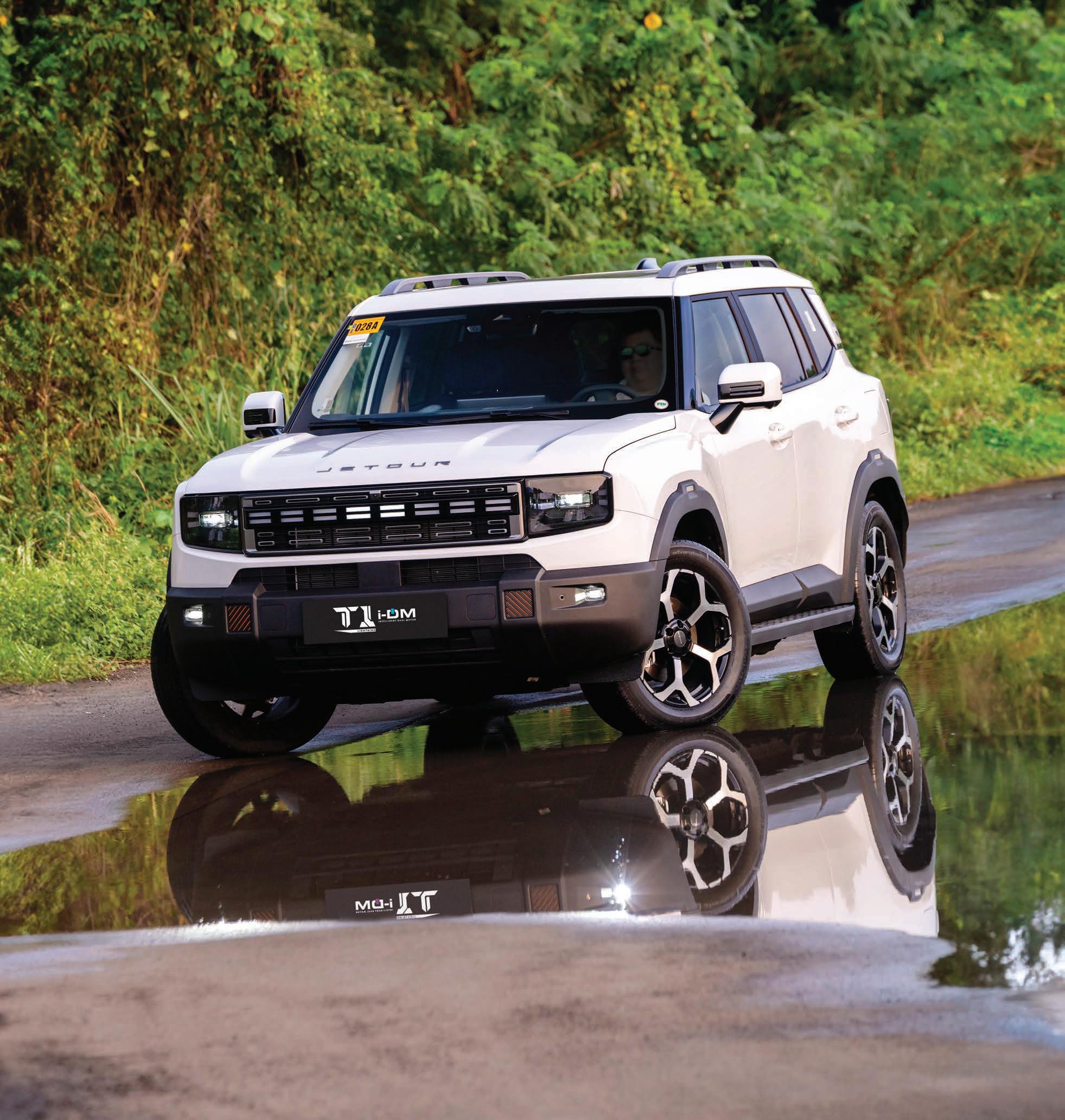
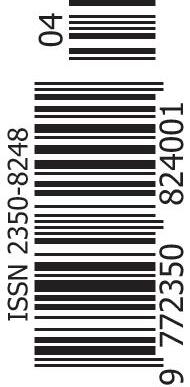
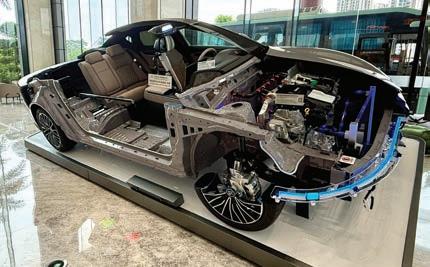

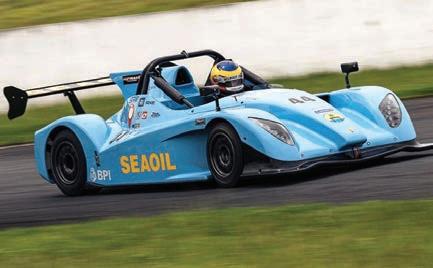
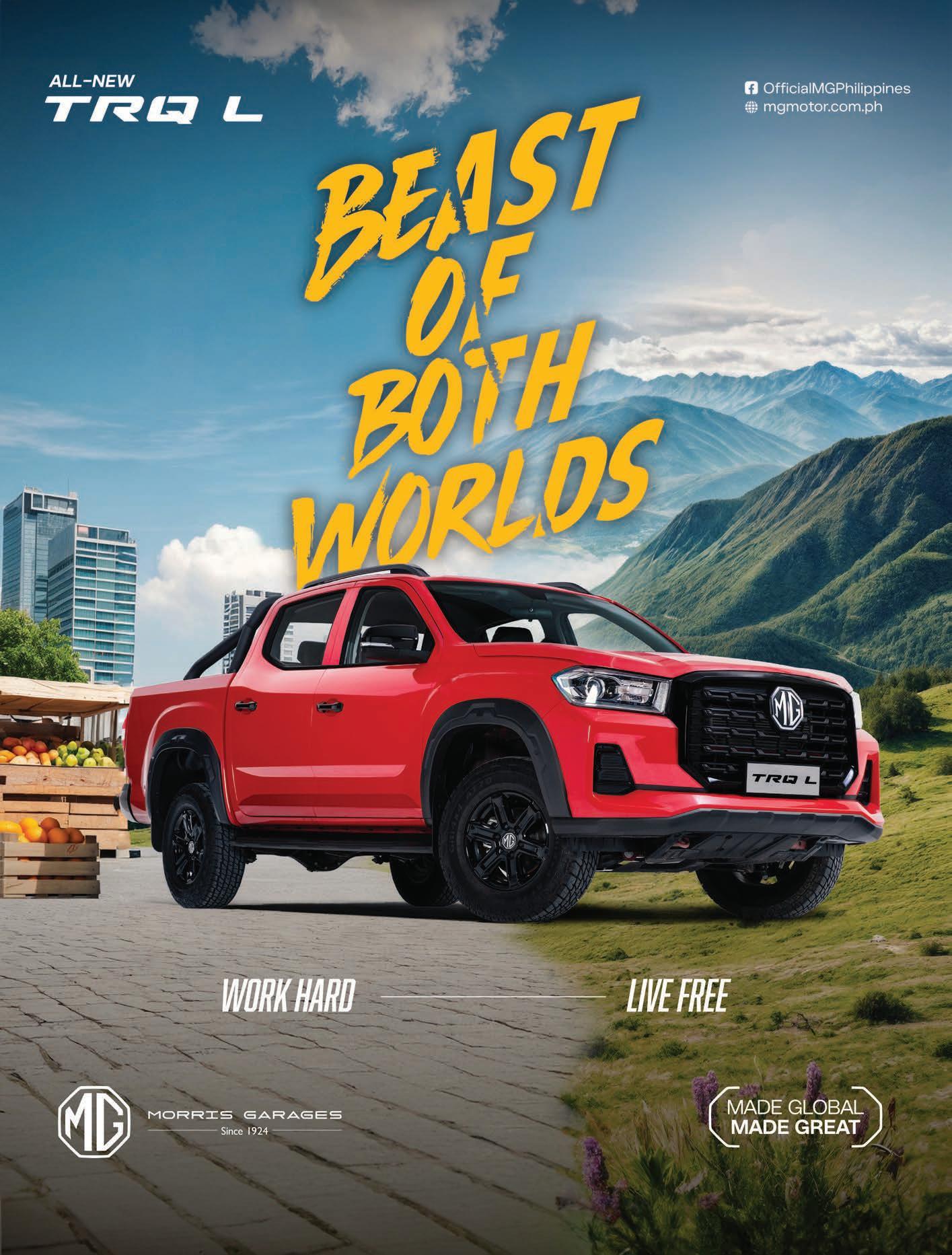








October 2025 | Volume 12
2 Editors Note Neil Pagulayan
4 Windshield Watcher Anjo Perez
6 Opposite Lock Binky Siddayao TECH
8 Here’s what Apple CarPlay users can expect with new iOS 26
8 The Charge Is On UAAGI Launches RADAR’s All-Electric Pickup Line
CARS
10 Hyundai Venue
11 Mercedes-Benz GLE 400e
12 Subaru Forester
13 Suzuki Fronx
14 Honda Foundation Celebrates International Coastal Clean-up Day with Community Activity at Brgy. Caingin, Sta. Rosa
15 Isuzu Continue to Lead Truck Market with 10% Year-on-Year Growth Across All Segments
16 JETOUR Philippines celebrates International Dog Day
Lynk & Co hosts first Lynk Ups going beyond car talks
17 NLEX rolls out P200M SCTEX upgrades to boost customer experience Omoda & Jaecoo’s fuel economy confirmed via Independent AAP testing
TRIP
18 BYD 2025 Philippines Media Trip
20 BYD Di Space
22 A fun day at the BYD Zhengzhou All-Terrain Circuit
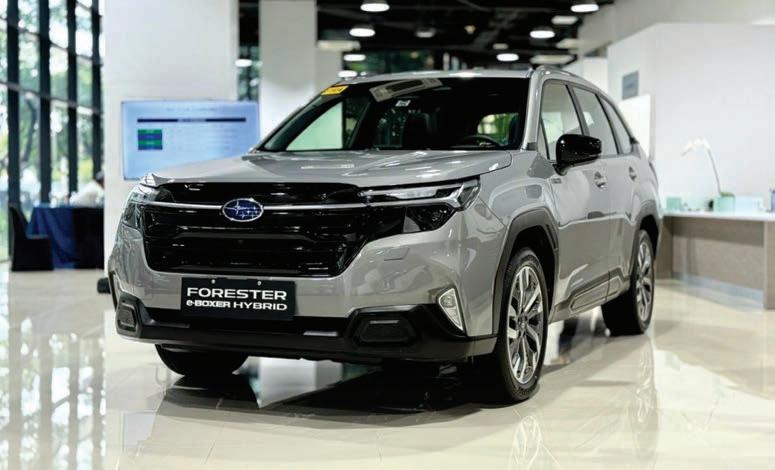
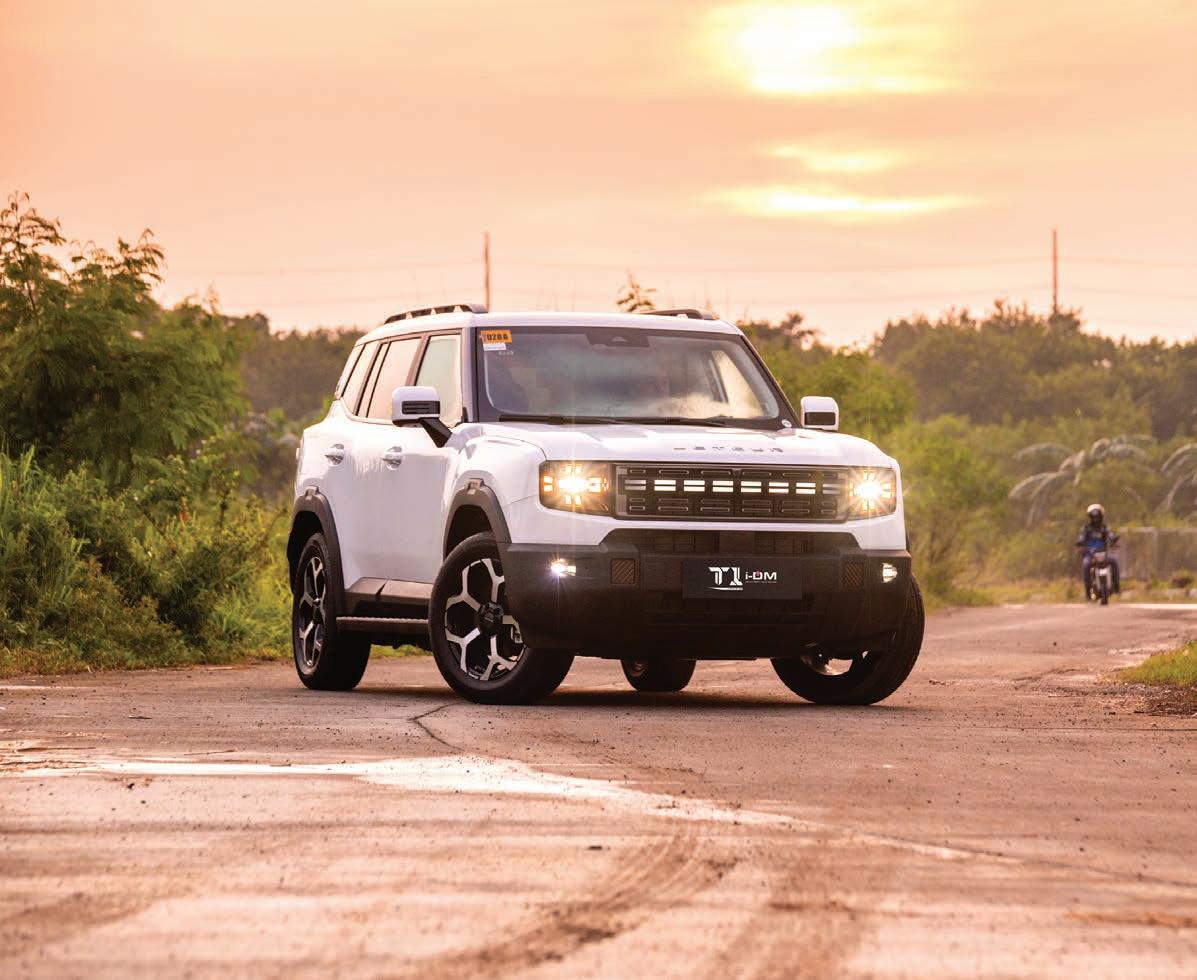
24 BYD Tech Speak – What does it all mean?
26 Suzuki Fronx: Mild drive to Bataan
28 JETOUR T1 Lightning i-DM: The Power of One
38 Are you the next Toyota GR GT Cup PH eSports champion?
39 2025 SEAOIL Radical Challenge PH title fight intensifies
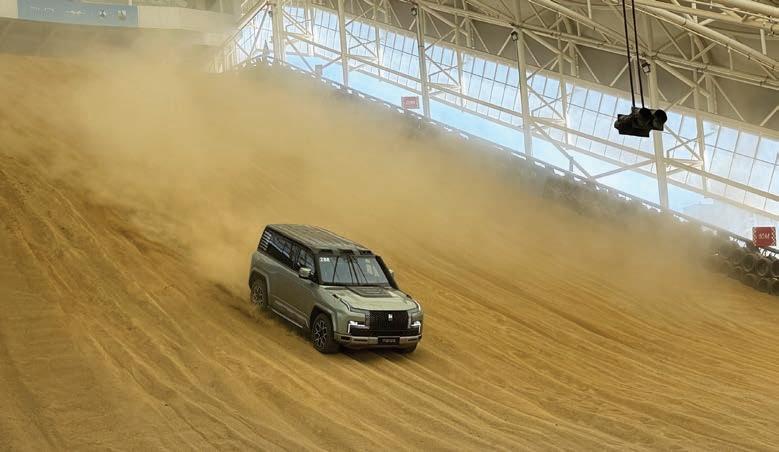

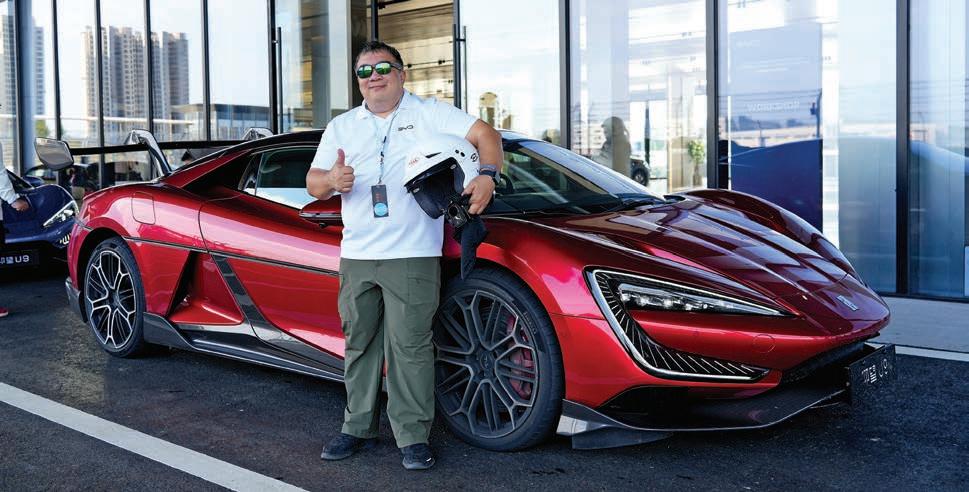
We’re almost at the “most wonderful time of the year,” and that usually brings with it the lastquarter rush, with car companies scrambling to finish their year’s activities and vehicle launches. With so many more brands now in the country, it just means proportionally more activities here and abroad with the different manufacturers. We here at Autocar PH can’t complain — more cars, more fun!
To be honest, the rush has been ongoing pretty much the whole year. While we try to keep up, here’s our October issue to bring you up to speed on what we’ve been up to. As always, we have Industry News and recently launched vehicles. On our cover is JETOUR’s newly launched plug-in hybrid offering, the very desirable T1. On the day we shot this, we tried to be as discreet as possible, but it still drew quite a bit of attention. Well, here it is in its full glory — with all the details inside.
The Suzuki Fronx also just launched, and we had the chance to take it on a long drive to see what kind of fuel economy we could get from its mildhybrid powertrain. Along the way, we dropped by the Pawikan Conservation Center in Morong, Bataan.
We also had the chance to fly to China again — this time with BYD — to visit their HQ in Shenzhen and see their latest tech innovations. From there, we flew out to Zhengzhou to experience how those same technologies perform in their new vehicles at their test track. I even got to ride (and scream like a little girl!) in their sexy hypercar, the U9 — not the 3,000-hp version, mind you, just the “base” model with a meager 1,300 hp. And yes, it was quite a lot of fun.
The industry shows no signs of slowing down toward the end of the year. We’re all looking forward to seeing what cool new things will be on display at the Japan Mobility Show. Our editorial team is headed there with the different Japanese brands and will have a full event report for you next month.
By the way, our website has gotten a muchdeserved makeover! Do check it out at autocar. com.ph and show us some love on our social media portals too.
What a great time it is to love cars! Whether you prefer electrified or ICE power, there’s something for everyone.
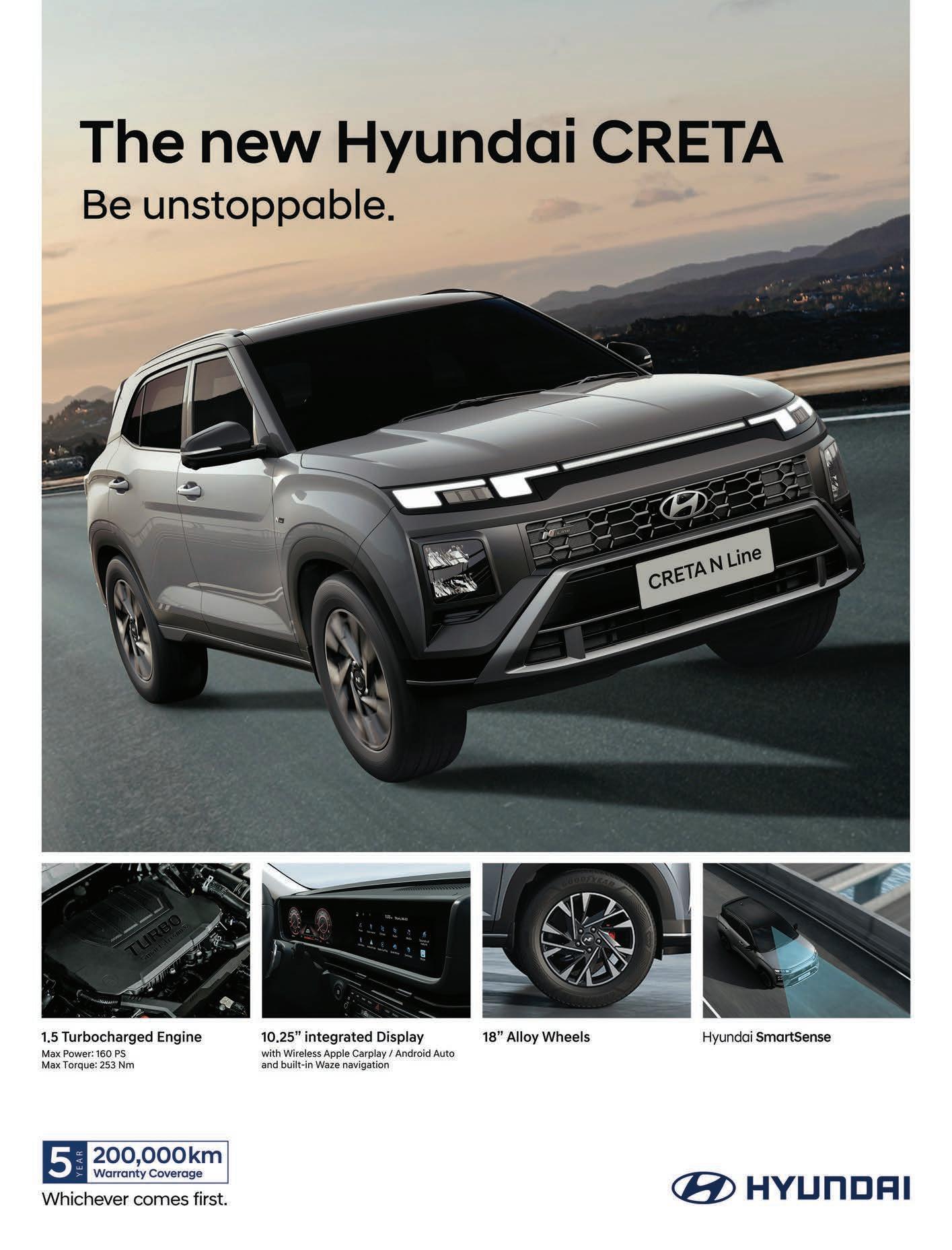

What began as an outpouring of compassion turned into one of the longest traffic jams Cebu has seen in years.
After a powerful earthquake struck the northern part of Cebu Province on October 1, residents in towns like Bogo, San Remigio, and Medellin faced devastation — more than 70 lives lost, homes and buildings damaged, and infrastructure crippled. Electricity returned within days, but the water supply remained disrupted as pipes and main lines lay broken.
As news of the situation spread, Cebuanos rallied in true bayanihan spirit. Car clubs, businesses, civic groups, and ordinary citizens from Cebu City loaded up pickup trucks, delivery vans, and SUVs with water, food, and toiletries bound for the north. Even emergency vehicles from Metro Manila — including donated fire trucks used to transport water — joined the relief convoy.
By Saturday morning, the 100-kilometer stretch from Mandaue to Bogo had turned into a slow-moving caravan of compassion. Vehicles started rolling out as early as 3 a.m., but by 6 a.m., the two-lane highway was packed solid. From above, it must have looked like a train of headlights stretching across the province — a moving testament to how Cebuanos come together in times of crisis.
But what began as organized chaos quickly turned into pure gridlock.
As the morning wore on, the spirit of volunteerism was tested by something else entirely: entitlement. Convoys escorted by vehicles with sirens, blinkers, and even LGU markings began weaving through the lanes, counterflowing to “get there faster.” Their logic? They were

delivering relief too — and therefore deserved to get ahead.
Each time one of these convoys forced their way through, the ripple effect was immediate. Lines broke down, drivers panicked, and intersections choked. With over 50 such escorted groups seen along the route, the resulting gridlock was nothing short of monumental. The drive from Cebu City to Bogo — normally two and a half hours — stretched to more than 10.
One volunteer described it best: “It was a literal carmageddon. Everyone on that road was going to help, but some people acted like their mission was more important than everyone else’s.”
Despite the chaos, what stood out was the scale of generosity. Trucks filled to the brim with bottled water and instant noodles crawled alongside motorcycles loaded with boxes strapped to their backs. Families handed out snacks to stranded drivers. Strangers shared fuel and directions. It was the Filipino spirit at its best — and worst — playing out on the


same road.
The Department of Public Works and Highways has since opened several alternate routes to the north to ease congestion for continuing relief efforts. Local authorities have also called on volunteers and LGU escorts to coordinate with traffic enforcers instead of acting independently.
The Cebu “relief traffic” should serve as a wake-up call. Emergencies don’t suspend traffic laws, and no amount of good intention justifies putting others at risk. Organizers of future relief missions — especially those using escorted convoys — need to work with the police and local governments to schedule deployment waves and identify staging areas to avoid clogging critical roads.
Bayanihan doesn’t mean getting there first. It means getting there together — and safely.


Sébastien Ogier clinched his fifth win of the season and surged into the FIA World Rally Championship lead with a commanding performance at Rally Chile Bio Bío.
The eight-time world champion completed a remarkable weekend by beating title rival and Toyota Gazoo Racing team-mate Elfyn Evans by 11sec with co-driver Vincent Landais alongside. Evans had begun Sunday’s fourstage finale just 6.3sec adrift in an identical GR Yaris Rally1 car. Toyota’s 10th win of the season also pushed the Japanese marque further clear of Hyundai Motorsport, edging it closer to a fifth consecutive manufacturers’ title. Adrien Fourmaux led at the end of day one but ultimately finished third - Hyundai’s top performer - ending the rally behind Evans to secure his third podium of the year.
Ogier’s triumph - his second in as many rounds - also cemented Toyota’s status as the most successful manufacturer in WRC history with 103 wins. It moves him two points clear of Evans in the drivers’ standings with just three rounds remaining and, crucially, means Ogier will open the road at next month’s Central European Rally, a strategic benefit on sealed-surface stages. Much like his victory in Paraguay, Ogier’s weekend in Chile began with a tough Friday. He dropped as low as fifth before rebounding on Saturday, aided by set-up changes and damp conditions that shifted the dynamics. A masterful final leg left Evans with no answer, as Ogier collected maximum Super Sunday and Wolf Power Stage points.
“It is like we wanted,” Ogier said. “It has been a more difficult weekend than Paraguay. We had to fight a bit more, we had a little issue in the mornings as I was not awake but we can be pleased with the way we ended up. “I’m happy with that and I’m looking forward to switching to tarmac.” The Frenchman also referenced the historic significance of his victory, Toyota’s 103rd: “Now we are number one - a record for Toyota more than deserved.” Toyota’s 10th win of the season also pushed the Japanese marque 125 points clear of Hyundai Motorsport, edging it closer to a fifth consecutive manufacturers’ title. Adrien Fourmaux led at the end of day one and ultimately finished third - Hyundai’s top performer - ending the rally 35.5sec behind Evans to secure his third podium of the year. Defending champion Thierry Neuville
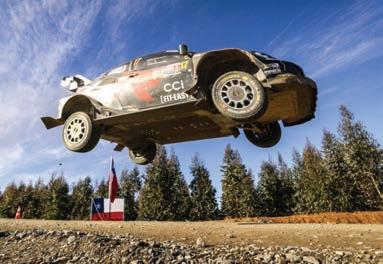
followed 12.5sec further back in his similar i20 N Rally1 but expressed frustration that his driving efforts weren’t being reflected in the stage times. Team-mate Ott Tänak, who retired from the lead with engine failure on Friday, restarted but could only salvage one point and he continued to experience issues with his replacement power unit. “It is very frustrating, but it is the same for the whole team,” Neuville admitted. “But it keeps on going which makes it even worse. I’m happy with my driving and that is the only thing we can do at the moment.” Kalle Rovanperä arrived in Chile second in the standings but dropped to third after finishing sixth overall, his weekend hampered by a tyre debeading after hitting a bank on day one. The Finn now trails Ogier by 21 points. Takamoto Katsuta and Grégoire Munster completed the top eight, while ninth-placed Oliver Solberg became the first title winner of the season. He held off Nikolay Gryazin to seal the WRC2 crown alongside co-driver Elliott Edmondson. The WRC returns to Europe this month for the Central European Rally (October 16-19), the 12th round of the season. Based in Passau, the event will take crews across asphalt stages spanning Germany, Austria, and the Czech Republic.
Mohammed Ben Sulayem is on course to be re-elected as FIA president unopposed after an election rule technicality left his rivals unable to field valid teams for December’s vote.
The 63-year-old, who took offi ce in 2021, is seeking a second four-year term at the FIA’s General Assemblies in Uzbekistan on December 12. Despite three declared challengers — former F1 Steward Tim Mayer, Swiss Racer Laura Villars, and Belgian TV
presenter Virginie Philippot — the rules appear to have locked out any competition. FIA election regulations require each presidential hopeful to submit a full “presidential list” by October 24, including nominees for senior roles and seven vice presidents for sport, each representing one of the FIA’s global regions. Those vice presidents must come from a list of candidates eligible for the World Motor Sport Council (WMSC). That list, published this month, includes only one eligible South American — Fabiana Ecclestone of Brazil, who already sits on Ben Sulayem’s ticket.
With WMSC candidates barred from appearing on multiple presidential lists, no other contender can now satisfy the regional quota, effectively handing Ben Sulayem another term by default. The outcome leaves Mayer, who has spent months campaigning around the world with his “FIA Forward” platform, unable to qualify for the ballot. “I recently spent a few, extremely busy days in South America visiting our member clubs in Chile, Bolivia and Argentina,” Mayer said in a campaign update. “The welcome was warm in each country… but my visit further reinforced FIA Forward’s opinion that the FIA needs to provide unique solutions to each region’s unique challenges.” Despite those efforts, the lack of an eligible South American nominee has proven decisive. The FIA’s nomination deadline for WMSC candidates expired on September 19, leaving no way for other names to be added. All 11 South American motorsport federations had already declared support for Ben Sulayem earlier this year in a joint letter also signed by Ecclestone, underlining the incumbent’s regional strength. Ben Sulayem’s presidency has divided opinion. Supporters point to improved fi nancial stability and post-pandemic recovery, while critics have accused him of centralising too much power and operating with limited transparency. His tenure has also been marked by high-profi le resignations, including those of CEO Natalie Robyn, technical director Tim Goss, and sporting director Steve Nielsen, as well as deputy president for sport Robert Reid earlier this year as reported by SpeedCafe’s Ben Waterworth.

EDITORIAL TEAM
IRA V. PANGANIBAN Editor-in-Chief
ANJO PEREZ Associate Editor
NEIL PAGULAYAN Executive Editor
JACOB OLIVA Managing Editor Digital
EGGAY QUESADA Editor At Large
OLSON CAMACHO Technical Editor
RONNIE TRINIDAD Visual Technical Director
ADRIAN RAYNES IT and Digital Consultant
MATT PRIOR | KRIS LIM | BINKY SIDDAYAO Columnists
JOHN REY SAN DIEGO Staff Writer
WILLIAM HERRERA | LUIS GERONA | RANDY PEREGRINO Contributors
BONG BOADO | KEITH MARK DADOR | LOUIE CAMACHO
MARK QUESADA | ALAN RANCH SEVILLA | RANDOLPH DE LEON
ARNOLD RIODEQUE | BOBS JEROME | MEMERT MONTELOYOLA
Photographers
RAYMUND RAVANERA Graphic Design
SPECIAL THANKS TO
JETOUR Auto Philippines Inc. (JAPI)
Miguelito Jose Managing Director May Moreno-De Los Santos Marketing Director Cameron L. Arciaga Marketing Officer
EDITORIAL TEAM
ANJO PEREZ Editor-in-Chief
RICA SISON, JOSEPH BAUTISTA, LARA CAMACHO Contributors
WILLIAM HERRERA, NEIL PAGULAYAN
MARK QUESADA Photographer
JOHN REY SAN DIEGO Staff Writer
RAYMUND RAVANERA Graphic Designer
Contact us at info@wheelsph.com
Wheels Magazine is published monthly, a registered trademark of Asian Media Ventures, Inc. in cooperation with Gulf News. Copyright 2015.
IN MEMORIAM
Alan Ranch Sevilla • Earl Manalansan • Dino Ray Directo III • Edward Dangan II
The original car magazine, published since 1895 ‘in the interests of the mechanically propelled road carriage’
Editor Mark Tisshaw
Editor-in-Chief Steve Cropley
Magazine Editor Rachel Burgess
Acting Managing Editor James Attwood
Digital Editor Murray Scullion
Editor-at-Large Matt Prior
Deputy Editor Felix Page
Road Test Editor Matt Saunders
Deputy Road Test Editor Richard Lane
Road Tester Illya Verpraet
News Editor Will Rimell
Autocar magazine and the Autocar logo are trademarks of Haymarket Media Group Limited, United Kingdom and used under license by Autobrands Media Ventures, Inc. Content reproduced from Autocar magazine © Haymarket Media Group Limited 2011 all rights reserved.
The views and opinions expressed within Autocar PH magazine are not necessarily those of Haymarket Media Group Limited or those of its contributors.
Autocar magazine is published in China, Greece, India, Indonesia, Malaysia, Philippines, Poland, Singapore, Thailand, and United Kingdom. www.haymarket.com

Published by

ASIAN MEDIA VENTURES, INC.
No.44 Gng. Aurora Quezon Ave BF Manresa, BF Homes, Parañaque City Telephone No. (02) 8-9259179
CORPORATE TEAM
Chairman of the Board of Directors GEORGE APACIBLE
President/CEO IRA V. PANGANIBAN
Vice President Publication ANJO PEREZ
Vice President RONNIE TRINIDAD
Secretary OLSON CAMACHO
Treasurer EGGAY QUESADA
Director for Sales and Marketing CAROL “DANG” B. DORIA
Administrative Head KAITE S. BELGICA
For
distribution or subscription, please call (02)
or email info@wheelsph.com
The views and opinions expressed within Autocar Magazine are not necessarily those of Asian Media Ventures, Inc. or those of its contributors. While every care has been taken in the preparation of this magazine, the publishers cannot be held responsible for the accuracy of the information herein, or any consequences arising from it. In case of all product reviews, judgements have been made in the context of the product based on Philippines prices at the time of review, which are subject to fluctuation and only applicable to the Philippines market.
If you’re an Android user, you’re probably happy for iOS users, as they, too, will finally be able to enjoy features like Call Screening and Live Translation, after years of waiting. In addition to these, the latest iOS update also introduces new features for Apple CarPlay.
If you enjoy Apple CarPlay in your daily drives, then we have some good news for you. Along with the global launch of iOS 26 last September 15, 2025, the latest Apple operating system brought in new updates for Apple CarPlay.
With the return of the no-contact apprehension policy, which means stricter implementation of RA No. 10913, also known as the Anti-Distracted Driving Act (ADDA), driving with Apple CarPlay is always a better option.
Through the iOS 26 update, Apple CarPlay has been improved with a list of improvements that will help drivers maintain their hands on the wheel and not on the screen.
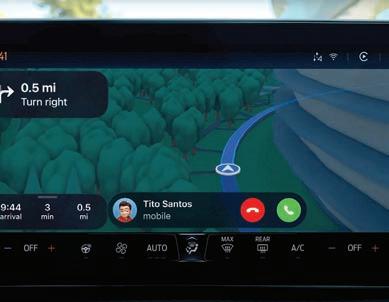
First, it gets a redesigned user interface, particularly new app icons that are now more visible in both light and dark modes. Calls can now also be taken without interrupting existing screens, like navigation. A compact display for calls will appear, hovering over the existing screen, eliminating the need to slide back to previous screens after every call.
The updated Apple CarPlay also
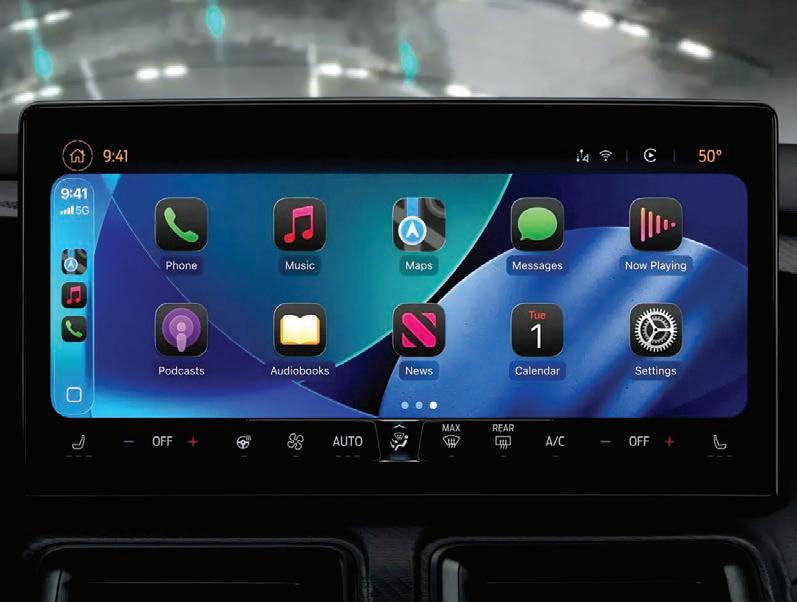
introduced Tapbacks for messages. This feature allows for quick emoji replies, such as love and thumbs up, among others. Pinned conversations are also now available for quick message access on the fly.
Additionally, widgets have been added to the latest Apple CarPlay update, enabling more convenient screen use. Activating the right CarPlay widgets can help drivers stay informed even on the fly, without the need to touch the screen.
Aside from the generic Apple CarPlay, Apple also announced CarPlay Ultra, a next-generation system that elevates the CarPlay experience to a whole new level through a uniform interface across all dash screens, including the instrument cluster.
The CarPlay Ultra promises the ultimate in-car experience by deeply integrating with the vehicle. For example, both real-time content and gauges can be
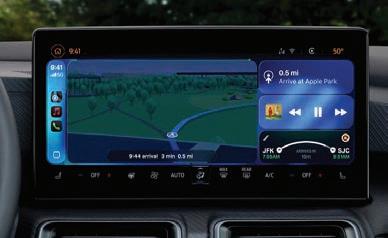
displayed in the instrument cluster, as well as other content, through various in-dash screens. As per Apple, it can also be fully customized to the driver’s preference. Select Aston Martin models are eligible for the new CarPlay Ultra upgrade. Apple also shared that other car brands are showing interest in adopting CarPlay Ultra in their vehicles, particularly South Korean brands such as Hyundai, Kia, and Genesis.
JOHN REY SAN DIEGO
UAAGI Launches RADAR’s All-Electric Pickup Line
United Asia Automotive Group, Inc. (UAAGI) is charging into new territory with the introduction of RADAR, a global pickup brand from Geely Auto Group that specializes in electrified trucks. As the official distributor of RADAR in the Philippines, UAAGI is looking to carve out a strong position in the country’s fast-emerging New Energy Vehicle (NEV) segment.
“With the launch of RADAR, UAAGI not only diversifies its vehicle lineup but also contributes to the expansion of the NEV market across the archipelago,” said UAAGI Chairman Rommel L. Sytin. “Our goal is to lead the charge in this growing segment and meet the evolving demands of Filipino motorists.”
The RADAR brand—known as Riddara in some markets—has already made its mark globally. In China, it commands more than half of the NEV pickup segment and has held the number one spot since 2023. The brand’s reach extends across AsiaPacific, Eastern Europe, the Middle East, and the Americas, proof of its universal appeal and solid engineering.
Now officially in the Philippines, RADAR enters with a clear message: “Built Electric. Built Solid.” Its first salvo? The RADAR RD6, a modern, mid-size pickup that combines the toughness of a truck with the refinement of an SUV. The RD6 is available in
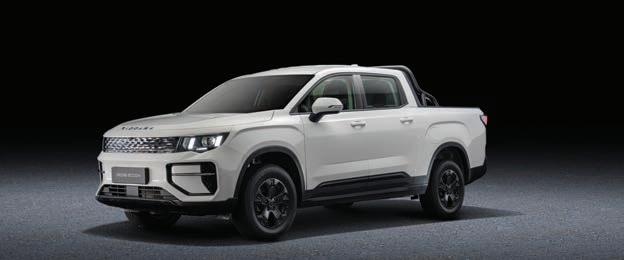
both fully electric (BEV) and plug-in hybrid (PHEV) versions— designed to serve both commercial users and private owners who want to go green without giving up power or practicality.
The RD6 ECON is all-electric and surprisingly quick. Its dualmotor setup—136 PS in front and 245 PS at the rear—delivers a total of 381 PS and 485 Nm of torque, launching it from zero to 100 km/h in just 5.7 seconds. It’s no lightweight either, offering a one-ton payload, a spacious cargo bed that stretches 1,765 mm (the longest in its class), and an 815 mm wading depth for extra confidence when the road turns rough.
Built tough with 70% high-strength steel, the RD6 ECON offers impressive durability and safety. Inside, it keeps things functional but modern, featuring an 8-inch touchscreen display, reverse camera, rear sensors, and easy-to-clean synthetic seats—perfect for work or weekend use.
A single charge can take you up to 443 kilometers (NEDC), making it one of the most practical EV pickups around. Pricing starts at P1,358,000 for the 4x2, P1,548,000 for the longbed variant, and P1,698,000 for the AWD model—remarkably accessible for a fully electric truck.

We are now in the final quarter of the year, with the season about to get merry, the Philippine automotive industry is not showing any slow downs with all the new model releases. September showed a lot of interesting newcomers, familiar returning namplates and some new badges. Without further ado, here are the new car models recently welcomed in the local market.
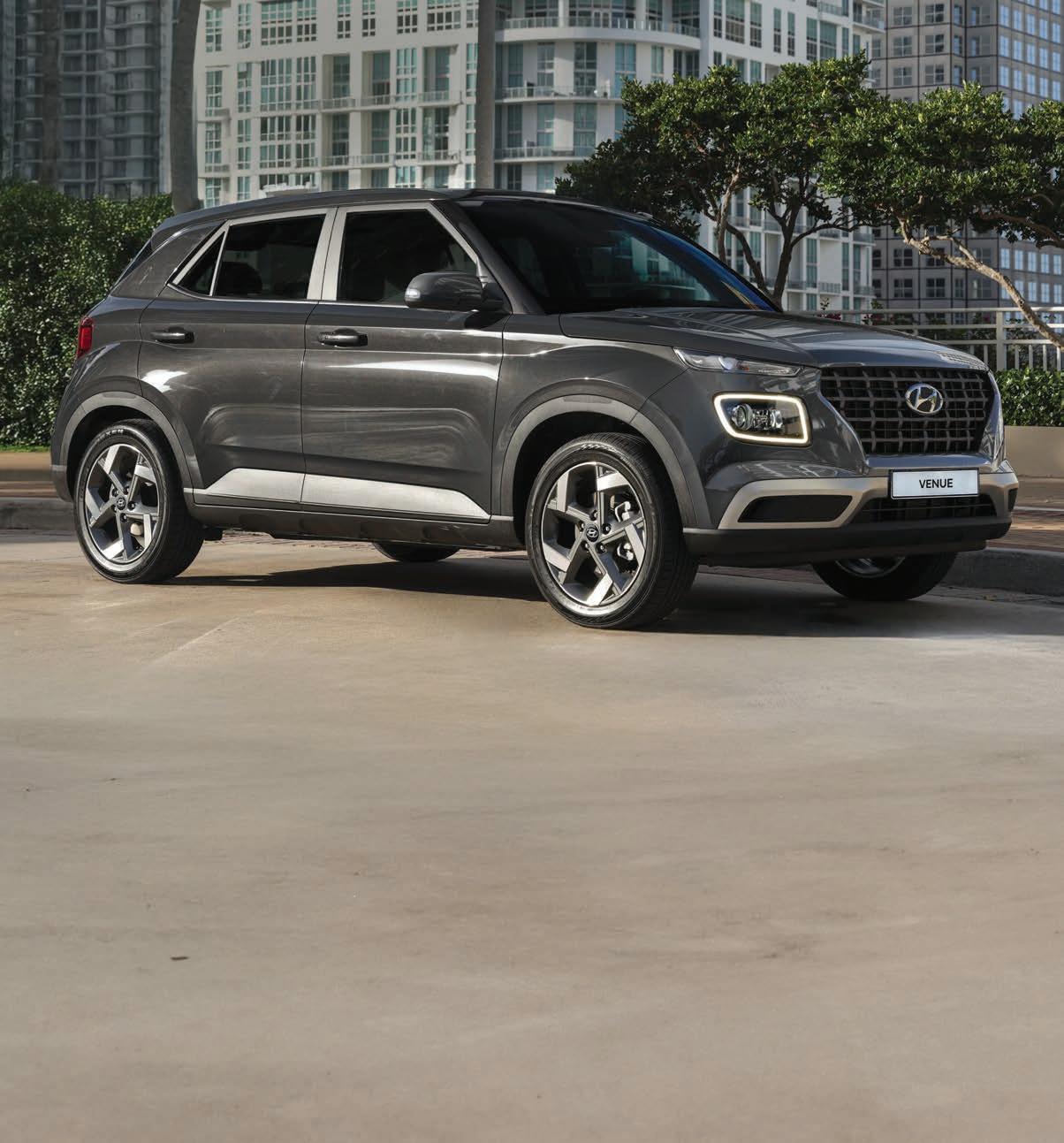
Once again entering the local automotive arena is the Hyundai Venue. Following its short stint back in 2020, the Hyundai small SUV is making a comeback with Hyundai Motor Philippines.
Serving as a gateway to the Hyundai brand experience, the Venue oozes youthful vibe with its unique exterior design. Like its bigger SUV Hyundai brethren, the Venue features bold, edgy, and muscular lines. The Venue comes with LED lighting both front and rear.
Inside, the Hyundai Venue’s dash highlights an 8-inch touchscreen infotainment system that comes with wireless Apple CarPlay and Android Auto, available across variants. Vital vehicle information is displayed via a 4.2-inch digital instrument cluster for the GLS 6AT and GL 6AT variants, while the GL Manual comes with a 3.5-inch display.
The Venue is powered by a 1.6-liter gasoline engine rated to output 123 HP and 151 Nm of torque. Power is sent to the front wheels via either a 6-speed automatic transmission or a 6-speed manual. The Hyundai small SUV also comes with Drive Mode Select as well as an adjustable traction control system.
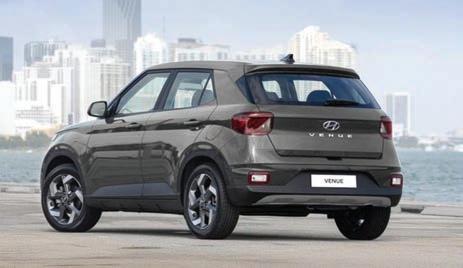
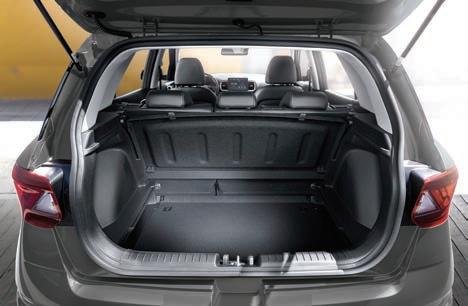
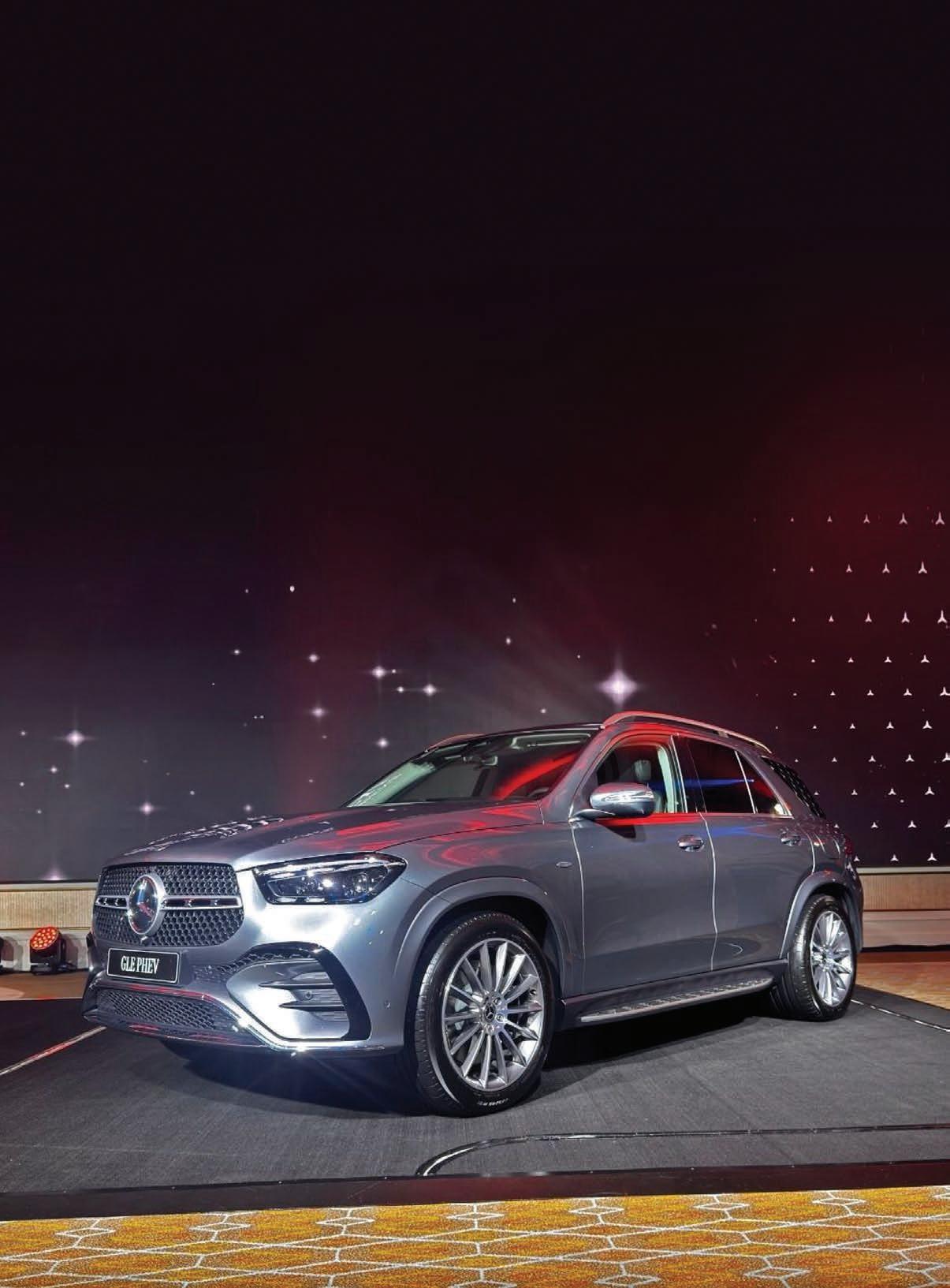
Further expanding its electrified lineup, Mercedes-Benz Philippines officially launched the Mercedes-Benz GLE 400e. The newest player in the electrified luxury segment is a 5-seater SUV that features a plug-in hybrid electric system.
Featuring an AMG Line exterior package, the GLE 400e’s commanding presence is amplified by its fascia that features a diamond grill design with the brand and a pair of multi-beam LED adaptive headlights. Its athletic stance is further highlighted by a set of 21-inch AMG wheels.
It also comes with tech features such as the latest MBUX multimedia system and driver-assist features like the “Transparent Bonnet” which helps drivers see potential obstacles during uneven terrains.
The GLE 400e is powered by a 2.5-liter gasoline engine mated to an electric motor which together produce 252 hp and 400 Nm of torque. These numbers are delivered to all four wheels via its 4Matic all-wheel-drive system. It packs an 11 kW battery that can be charged using AC outlets, allowing it to run in full electric mode of over 100 km range.
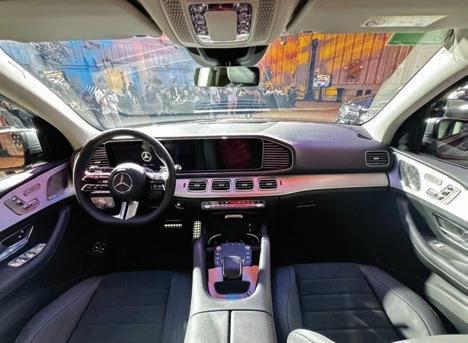
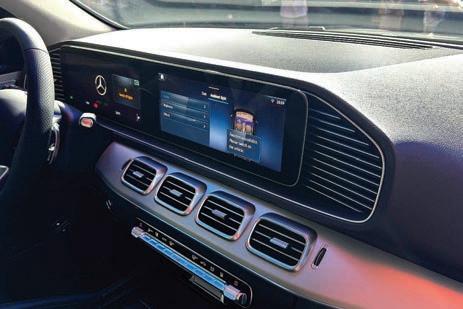
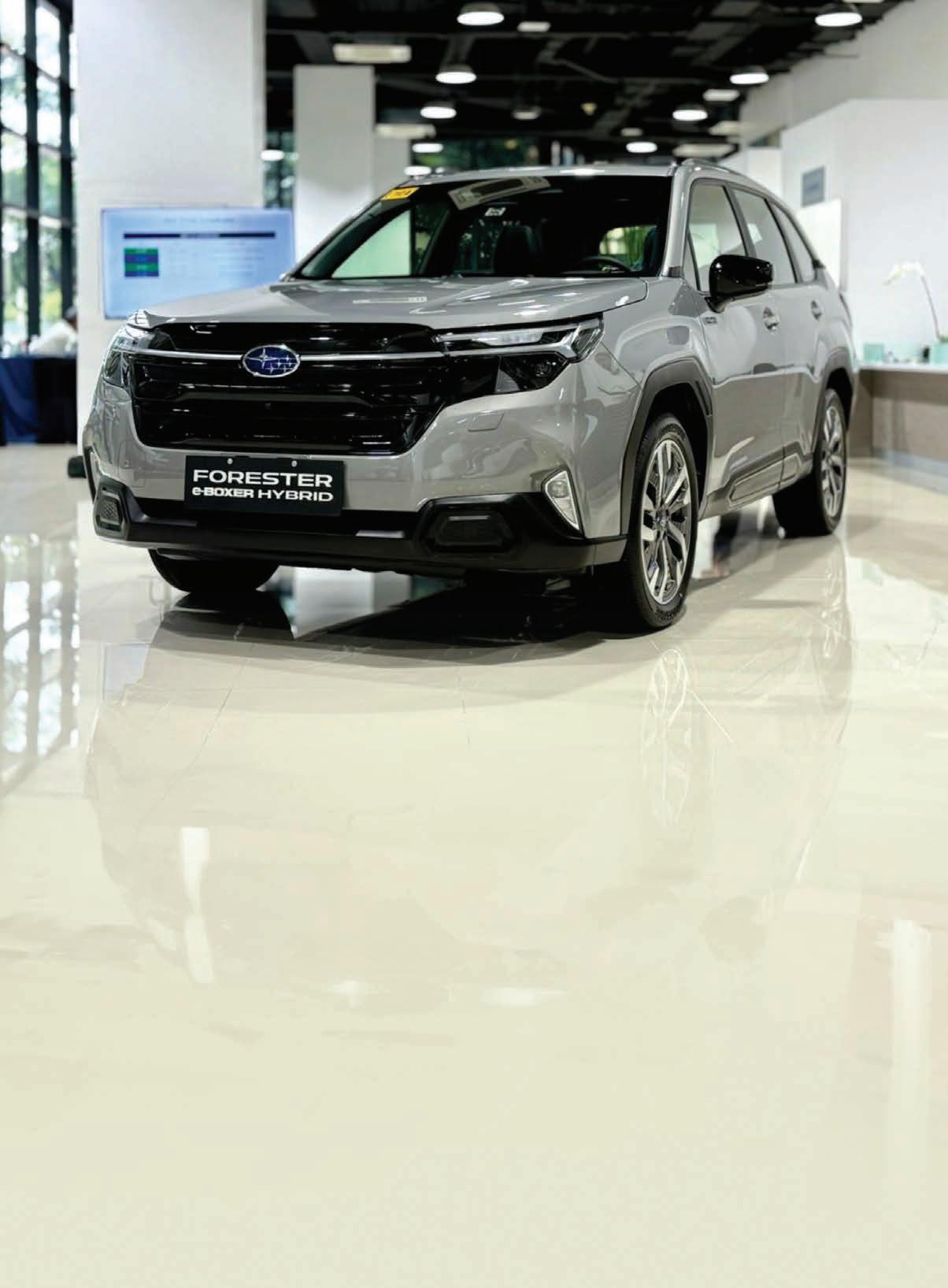
Officially joining the heated electrified segment of the local market, Subaru Philippines launched the 6th-generation Forester, now available in e-Boxer powerplant.
First unveiled to the public around Subaru fans, at the Subaru Club Philippines’ 2025 Boxer Madness, the all-new Forester is a bold step towards the growing electrified mobility movement.
The latest Forester carries the brand’s familiar characteristics of advanced safety techs, symmetrical all-wheel-drive system, and the Subaru boxer engine that has now been made eco-conscious.
The Forester e-Boxer is powered by a 2.5-liter boxer engine, paired with an electric motor that’s integrated into the CVT.
The CVT features a 6-speed manual mode, which the driver can control via paddle shifters, allowing for a more engaging driving experience. The petrol engine and hybrid system deliver a combined output of 283 hp and 485 Nm of torque.
Aside from the electrified powerplant, the new Forester features specially designed seats, minimizing fatigue. It also comes with an astounding 11.6-inch full HD infotainment system with wireless Apple CarPlay and Android Auto. As for safety, the Forester e-Boxer comes with the latest Subaru EyeSight 4.0 suite of safety driver-assist features.

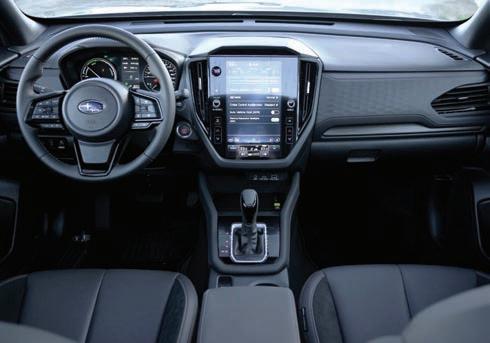
Pioneering the small vehicle segment in the Philippine auto market, Suzuki Philippines further strengthened its lineup with the allnew Suzuki Fronx. Suzuki’s small SUV contender aims to edge its competition with its hybrid electrified powerplant option.
The Fronx features an exterior design with rugged appeal mixed with coupe-inspired lines. First that will be noticed is the pair of splitstyle LED headlights and its large grill that adds to the fascia’s robust vibes. Furthering its SUV appeal are the bulging fenders highlighted by its blacked out over fenders on all fours.
Inside, it features a dual-tone black and burgundy interior. The higher trims GLX and SGX feature leather-wrapped door trims and a 9-inch touchscreen infotainment system with Android Auto and Apple CarPlay connectivity. Unique to the SGX’s interior are features like the 360-degree view camera and wireless device charger. The entry-level GL, meanwhile, gets a 7-inch touch screen head unit.
Powering the Suzuki Fronx is a 1.5-liter engine that delivers 103 hp and 138 Nm of torque. This is mated to either a 4- or 6-speed automatic transmission, depending on the trim. As hybrid models, the GLX and SGX trims get an enhanced K15C Dual Jet 1.5-liter engine with a 12V hybrid system, which registers 99 hp and 135 Nm.
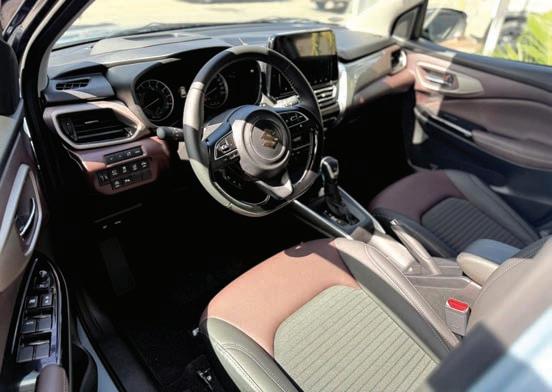


Last September 20, 2025, Honda Foundation, Inc. (HFI) proudly participated in the Sta. Rosa City Environment and Natural Resources Office (CENRO)
International Coastal Clean-up Day celebration. A cleanup activity was held in Barangay Caingin, Sta. Rosa, in an effort to highlight the value of environmental stewardship and the negative impacts that negligence may have on marine biodiversity and human health. These include but are not limited to habitat destruction and biodiversity loss.
The coastal clean-up covered the shoreline areas of Laguna de Bay, the Philippines’ largest freshwater lake, which serves as a vital source of livelihood for many fisherfolk and a habitat for diverse fish species. In attendance were over 2,000 volunteers from various government offices, private companies, schools, organizations, and volunteer groups. By the end of the day, participants successfully collected and segregated a total of 12,231 kilograms of coastal debris. This was then transported to a San Pedro dumpsite for proper disposal.
HFI encourages every Filipino to join in protecting waterways and natural resources to ensure a cleaner, healthier, and more sustainable environment for generations to come.
Members of HFI are Honda Philippines, Inc. (HPI), Honda Cars Philippines, Inc. (HCPI), Honda Parts Manufacturing, Corp. (HPMC), and Honda Trading Philippines Ecozone, Corp. (HTPE).
HFI was represented by a team of representatives per member group, led by HTPE President, Mr. Seiki Futagoishi. To learn more about HFI, contact (02)-8581-6700 to 6799 and 0917-578-8723.

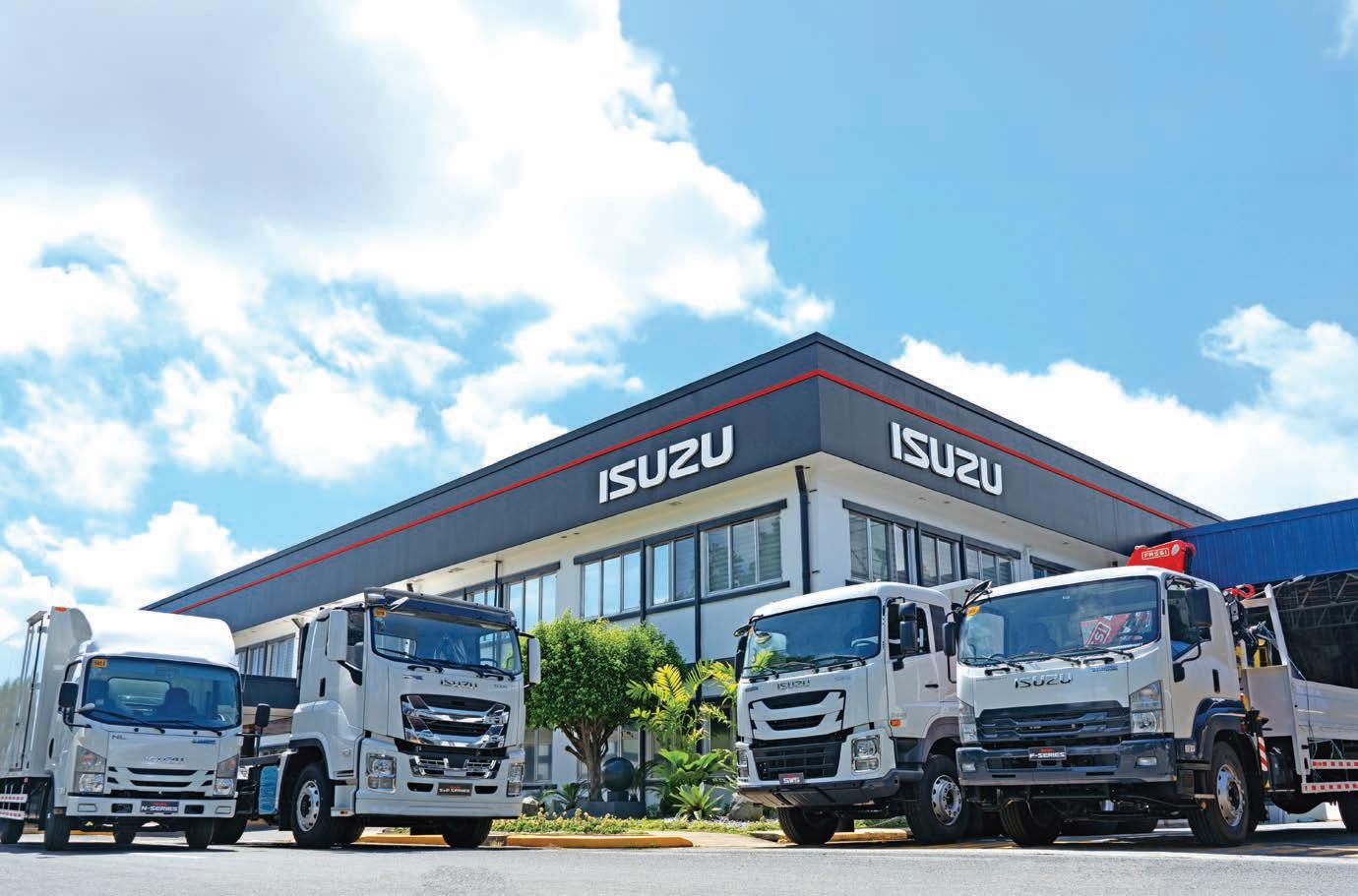
Isuzu Philippines Corporation (IPC), reports significant market share growth across truck categories III to V in January to August of 2025 compared to the same period last year, based on the combined sales report from the Chamber of Automotive Manufacturers of the Phils., Inc (CAMPI) and the Truck Manufacturers Association, Inc. (TMA). IPC retained its position as the overall market leader with a commanding 42.7% market share.
With 3,200 total truck units sold of August 2025 compared to the previous 2,912, IPC achieved a 10% yearon-year increase in sales, underscoring the continued trust of Filipino businesses and consumers in the brand.
Category III light-duty trucks emerged as the top-performing segment, with 1,934 units sold or 42.9% market share. This is driven by its Isuzu N-Series, the preferred choice for logistics and distribution businesses nationwide. Known for its powerful engine, robust build, and driver-friendly features, the N-Series continues to be the benchmark in light-duty
“We at Isuzu Philippines are honored by the support of Filipino businesses and individuals, which reflects the trust we’ve built through our dedication to delivering the best customer experience—from sales to aftersales. The growth for each segment, from light-duty, mediumduty, to heavy-duty trucks, demonstrates our mission to provide reliable mobility solutions tailored to the diverse needs of our customers,” said IPC President Mr. Mikio Tsukui.
trucking. The availability of Automated Manual Transmission (AMT) enhances drivability in urban traffic and varied road conditions, while ergonomic cabin design prioritizes driver comfort—key factors in its widespread adoption.
IPC’s Category IV trucks also posted strong growth, with 998 units sold, capturing 43% of the segment’s market share—a 4.4% increase compared to the same period last year. The Isuzu F-Series remains a top choice for businesses that require dependable mediumduty solutions for longdistance transport and industrial use.
Meanwhile, Category V saw a notable 4.4% increase in market share, which accounted for 40.3% of industry sales in the heavy-duty segment, with 278 units sold. This growth, led by the Isuzu S&E series, is largely attributed to increased demand
from government infrastructure projects and large-scale logistics operations. The S&E Series offers substantial payload capacity, a robust chassis, and advanced features such as Electronic Vehicle Stability Control (EVSC) and an Advanced Instrument Cluster with Driver Coaching— enhancing both safety and operational efficiency.
Beyond product excellence, IPC’s market leadership is reinforced by its comprehensive aftersales support, helping clients maintain roadworthiness of their vehicles while minimizing operational costs and downtime.
IPC’s Nationwide Dealer Network and Parts Availability ensure uninterrupted access to essential products
and services. The Isuzu Mobile Medic provides on-site maintenance and diagnostics, while Expert Field Engineers offer technical support across the country.
IPC also invests in training programs for drivers and mechanics, promoting safe and efficient vehicle operations that contribute to long-term customer satisfaction and business success. These components support Isuzu customers throughout their ownership journey— from purchase to aftersales—maximizing vehicle usage while minimizing downtimerelated costs.
“The steady growth throughout 2025 makes us optimistic about finishing the year strong. Our continued mission to offer product excellence and customer service is our key to retaining our leadership as the country’s most trusted truck brand,” added Tsukui.
JETOUR Auto Philippines, Inc. (JAPI) has celebrated International Dog Day at Barkhaus Eastwood, where it hosted its second Annual Media Pet Day last Wednesday, August 20, 2025. The event brought together happy media pet owners, the Jetour family, and their fur babies for a memorable day dedicated to celebrating bonds and championing responsible pet ownership.
While it’s not a typical car brand event, JAPI highlights the importance of family and shows that pets, too, are treasured members of the Filipino household. This also serves as a unique platform for JAPI to honor its strong relationship with the media, extending beyond professional settings, and to connect on a more personal and meaningful level.
This year’s celebration saw a mix of familiar and new faces, both human and four-legged. guests and their pets engaged

in a series of exciting activities, fun games, friendly contests, and interactive sessions designed to strengthen the bond between owners and their furry companions. The petfriendly atmosphere of Barkhaus Eastwood provided the perfect playground for pets to socialize and for their owners to unwind and connect with fellow animal lovers.
The event underscored JETOUR’s commitment to
creating experiences that transcend the boundaries of mobility. For JAPI, the journey is not just about the destination, but about the connections we make and the communities we build along the way.
At the same time, JETOUR held a Display at Eastwood Mall, allowing mallgoers to experience Jetour’s latest lineup of vehicles up close, including the stylish Dashing series, the versatile 7-seater X70, and the rugged T2 4×4 SUV.

JAPI Marketing Director Cherry May Moreno-De Los Santos shares, “We’re so happy to see you all back and to see familiar human and furry faces, and also some new additions to the family,” she continues, “We at JAPI are proud and joyful that this event has the makings of a beloved annual tradition.
It speaks volumes about the community we are building together. Much like the lifelong relationship we humans have with our beloved animal companions, we aim for Jetour’s relationship with our customers to also be a lifelong, loving affair built on trust and loyalty.”
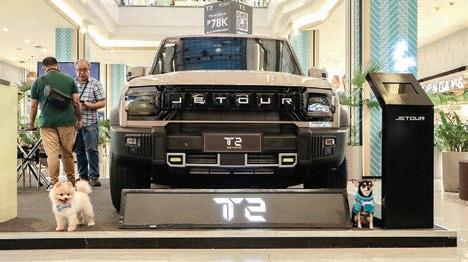
Deviating from the traditional car showcase, Lynk & Co Philippines hosted the firstever Lynk Ups at the Karrera Showroom in Alabang last August 16, 2025.
The event gathered Lynk & Co owners, guests, and members of the media, aiming to build a community centered on the Lynk & Co lifestyle. Staying true to the brand, the inaugural Lynk Ups exudes the brand’s young, energetic, open, and inclusive vibe.
More than just technical talks, the event featured lifestyle talks and networking opportunities. Without discussing spec sheets and technological
updates, Lynk Ups served as a venue to socialize among users and allow them to build networks with.
Prospect Lynk & Co buyers were also welcomed, giving a better glimpse into the ownership experience.
“Lynk Ups is more than just an event, it’s a movement,” said Lynk & Co Philippines Brand Head and Sales Director Timothy Sytin. “We want our community to see that owning a Lynk & Co car means gaining access to a lifestyle of innovation, inclusivity, and shared experiences. This is just the beginning of a series of gatherings that redefine what it means to be part of the Lynk & Co family.”
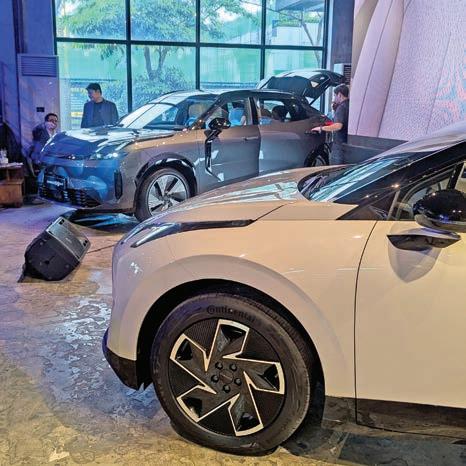

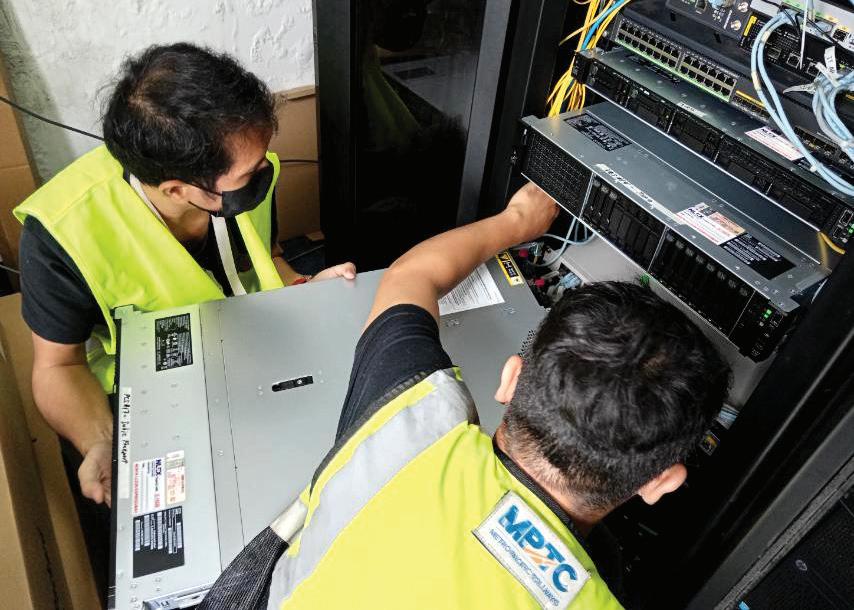
AP200-million technology upgrade is underway for SCTEX, as NLEX Corporation gears up to support a more seamless journey along the 94-kilometer expressway.
The project includes the installation of additional CCTVs and speed cameras to enhance expressway monitoring, as well as the modernization of computer systems and equipment to improve data processing and deliver a smooth and seamless travel experience
“The system enhancement program in SCTEX is essential not only for ensuring faster and smoother travel, but also for enforcing stricter road discipline. These upgrades will significantly improve the safety and reliability of the road network, boosting motorists’ confidence,” said NLEX President and General Manager Luis Reñon.
Meanwhile, beyond the technology upgrades, the tollway company has also been focusing on infrastructure improvements and maintenance of the expressway.
The annual pavement repair program for SCTEX has begun this month, while NLEX Corporation, in partnership with SCTEX owner Bases Conversion and Development Authority (BCDA), continues the repair and strengthening of the Pasig–Potrero Bridge. Routine asset maintenance activities such as tree trimming, road furniture and signage repair and repainting, and drainage cleaning are also ongoing.
These initiatives demonstrate NLEX Corporation’s commitment to improving its services and ensuring safer, more convenient travel for motorists.
NLEX Corporation is a subsidiary of the Metro Pacific Tollways Corporation (MPTC), the toll road arm of the Metro Pacific Investments Corporation (MPIC).
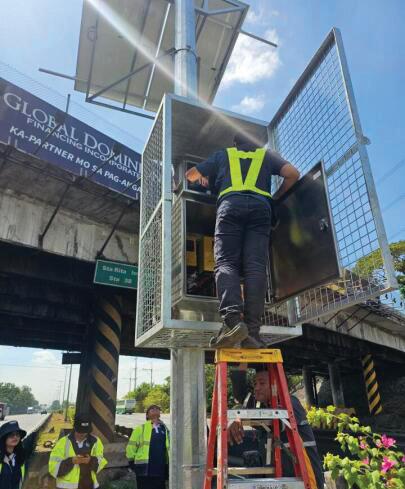
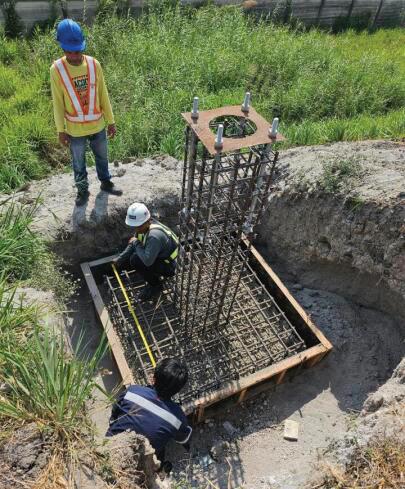

The Automobile Association Philippines (AAP) has officially verified the fuel efficiency and electric driving range of Omoda & Jaecoo models in real-world driving scenarios. Held from July 31 to August 1, 2025, AAP’s fuel economy test confirms high efficiency and extended range scores for Omoda & Jaecoo’s gas-powered and electric models.
The Chinese carmaker was tasked with fielding three test units: the JACOO J7 SHS, OMODA C5, and the OMODA E5 electric vehicle (EV). Unlike laboratory tests, the AAP program used a full driving route under actual Philippine road conditions.
The vehicles travelled at controlled speeds of 60 to 90 km/h on highways and slower speeds on provincial roads, while strictly following traffic rules. Each unit carried two passengers and two full weekend bags, with the air conditioning set at 23 degrees Celsius, simulating typical Filipino road trips.
The AAP efficiency test drive for the Jaecoo J7 SHS and Omoda C5 began at a fuel station in Biñan, Laguna, with several planned stops along the way. These included a refuel in Victoria, Tarlac, a meal break in San Juan, La Union, and an overnight stay in San Fernando, La Union. In addition, the drive concluded with another meal stop in Angeles, Pampanga, before heading back to the flag-off point in Biñan.
To maximize the Omoda E5’s electric driving range, AAP plotted the same route traveled by the Jaecoo J7 SHS and the Omoda C5, but only up to San Fernando, La Union. There, the route went through different roads in La Union. The Omoda E5’s tests ended at a charging station in Rosario, La Union.
Omoda & Jaecoo shared that the efficiency test drive faced challenges, including heavy traffic congestion in various areas, as well as intermittent bouts of strong winds and heavy rain.
Despite the challenges, the Jaecoo J7 SHS posted a commendable fuel efficiency record of 23.168 km/l, measured over a 625.2 km run. The Omoda C5, meanwhile, achieved a fuel efficiency of 14.464 km/l over a demanding 623 km route. As for the Omoda E5, the EV achieved a verified 449 km on a single full charge, surpassing its advertised 430 km range and its previous AAP-verified result of 442.7 km.
“The Jaecoo J7 SHS has unequivocally showcased its exceptional capability for long-distance travel with truly outstanding fuel efficiency, a critical and transformative factor for Filipino families and adventurers,” shared Fritz Gerald De Ocampo, Marketing Manager, Omoda & Jaeco Philippines. “Furthermore, the Omoda E5’s performance significantly exceeded expectations, establishing a new benchmark for electric range under demanding conditions,” he added.
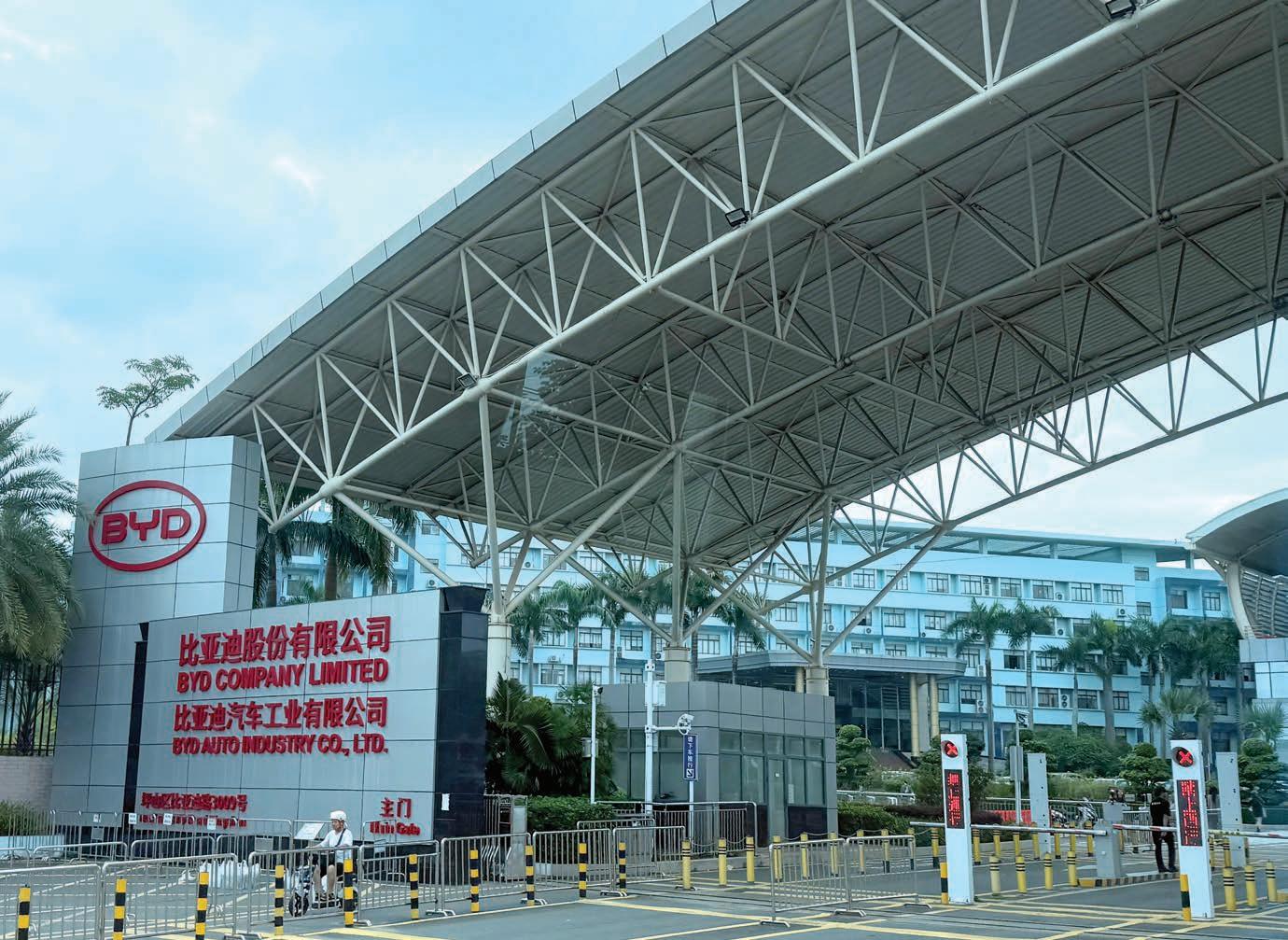
We just returned from a trip to China, our second time with BYD, where they managed to surprise us again with a lot of new innovations. This was a chance to learn and experience their new technologies that they’ve included in their latest generation vehicles.
First, we visited the BYD headquarters in Shenzen for a meet and greet with Mr. Liu Xiuelang, BYD Asia Pacific Auto Division, General Manager. After that we sat with Mr. Javy Wang, Senior Manager Product Strategy, BYD Asia Pacific Auto Sales Division for a detailed look at the new technologies in their current vehicles.
We went for a quick tour at the BYD Museum located on the ground floor of the headquarters’ main building. The displays reflect their latest innovations, which we were to see in person soon. But the one
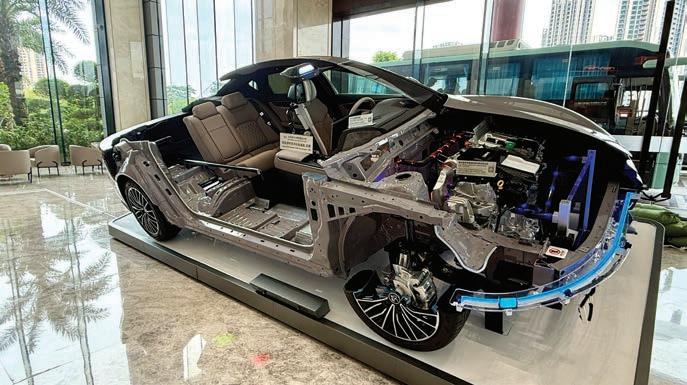


thing we looked forward to is the Lithium Ion Battery nail penetration test. This was an enclosed room where they would demonstrate the volatility of a Ternary Lithium Ion Battery against BYD’s safer Blade Battery. The explosion of the Lithium Ion battery is always frightening and impressive at the same time, showing how dangerous these are compared to BYD’s Blade Battery, whose temperature only went up to sixty degrees after being pierced by a nail.
We then took a flight from Shenzen to Zhengzhou, where we visited BYD’s DiSpace Museum. This facility is an interactive science museum which showcases BYD’s history, Technological showcases, vehicle components, has hands on activities, a look

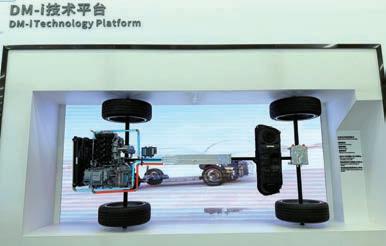

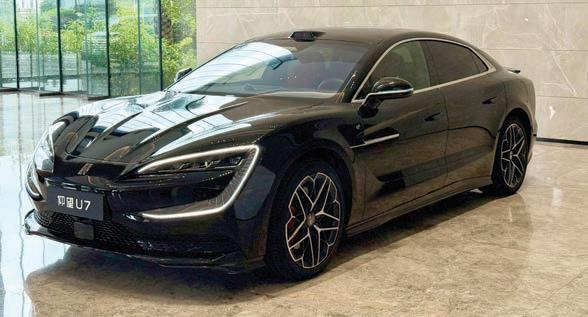
at what might be future innovations and of course development of technologies of New Energy Vehicles.
On our last day, we headed to the BYD Zhengzhou All-Terrain Circuit. This is a dedicated facility for testing and demonstration of their New Energy Vehicles’ capabilities. It opened in August of this year, and we were privileged to be the first media group from our region to visit and experience the track.
This trip was a good follow on to our first trip which happened two years ago, we were also introduced to the new brands under BYD: Yangwang, Denza and FangChengBao. Looks like exciting times ahead!
NEIL PAGULAYAN

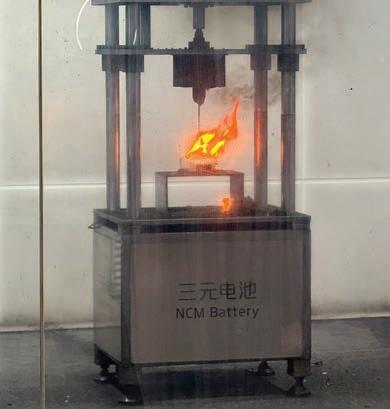
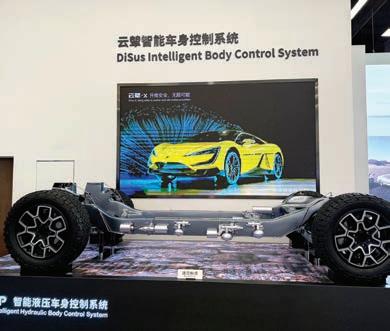
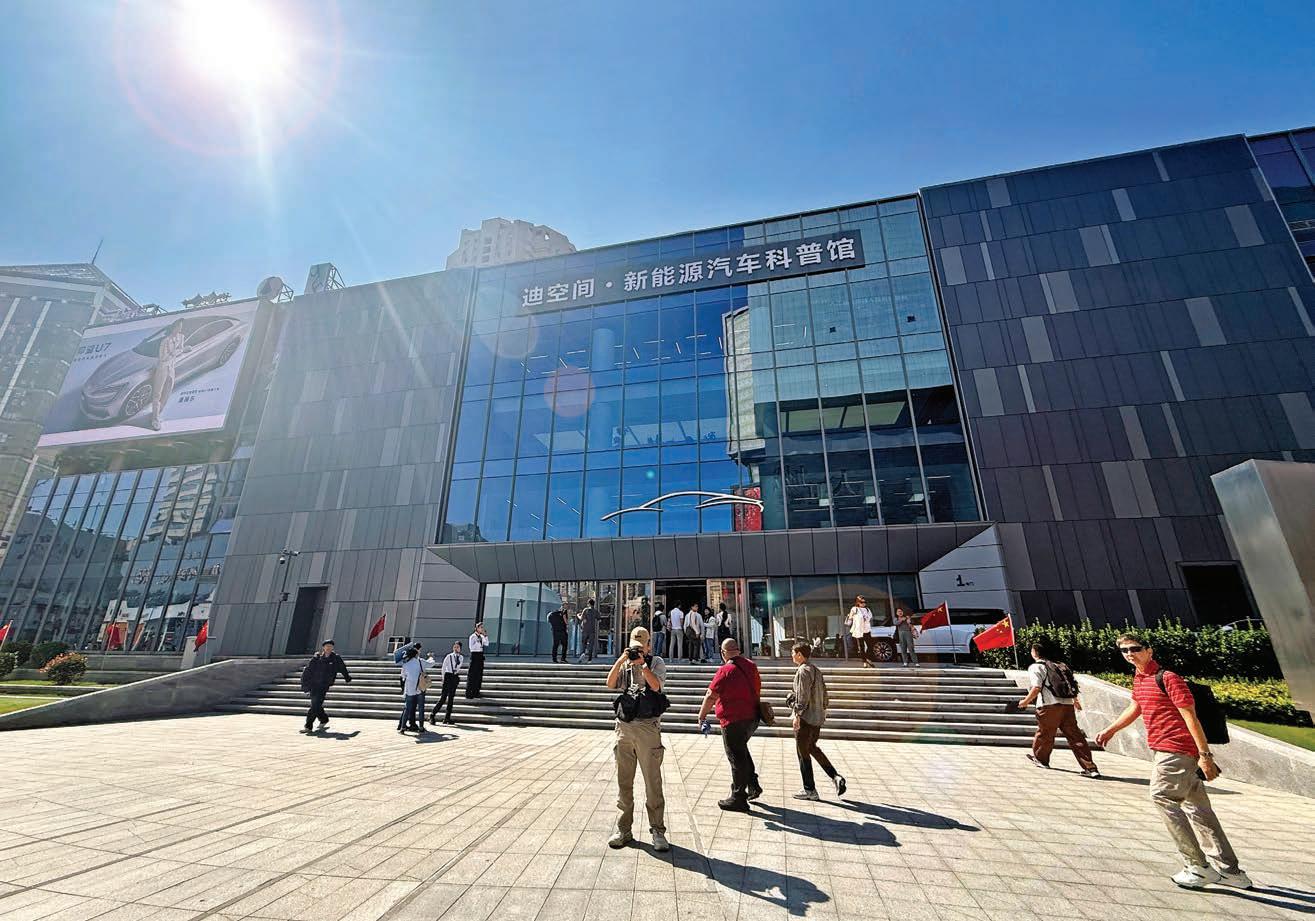
uring our BYD tour in China, we visited the newly opened “Di Space” New Energy Science Museum in Zhengzhou—the first NEV museum in China. Since opening to the public on October 24, 2024, the museum has offered visitors an immersive experience in automotive culture, design, and technology.
The new Di Space highlights BYD’s commitment to Zhengzhou, raising the city’s profile as a prime location for the brand and NEV production. This aligns with BYD’s broader strategy to deepen offline engagement and build connections with local communities. The museum aims to provide visitors with an in-depth educational experience about new energy vehicles.
Located in Zhengzhou’s commercial district, Di Space spans roughly 15,000 square meters across four floors. Exhibits are divided into four main sections: “Brand Culture,” “Craftsmanship and Intelligent Manufacturing,” “Innovative Technology,” and “Tech Exploration.” Showcasing over 300 items, each floor offers a distinct aspect of the NEV industry.
First floor: Tracing the evolution of China’s NEV industry
From the vast exterior layout of the site, the entrance hall greets visitors with a high ceiling of illumination backdrop. There, the sign welcoming the Philippine contingent set the exciting mood. The left hall houses the history presentation, demonstrating the
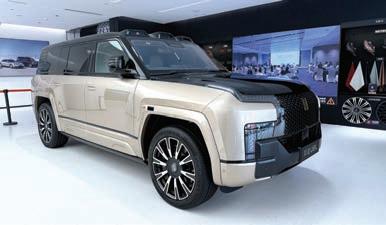
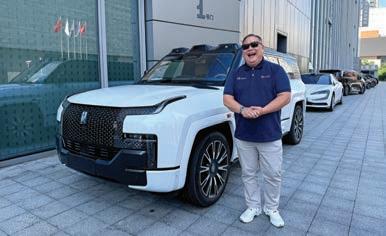

evolution of the automaker. Then on the other side is the shop displaying various brand merchandise for sale.
There is also a hall for die-cast models representing the entire BYD lineup, old and new. But, of course, the hall for the actual vehicle models was the best part, showcasing all the current lineup sold in China and other regions.
floor: Vehicle assembly and auto engineering processes demonstration
This floor focuses on robotic demonstrations that replicate key steps from a real factory. These include robotic panel stamping and molding, as well as body painting processes. Visitors can observe how robots shape the car panels and apply paint, illustrating essential phases of vehicle assembly. Additionally, there is a display of the Seal EV model, which reveals and labels internal components that are usually hidden from view.
This level presents BYD’s advanced technologies in a way that explains their purpose and function. For example, the Blade Battery is a type of battery designed for improved safety and efficiency. The fifth-generation DM-i technology combines electric and fuel power to enhance fuel savings and performance in plug-in hybrid vehicles. The DMO platform supports these innovations. The displayed “e4” technology is a system with four electric motors—one for each wheel—enabling independent control for better stability and traction. This setup powers BYD’s Yangwang U8 and U9 models.
There is also an interactive “Di Link” display, where visitors can use a large screen to explore the in-car interface, learning how users interact with BYD’s connected vehicle system. Additionally, concept technologies are presented, such as a top-mounted drone package developed with DJI. In this setup, a drone is housed in an automated pod on the vehicle’s roof, which opens to launch the drone. The drone’s controls are integrated with the vehicle’s touchscreen system, allowing the driver to operate it from inside.
This top floor offers an interactive zone where visitors or students can participate in hands-on activities. There are practical displays on sustainability, showcasing various eco-friendly energy sources, presented in dioramas or through moving projectors with illuminations. Another hall is for 3D screen presentations and is designed for guests to have photo sessions. Another interesting presentation is
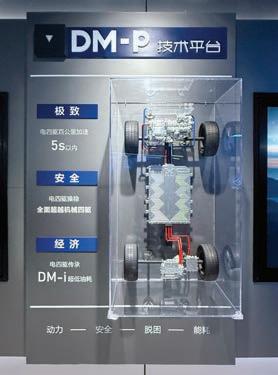
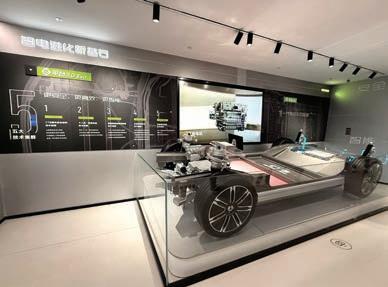
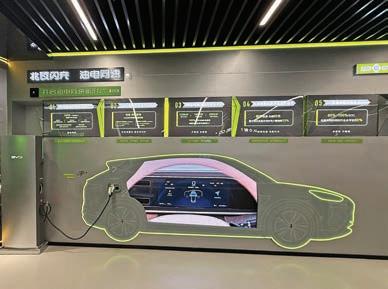
the hall of floating plastic balls, which demonstrates its ability to form various shapes of models, highlighting its aerodynamics. To cap off the tour, there is a café area where visitors can relax while feasting their eyes on the Yangwang U8 and U9 on display.
Beyond permanent displays, Di Space features an 8,500-square-meter outdoor plaza and a 360-square-meter indoor event venue. These spaces are for hosting BYD product launches, pop-up exhibits, and other live activities.
With Di Space, BYD aims to inform the public and advocate for the NEV industry. As NEV adoption rises in China, brands are boosting offline outreach to connect with consumers and highlight NEV benefits. BYD describes Di Space as supporting Zhengzhou’s profile in the brand and NEV sector.
RANDY PEREGRINO
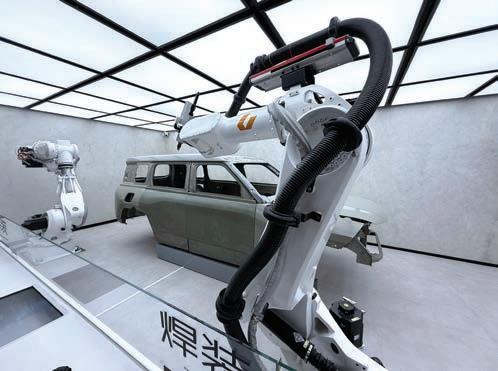

Getting first dibs on a new facility is rare for us, but this time, we were privileged to be the first media group from our region to visit the Zhengzhou All-Terrain Circuit which opened in August of this year. This facility is the first of it’s kind specifically made for BYD’s New Energy Vehicles.
It has several zones, Indoor Sand Dune, Low-Friction Ring, Kick-Plate, Wading Pool, Dynamic Paddock, Race Track and an Off-Road Park. The facility offers areas that test the different features of BYD’s line up.
After a safety briefing, our large group split into two smaller groups. Our first stop was the Indoor Sand Dune, it’s a 29.6 meter tall “sand dune” at a 28 degree incline. It has 6,200 tons of sand and is certified by the Guinness World Record as the highest and largest dune climbing facility for vehicular testing. BYD test drivers demonstrated the ability of the Yangwang U8 SUV to easily handle the loose sand up and down the slope.
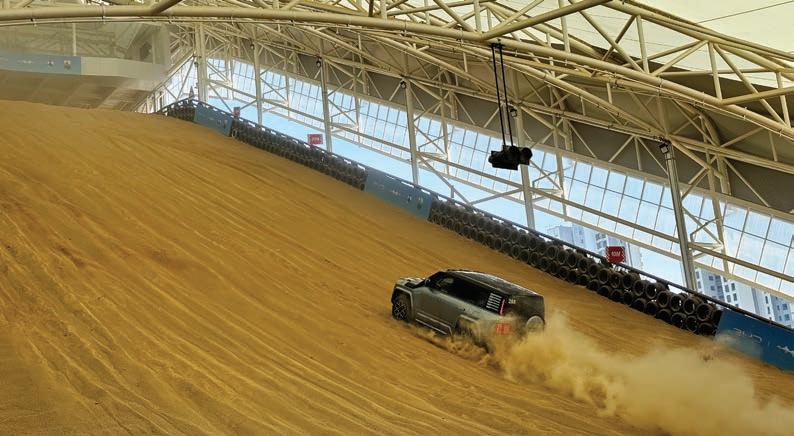

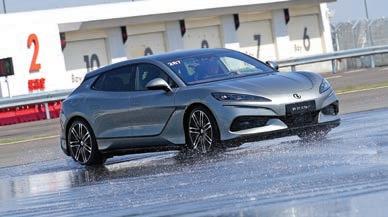
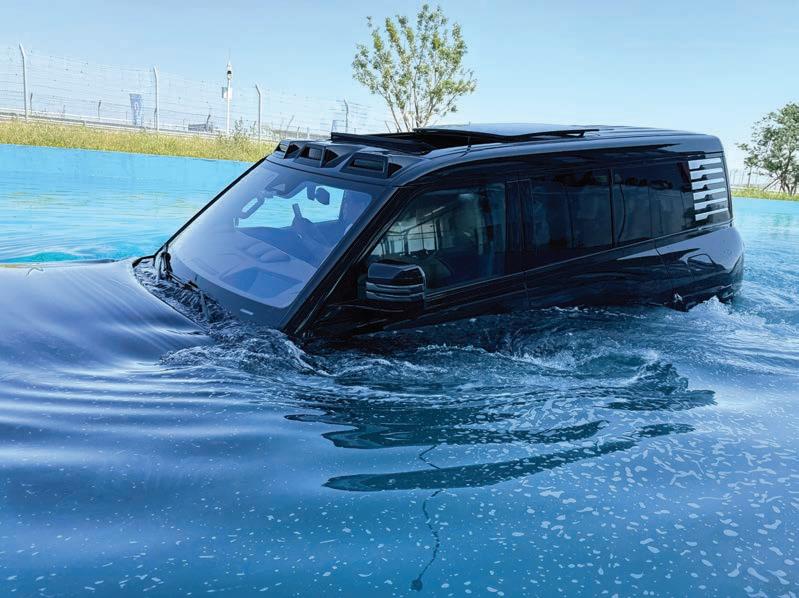
Our next stop was essentially a large swimming pool that you could drive into. The Wading Pool is seventy meters long and about two meters at its deepest, it can simulate floods and river crossings to test the water proofing of electric motors and batteries. This time, they used it to show us how the Yangwang U8 can do water crossings and can stay afloat and water tight for about thirty minutes.
This fourty four meter diameter circular track lined with a smooth surface and a sprinkler system that can maintain 3mm of water on the surface which ensures it has a constant friction similar to that of ice and snow. This was where we had fun using the drift mode of the Denza Z9 GT. And at the same time show that BYD’s intelligent body control can help maintain traction.
This area is for simulating grip loss and also taking evasive maneuvers on a slippery surface. Here we experienced the BYD Song L EV’s handling as it was driven onto the wet surface where it lost grip, regained traction and went around simulated walls.
This large open rectangular area is 15,300 square meters of asphalt, perfect for gymkhana. All that’s needed are a few cones and you’ve got yourself a course than can put handling and braking to the test. We got to try a different vehicles here, the Seal, Tang DM-I and BYD eMAx 9.
This is a 1.758km high speed race track, with nine corners, this may seem short on paper, but when we got to take a “taxi” ride in the Yangwang U9, the straight allowed us to get upto almost 200 kilometers per hour.
Located behind the indoor sand dune is for off road enthusiasts, this area has features that put the BYD SUV’s offroad capabilities to the test, but without the dirt and mud. Manicured grass, hills and engineered undulations in cement mimicking different off-road terrain situations makes for all weather offroad fun. This was where we got to try out the premium mid-sized
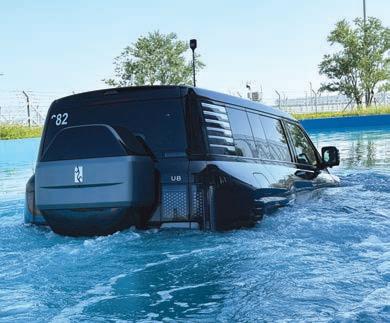

All in all, it was a fun day at BYD’s Zhengzhou All-Terrain Circuit, we would have wanted to stay longer, and spend more time with the vehicles, especially the Yangwang U9. This facility is perfect, allowing one to be able to put BYD’s New Energy Vehicles through their paces, both for product development and perhaps even for customers to see how BYD vehicles’ features work in a controlled environment. Usually the work of testing vehicles is serious stuff, but when you come to a place like this, driving vehicles with advanced technologies, you can’t help but imagine how much fun this can be.
NEIL PAGULAYAN
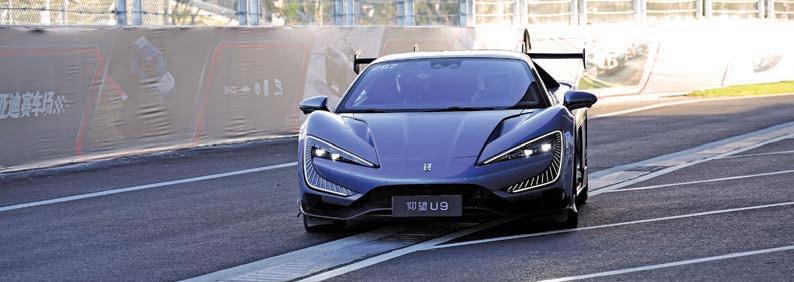
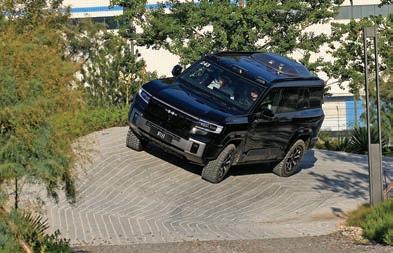
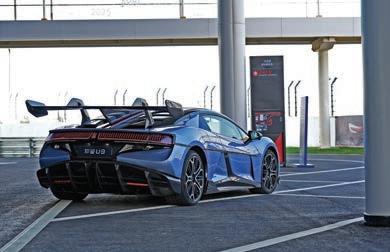

Cars are getting more technology integrated into them, meaning there are more things we should we should be aware of, and with that lots of new words and terminology about the bits and pieces that make it go and stop. But now there’s more than just that, a lot more.
DM 5.0 - DM-I, DM-O and DM-P
Does this look familiar? It’s part of BYD’s nomenclature for their Plug-In Hybrid family of vehicles, the prefix DM means Dual Mode, their hybrid system, which commonly puts an internal combustion engine (ICE) with an electric motor, which can run in full electric, hybrid and assist modes. The suffix, -i,-O and –P are indicative of different applications.
DM 5.0
DM is now in it’s fifth generation, was launched in 2024 and under hybrid conditions claims to be able to attain100 kilometers of distance driven for every 2 liters of fuel consumed.
DM-i
This might sound familiar, DM-I made its Philippine debut with the Sealion 6. Used to denote efficiency and economy, the general application is an ICE unit acting predominantly as a generator in concert with an electric drive system.
The electric motor is the primary drive and the gasoline engine engages when the battery’s state of charge drops. But during times of extended operation, like on an expressway, the engine can run to supplement the power needs of the electric system. The powerplant is mated to a Dedicated Hybrid Transmission (DHT) or e-CVT. DM-I is not intended for highspeed or quick acceleration, but the more for fuel economy and lower emissions ideally for city driving and are configured for front wheel drive and ideal for lower cost applications.
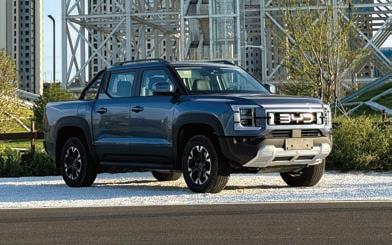
DM-O
This architecture made its Philippine debut in the Shark 6 pickup, DM-O or Dual Mode Off-road, is their off-road hybrid system for use in rugged terrain optimized for demanding conditions like uneven surfaces, traction and load while still being efficient. BYD claims substantial savings on fuel cost compared to pure ICE off-road vehicles.
You can have as many as four motors, enabling precise torque delivery to each wheel. The Shark 6 DM-O has dual motors and a 1.5L gas engine as an example. BYD’s Cell-to-Chassis is where the bettery pack integrates with the chassis adding to rigidity and can also include DiSus, aloowing intelligent body control to help manage chassis and vehicle motion on challenging terrain. DM-O is touted to deliver high torque and sufficient power for off-road and heavy duty use.
DM-P
This is the new architecture we got to experience hands-on in China during a ridealong in the Yangwang U9. DM-P is BYD’s performance architecture, prioritizing higher power output and quicker response over fuel economy. It too offers multiple electric motor configurations from front and rear, to four motor, all-wheel drive.

And the combined ICE and electric motor output is much higher compared to the DM-I and DM-O. This hybrid setup is tuned more aggressively, and with this, the ICE and electric combo works in parallel during high speed and load conditions. Of course, the trade off for performance is fuel economy and the added complexity in the drivetrain due to motors to manage and control systems.
The E3 platform is a world first, this three electric motor drivetrain places one motor in front and two motors in the rear, for differential torque where it actively adjusts both torque and rear wheel steering to maintain stability on surfaces with low grip. It also offers enhanced steering, enabling the ability to “crabwalk” for limited diagonal movement and “compass turn” to maneuver in tight spaces. The E3 platform also utilizes “Cell-to-Chassis” for vehicular rigidity and stability.
With stability and safety enhanced, high speed tire blowouts are less likely to be fatal when you combine the E3’s rigid structure which works with instantaneous adjustments of wheel torque to correct and maintain vehicle stability, this also helps shorten stopping distance by providing rapid stabilizing control during braking. This works with the ADAS system using lane/line recognition to prevent secondary accidents. An E3 platform vehicle can also be equipped with adaptive suspension to enhance stability and ride comfort. We had a chance to experience the E3’s abilities when had a chance to drive the Denza Z9 GT.
The E4 platform takes everything that the E3 has, but now has a quad-motor drive system with four independent systems, drive, power, braking and steering. This offers more adanced compass turning and intelligent crab walking. E4 is implemented in the Yangwang U8 and U9.
DiSus-P
This is BYD’s intelligent hydraulic body control system which can adjust a vehicle’s height and suspension stiffness for improved on-road handling and off-road performance. This is applied to an E4 platform vehicle, the Yangwang U8 SUV, allowing it superior suspension travel and enabling it to turn like a tank.
DiSus-X
This is the most advanced iteration of BYD’s DiSus and is found on the Yangwang
U9 electric hypercar, it enables advanced body control over the vehicle’s body roll, pitch and height, improving both handling and comfort. This body control system works with the vehicle’s binocular LiDAR to identify uneven road surfaces to adjust the suspension for a smoother ride.
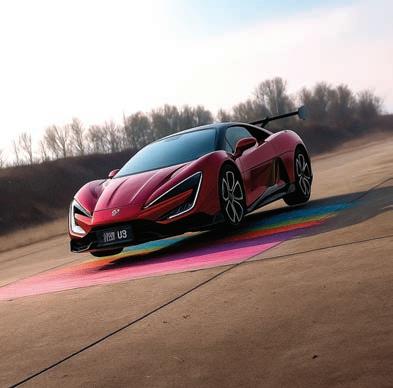
The system is now well known for it’s ability to enable maneuvers like dancing or hopping. There are videos online which show the YW U9 dancing as an example of what the suspension system is capable of. It can even cause the vehicle to jump a few inches off the ground.
The same ability allows it to drive on three wheels by adjusting the height in three corners which showcases it’s stability in emergencies. Safety is enhanced as the DiSus X can prevent rollovers and reduce physical effects on occupants during cornering at high speed and braking.
This is BYD’s advanced integrated EV platform with the following features : 12-in-one intelligent drive which features a highspeed motor, reducer, control unit, battery manager and essential components in a single unit, which increases efficiency, improving cruising range and top speed. Again, Cell-to-Body enhances rigidity increasing passenger safety by 60% in a frontal collision due to an additional 100mm buffer zone in the front compartment, 50% improvement in passenger cabin deformation resistance.
This platform also has new add-ons to its ADAS, which includes LiDAR, multiple cameras and radar systems giving it Level 2+ autonomous driving capabilities. Its also connected with improved vehicle-roadcloud-connectivity, this connects vehicles to road infrastructure and cloudcomputing
platforms in turn making intelligent vehicles safer utilizing real-time data sharing like traffic updates, road hazard alerts, over–the-air updates and map downloads, improving driver experience and autonomous driving capabilities. This platform is the basis for the BYD Sealion 7.
DiPilot 100, 200 and 300
This is BYD’s advanced driver assistance system, also known as BYD’s “God’s Eye”, this offers semi-autonomous driving capabilities offered in three levels.
DiPIlot 100 is the entry level or mass market level ADAS using a camera, radar and ultrasonic sensors. It supports Highway Autonomous Navigation (HNOA) functions - lane keeping, lane change, on ramps and obstacle avoidance. Its automatic braking works upto speeds of 100 kilometers per hour, and due to its lack of LiDAR, its confident handling of urban and complex intersections is limited compared to DiPilot 300 and 600.
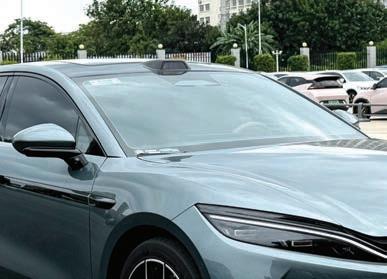
DiPilot 300 is the mid level version, its sensor suite is upgraded with a single LiDAR module added to the camera and radar system. It has advanced highway support with urban features / cities (Navigation On Autopilot - NOA), which allows for more complex maneuvers than DiPilot 100.
DiPilot 600 is the top level ADAS with three LiDAR modules plus a full sensor suite of cameras and radar for the highest perception fidelity, this tier is reserved for BYD’s top premium models. This system has the best sensor and computing system allowing for better, accurate autonomous driving especially in urban settings and in varied conditions.
As of this writing, BYD engineers are currently working on the next generation of technologies and judging by what is already available, there are some pretty exciting developments in the near future.
NEIL PAGULAYAN

The All-New Suzuki Fronx made its first appearance at the Mall of Asia earlier this year, and before it’s launch, Suzuki Philippines (SPH) recently hosted an experiential drive for the motoring media.
This drive would have a little fuel economy challenge to see how economical their latest mild hybrid offering would be through some rush hour traffic, the expressway and winding country roads. The official fuel consumption put out by the Automotive Association of the Philippines (AAP) is 27.98 kilometers per liter. Our aim was to come close to that.
According to Chief Engineer Yokohama, the design inspiration projects the strength and elegance of a thoroughbred horse, blending coupe-inspired sophistication with SUV ruggedness.
The Suzuki Fronx is sub-compact crossover SUV, but looks more like a coupe. Up front, is an aggressive fascia, with the daytime
running lights that double as signal indicators where you traditionally expect the headlights to be and the split-style LED headlights located where the fog lights are usually placed.
The tire wells have black plastic cladding and this continues around the lower edge to the back, along the way are brushed aluminum accents. The rear LED combination lights are connected by a light bar, which glows red giving it a distinct look on the road at night.
It rolls on 16-inch polished alloy wheels wrapped in 195/65 series tires. The black roofline trim is exclusive to the GL and SGX two-toned variants. Dimension-wise, the vehicle measures 3,995 mm long, 1,765 mm wide, and 1,550 mm tall. The wheelbase is 2,250 mm with a ground clearance of 170 mm.
Suzuki implemented what they call a Smart and Modern cabin design and it seats five adults. The interior is upholstered in a
combination of black and burgundy, where the seats are also a mix of these two colors, synthetic leather and a cloth like material. The door trims and dash have a mix of hard plastics and soft touch materials. The rest of the cabin is trimmed in piano black and a mix of gloss and brushed aluminum finish. The steering wheel is leather wrapped with controls for the infotainment, hands free telephony and cruise control with related settings.
It was refreshing to get behind analog speedometer, tachometer, temperature and fuel gauges. Typical of a Suzuki layout, but this time you get a colored 4.2” MultiFunction Information Display (MFID) set between the tach and speedo. You get single zone climate control, and rear occupants get air conditioning vents in the center console with two USB charging ports.
The variant we drove, the top of the line SGX was also equipped with a large heads up display which had different display modes. The six-speaker infotainment system has a large 9” touch screen, which shows vehicle status, supports bluetooth music and telephony,
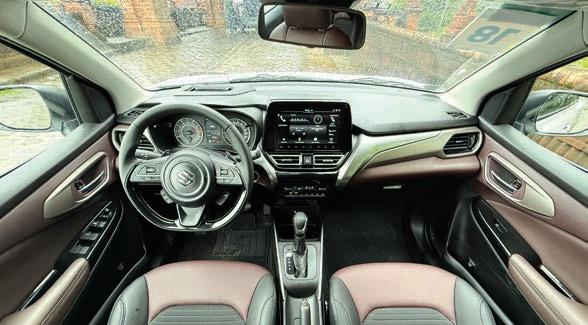
and wireless Apple CarPlay and Android Auto. This also serves as a sizeable screen for the 360-degree camera. There’s wireless charging for Qi compatible smartphones, wired connectivity through a USB A socket and there’s still a 12V power socket.
Suzuki gives you 304 liters luggage space and 605 liters with the second row seats folded forward.
The Fronx SGX variant features a mild hybrid powertrain, a 1.5-liter K15C gasoline engine plus a 12-volt hybrid setup, mated to a sixspeed automatic transmission (6AT). Power output is 99 hp and 134 N-m of torque. The belt-driven Integrated Starter Generator (ISG) adds 2.2 kW to assist the engine, drawing electric power from a 12-volt lithium-ion battery.
Working as a power assist electric motor, the ISG generates additional power and torque during acceleration, in addition to acting as the conventional alternator. Suzuki refers to it as the Torque Assist Function. In this case, the ISG helps the engine via a rubber belt.
Exclusive to the SGX variant is the Suzuki Safety Support Technology, the brand’s version of ADAS (Advanced Driver Assistance System), which is a set of electronic features that help the driver with tasks like braking, steering, and monitoring blind spots. This suite of advanced driver-assist features is Dual Sensor Brake Support II (DSBS II), Adaptive Cruise Control, Blind Spot Monitor, High Beam Assist, Lane Departure Warning and Prevention, Lane Keep Assist, and Rear Cross Traffic Alert.
Standard features are six airbags (driver, passenger, curtain, and side), Electronic Stability Program (ESP), Anti-lock Braking System (ABS) with Electronic Brakeforce Distribution (EBD), Hill Hold Control, and rear parking sensors with a camera.
Our start point for the drive and the fuel eco run, was Suzuki Auto Kalookan, and we made our way to the NLEX with full tanks of gas, head to our lunch venue at Mesa
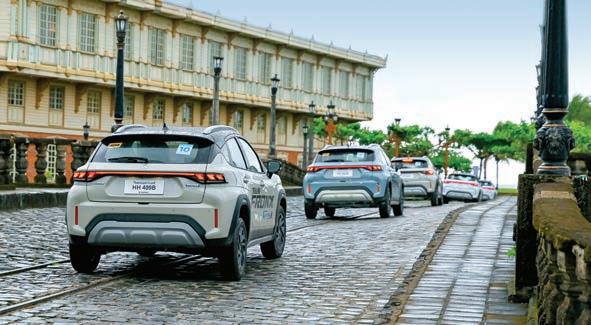
Feliz in Bataan, via SCTEX and exiting at Dinalupihan. We decided to drive as we normally would, on a road trip so we could get an accurate reading as to the real-world fuel efficiency of the Suzuki Fronx’s mild hybrid system. Air conditioning was set on a comfortable temperature and to go with flow of traffic.
After lunch we headed to Pilar Diwa, where we would top up our gas tanks to find out much fuel we consumed on this drive, then proceeded to the Pawikan Conservation Center at a beach in Morong, where our friends from Suzuki Philippines would hold a CSR activity.
We were pleasantly surprised to learn that Suzuki sponsored, on behalf of, and in the names of the publications present, a clutch of sea turtle eggs, each. These are expected to hatch sometime in October, and would be released into the sea. Our hosts also donated a 3-door Suzuki Jimny to the Pawikan Conservation Center. After all that, we proceeded to where we would spend the night, at the Las Casas Filipinas de Acuzar, also in Bataan.
At the end of a fun day on the road, we learned our fuel consumption figures for the 161 kilometer drive (from the dealership to the gas station at Pilar Diwa). The most economical car scored 22.89 kilometers per liter, and our score at 5th place, was 21.16 kilometers per liter which was pretty close, and not too far off AAP’s 27.98 kilometers per liter official fuel consumption. Considering we didn’t try to be economical, our result was still pretty good. Overall, the
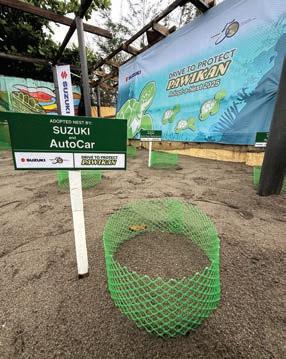
least economical in 19th place was 15.77 kilometers per liter, which is still quite good.
Randy: The mild hybrid powertrain is responsive and eager to rev. The Torque Assist Function stands out with noticeable acceleration from a stop, as the extra push from the ISG mimics a larger engine. This demonstrates the system’s goal: achieving fuel efficiency by lowering engine load at acceleration.
The vehicle was also well-planted and stable at high speeds. On zigzags, the car was nimble with good steering feedback. Downshifting in lower gears squeezes more torque from higher engine rpms during climbs and overtaking.
Neil: The All-New Suzuki Fronx was fun to drive, it has spacious interior, has all the amenities you need and looks quite good too. it’s mild hybrid powertrain was both economical and didn’t lack power on the open road. It handled the twisties in Bataan with aggression and minimal body roll, and with good steering feel. I especially liked that the Fronx has a proper handbrake, and that they still included a hard tonneau cover.
The pricing for the Fronx are as follows: GL AT P1,059,000, GLX AT Hybrid P1,219,000, GLX AT Hybrid Two-Tone P1,229,000 and the top of the line SGX AT Hybrid Two-Tone variant we drove is priced at P1,299,000. It looks like Suzuki Philippines got it right again, and the Fronx is a strong contender for the subcompact crossover suv segment.
NEIL PAGULAYAN AND RANDY PEREGRINO

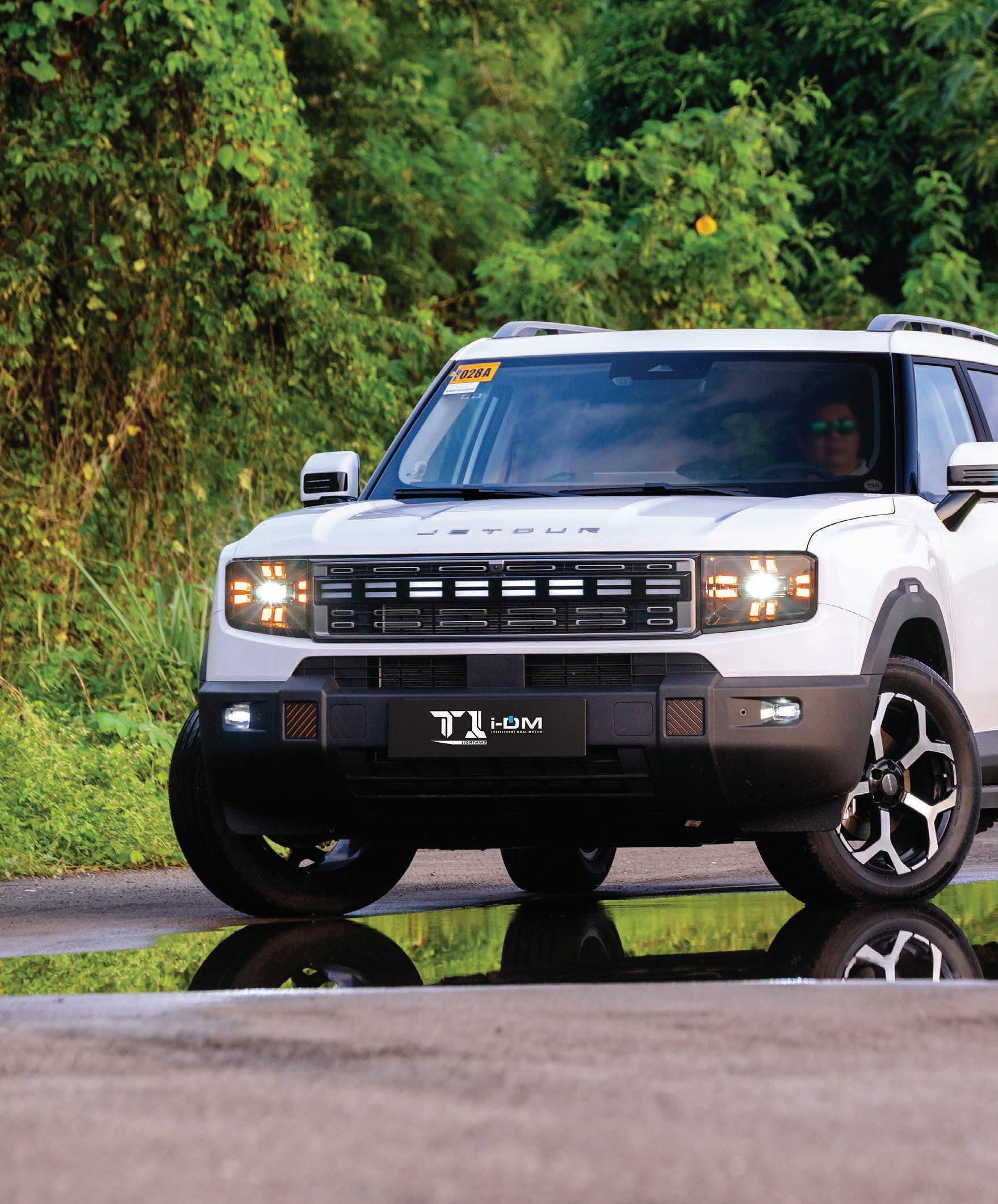
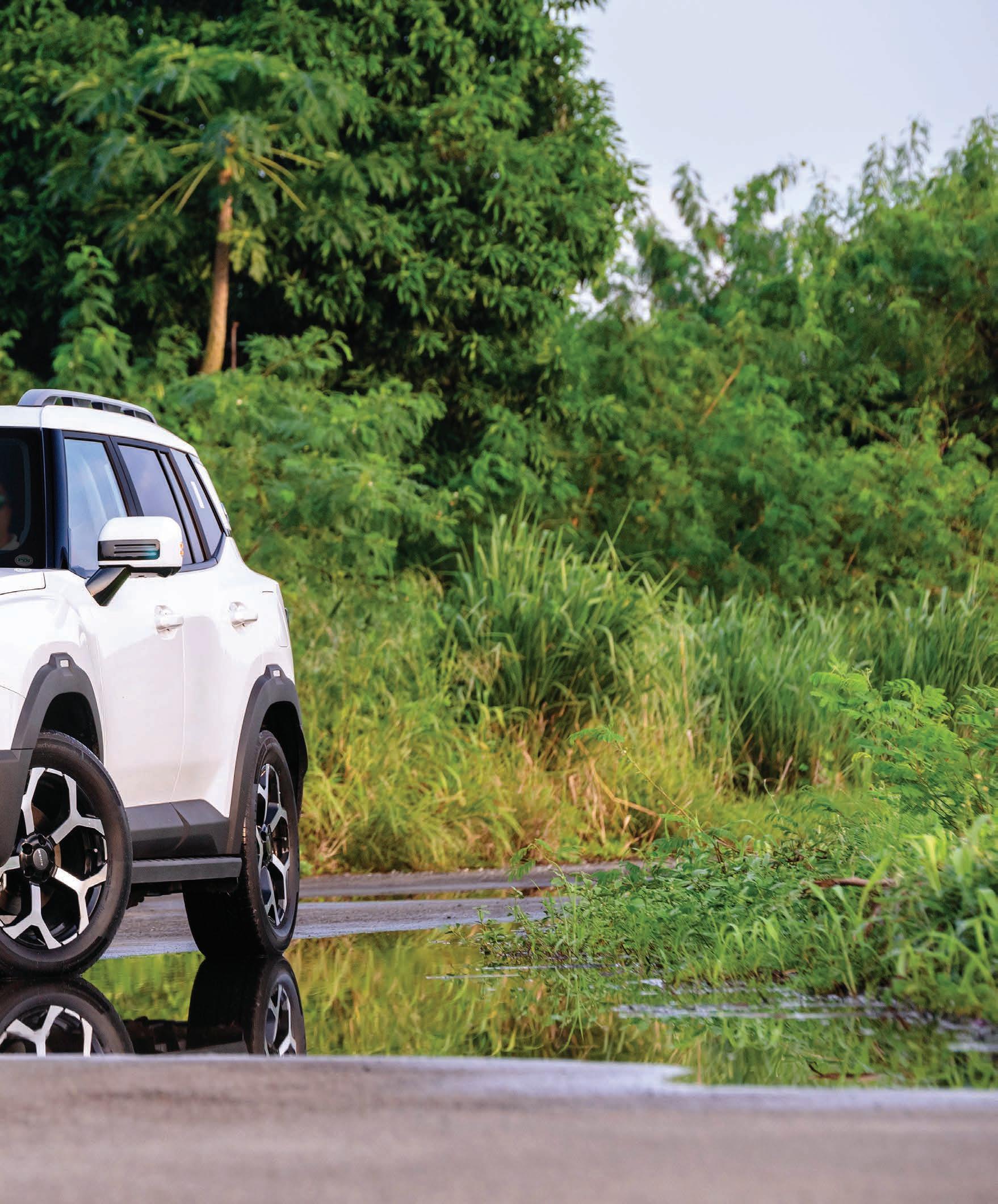
ETOUR Philippines is ramping up its electrified lineup, particularly the plugin hybrids (PHEV). The JETOUR T1 Lightning i-DM is the newest addition to the brand’s growing roster in the country. Yes, the T1 i-DM is the T2’s smaller sibling and shares the same platform. JETOUR’s newest compact crossover SUV is tagged as “The Power of One” because of its smart features, robust build, and sustainable powertrain, all you need in one vehicle. Moreso, its new rugged design aesthetics denote the kind of design that combines urban and off-road stylings.
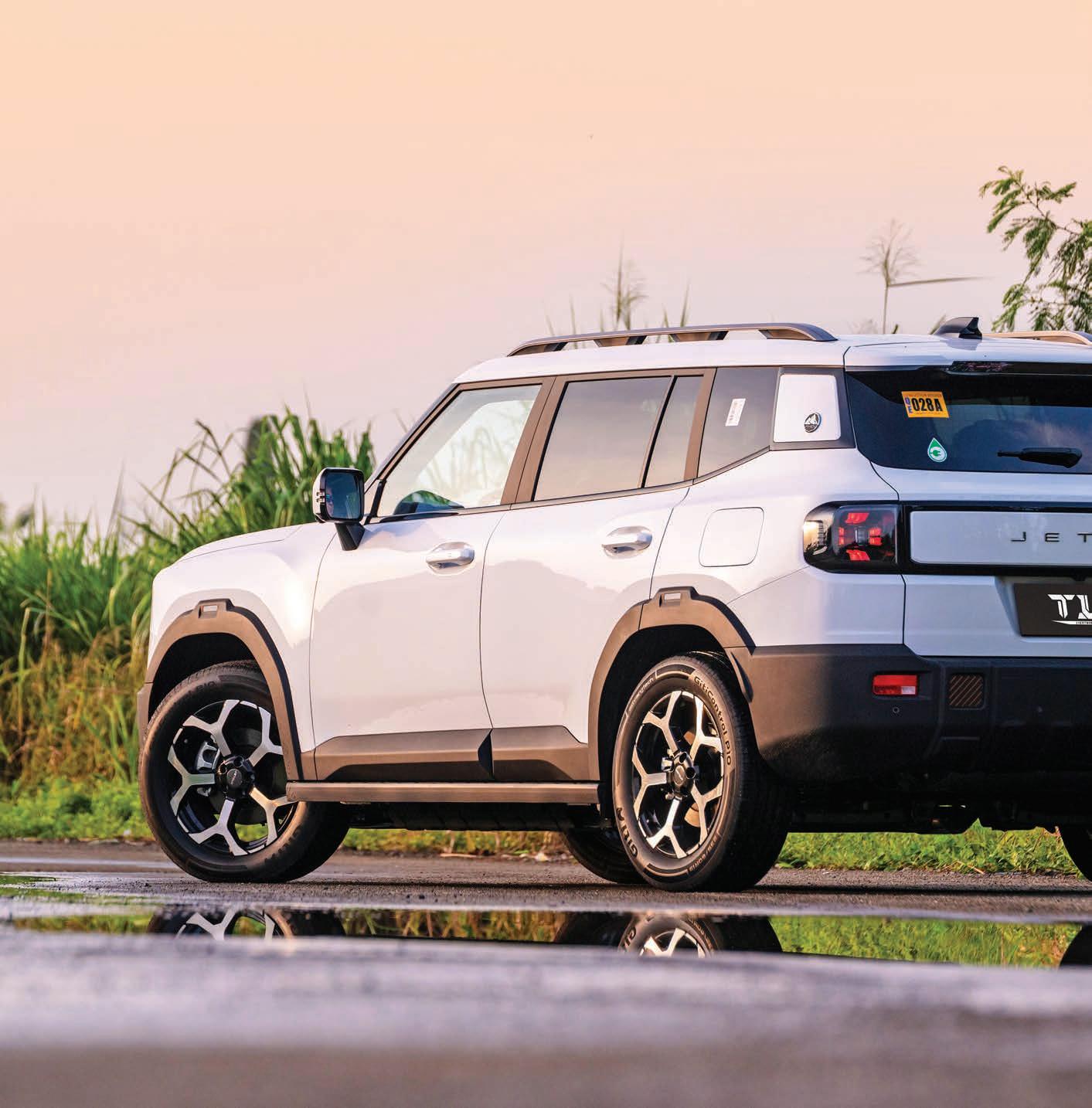
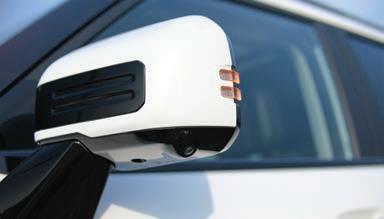
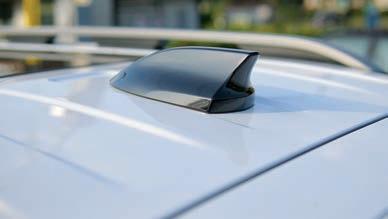
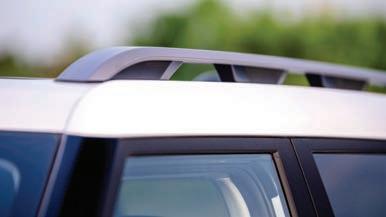

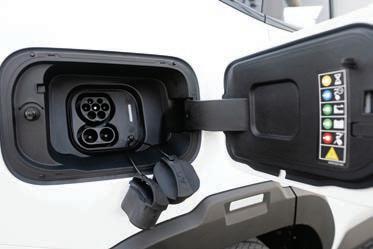
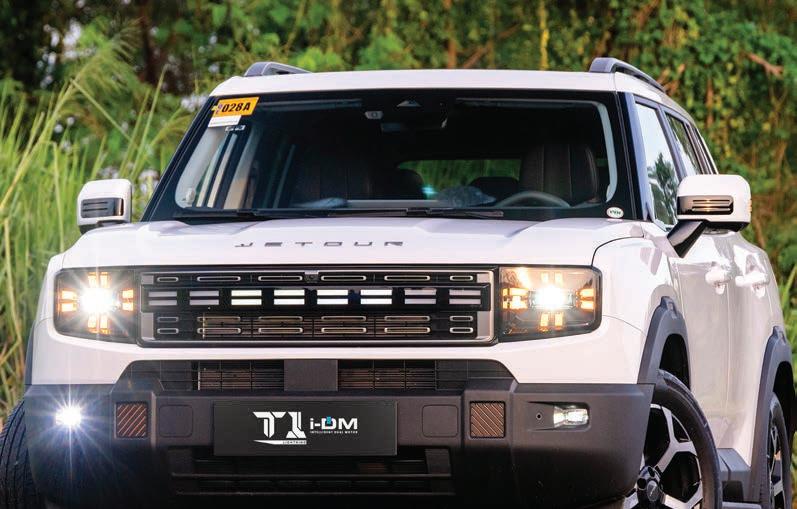
At a glance, familiar design elements suggest an association with the T2 platform. That united front grill, with its prominent brand logo and square lamps, looks familiar too. There are high/low beam LED headlamps, a front grille light strip, LED daytime running lights, a JETOUR logo (Puddle Light), an LED taillight, a turning indicator light, and front fog light LEDs. Moreover, there are automatic headlamps with height-adjustable settings and a delayed switch-off feature.
Notable glass/mirror features are rear occupant privacy glass, doubleglazed front windscreen, side mirror functions (electric adjustment, power heating, and automatic locking and folding), and the auto dimming rearview mirror.
Complementing the tough-looking bumpers and dark body claddings are the 19-inch alloy wheels wrapped in 235/60 series tires. Other exterior
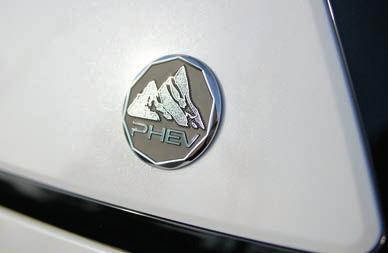
features are a power tailgate with memory function. Dimensionwise, the vehicle is 4,705mm long, 1,967mm wide, and 1,843 mm tall. The wheelbase is 2,800 mm and has a curb weight of 2,000 kg.
Damping-wise, the front suspension type is MacPherson independent suspension, while the rear type is multi-link independent suspension. The steering assist is electric. The body structure is a monocoque chassis with a front compartment metal guard, and battery side guards.
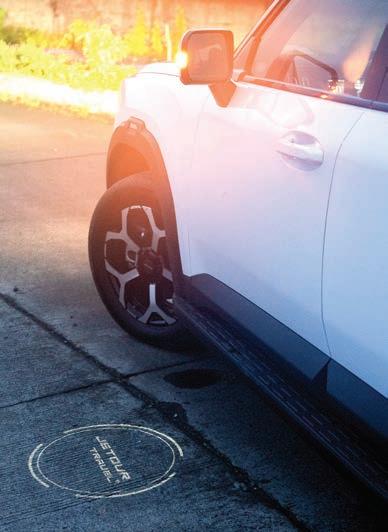
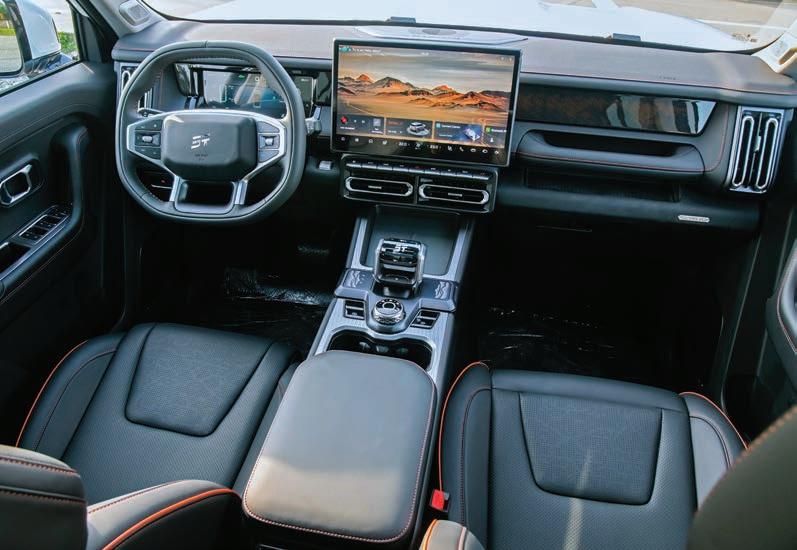
Inside, more familiar design elements from the T2 are also evident. JETOUR claims the cabin is elegant, robust, and quiet, offering tech for intelligent comfort. There are comfortable, cloud-like seats and a spacious passenger area. The fiveseater cabin offers environmentally friendly materials, including leather. The front occupants seats are ventilated, the driver’s seat is power adjustable and with height, lumbar support, and memory, while the passenger seat, is also power adjustable.
The four-way adjustable steering wheel is leather-wrapped, while the electronic shift selector is a crystal knob. Other interior elements are the panoramic sunroof, ISOFIX mounting anchor points (6), boot storage boxes, and four tie-down loops on the sides of the rear hatch opening.
In front is a 10.25-inch full LCD instrument cluster, which provides essential driving information. Then, the 15.6-inch touchscreen infotainment screen with 1080p resolution is powered by a Qualcomm Snapdragon 8155 chipset. It features multi-screen interaction, voice control function, quadraphonic zone voice control (front and rear), Bluetooth
audio and mobile phone connectivity, wireless Apple CarPlay and Android Auto, and a nine-speaker Sony audio system.
The automatic airconditioning features dual-zone temperature control with an Air Quality Management System (AQS) using a CN95 filter. Also, there are rear air vents, center armrest console has a cooling box.
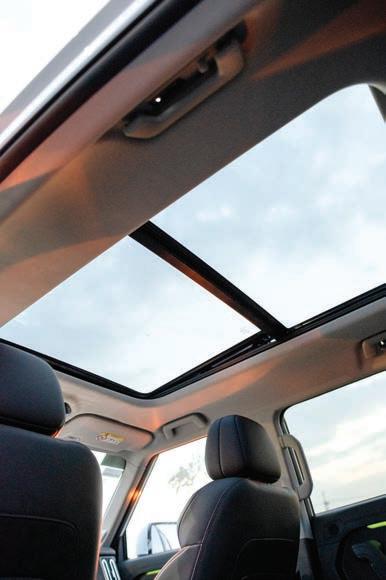
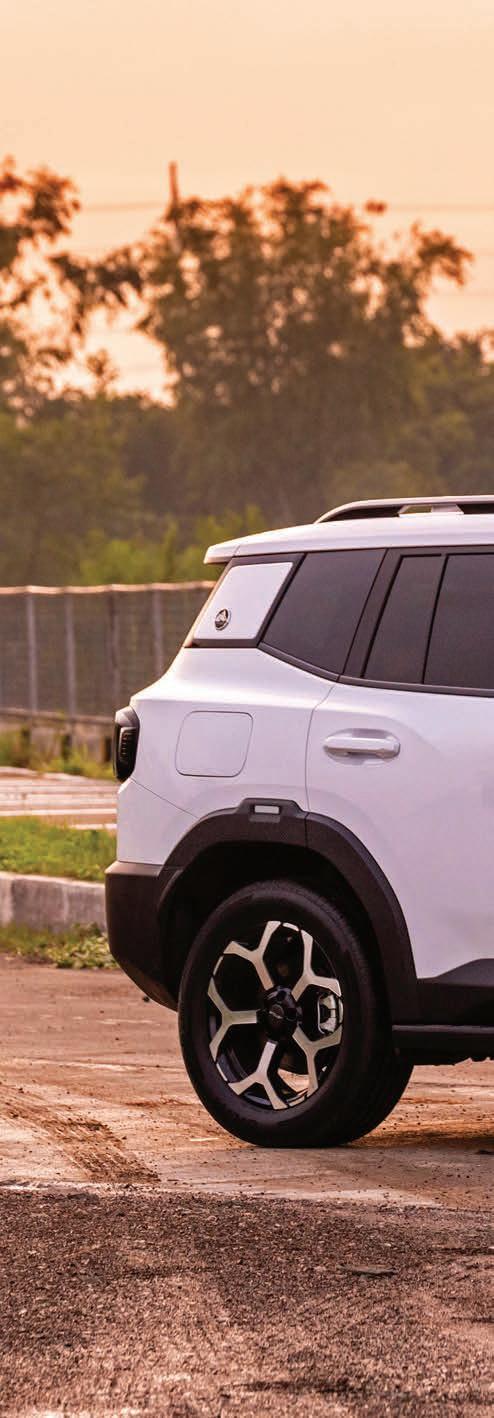
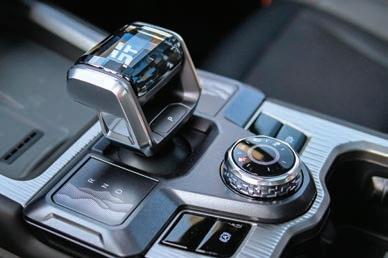
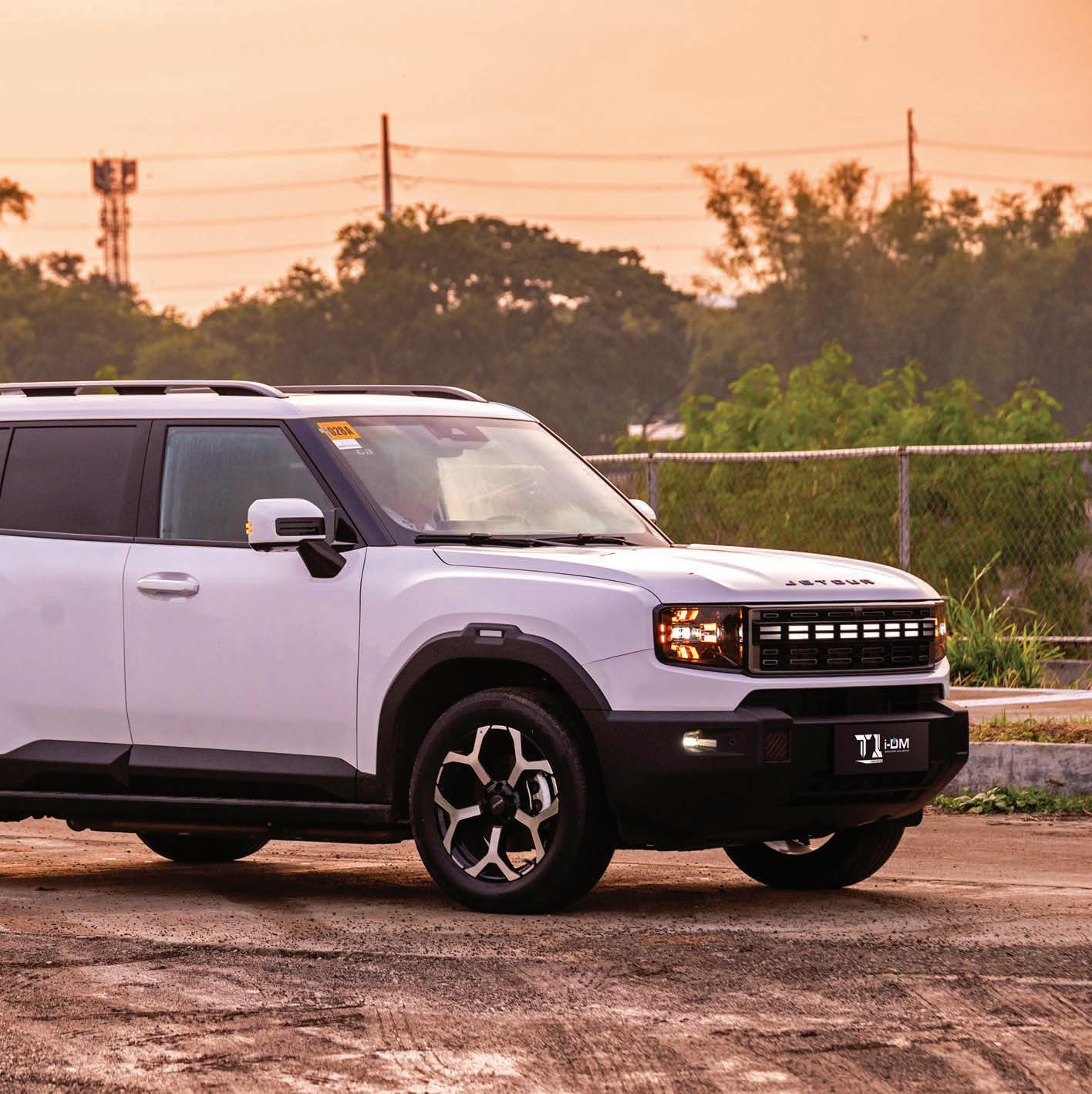
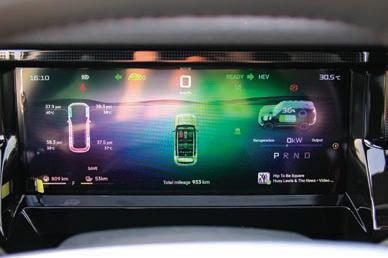

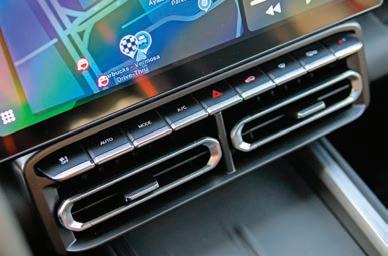
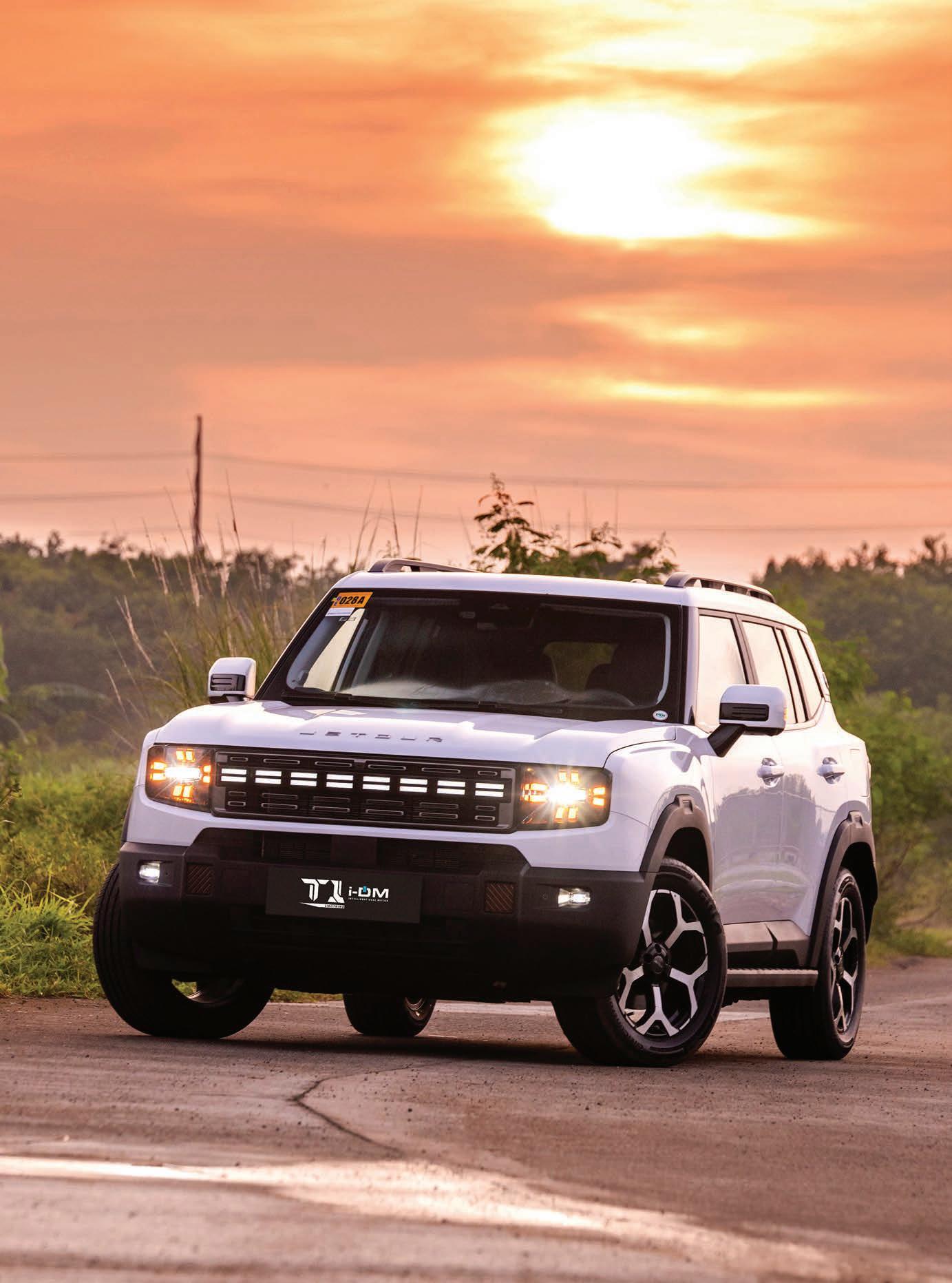
Yes, the T1 i-DM is the T2 ’s smaller sibling and shares the same platform.
Jetour ’s newest compact crossover SUV is tagged as “The Power of One ” because of its smart features, robust build, and sustainable powertrain, all you need in one vehicle.
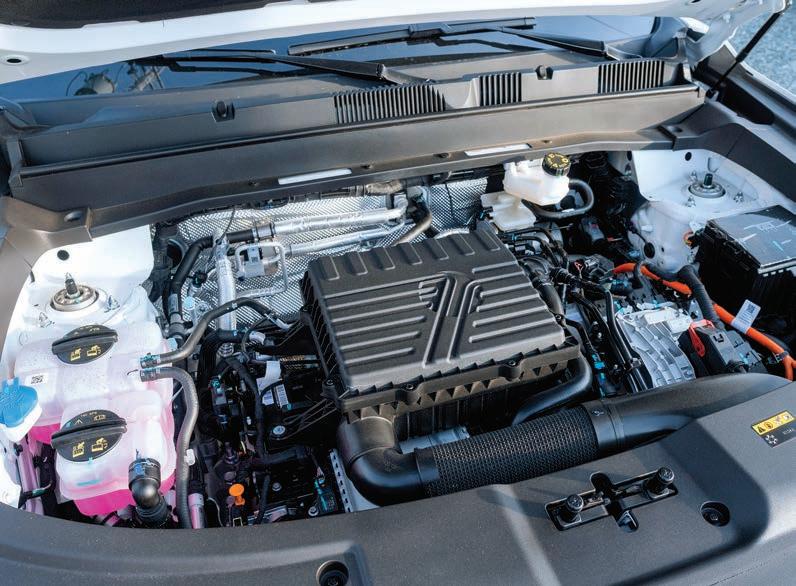
The JETOUR T1 Lightning i-DM’s plugin hybrid (PHEV) system consists of a 1.5-liter turbocharged engine that generates 154 hp/ 220 Nm of torque and a single permanent magnet synchronous traction motor that produces 201 hp/310 Nm of torque. A 26.7-kWh LiFePO4 battery supplies the electric juice. With a full battery charge, the T1 offers a full electric range of 117 kilometers and with a full tank of fuel and full charge, has a hybrid range of 1,300 kilometers.
All that power is delivered via a dedicated hybrid transmission (DHT) to the front wheels. Available driving modes are Eco, Sport, Normal, and Snow.
Moreover, the vehicle also has a vehicle-to-load (V2L) system capable
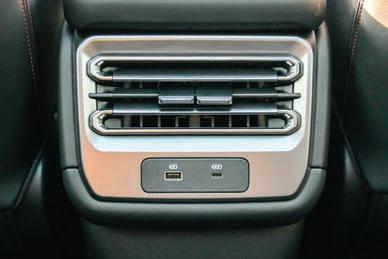
of supporting up to 6.6 kW of power. The charging port is the standard Type-2/CCS2 with a fast-charging function, achieving 30 to 80 percent in 30 minutes using a DC charger. At slow charging, 30 to 100 percent is achieved in four hours using an AC charger.
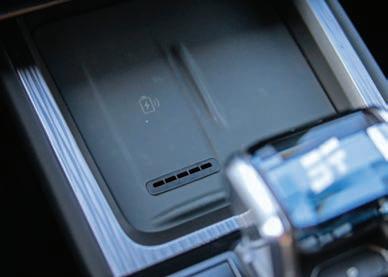
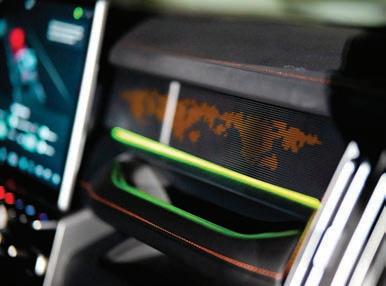
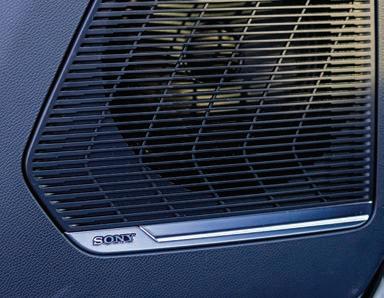
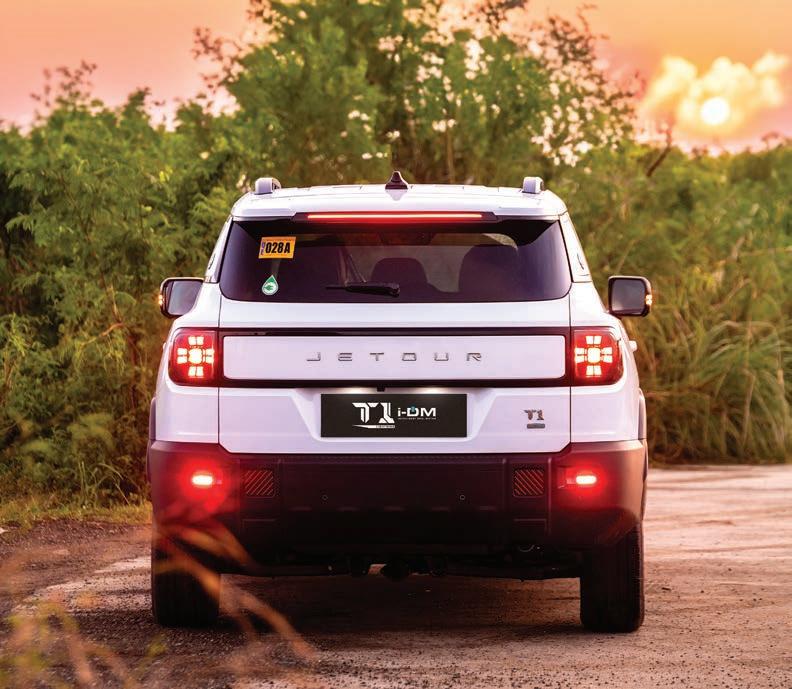
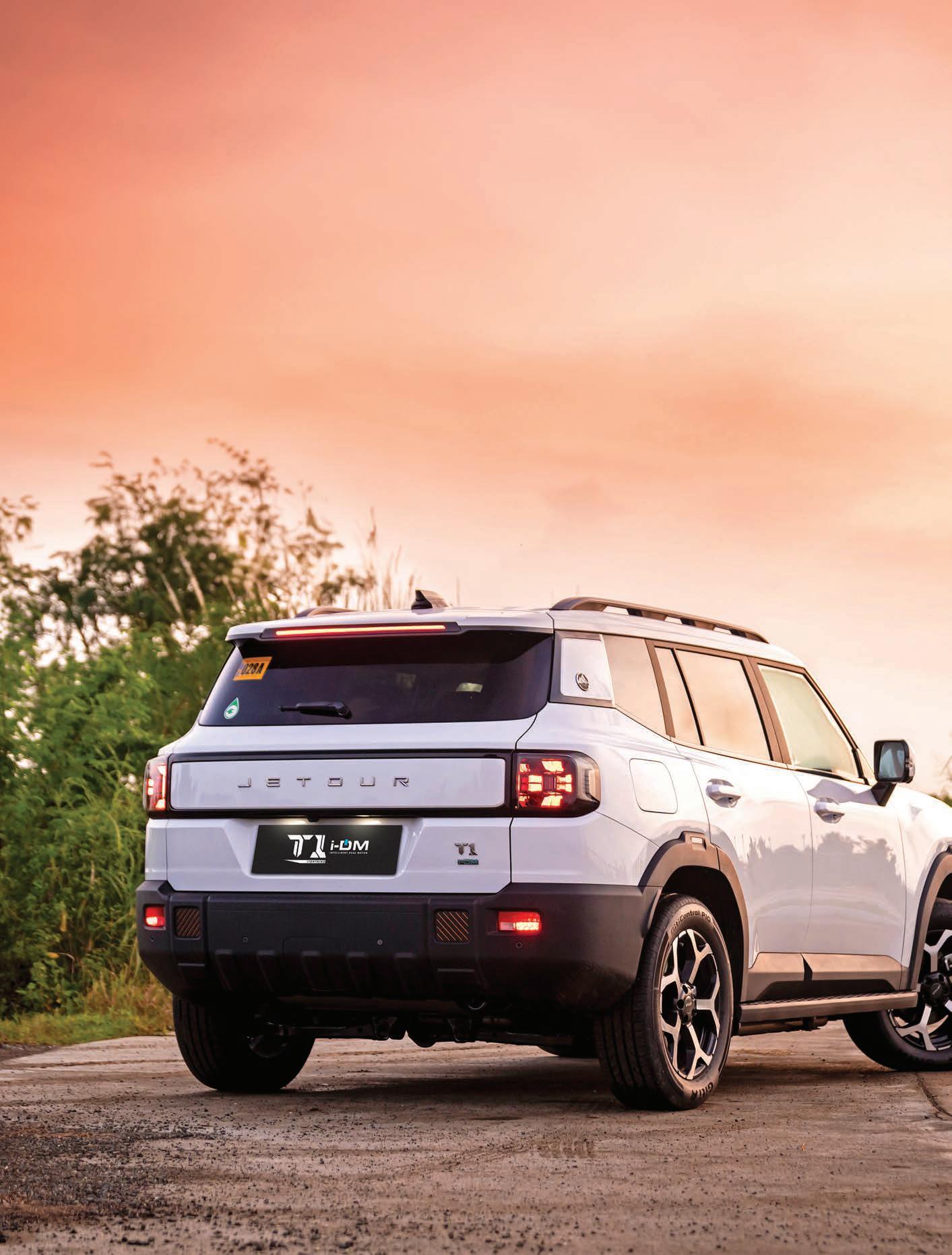
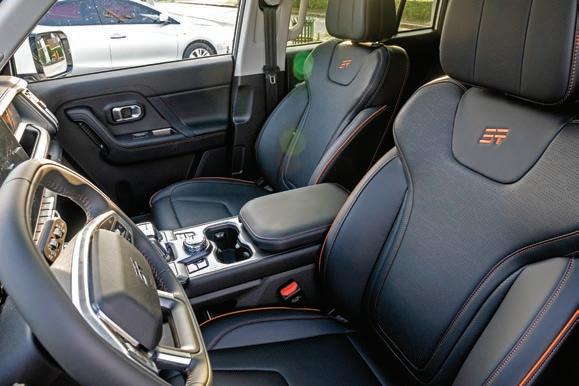

Other convenience features are central locking, remote start, keyless start, keyless entry, electronic parking brake, sensor wiper function, rear wipers, nap mode, and parking air conditioning. Moreover, there is a one-touch window up/ down function, a window anti-pinch function, an electric sunroof sunshade, and front door multi-layer laminated glass (with thermal and acoustic insulation).

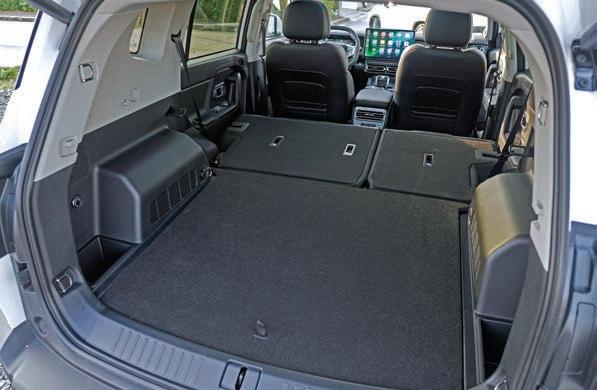
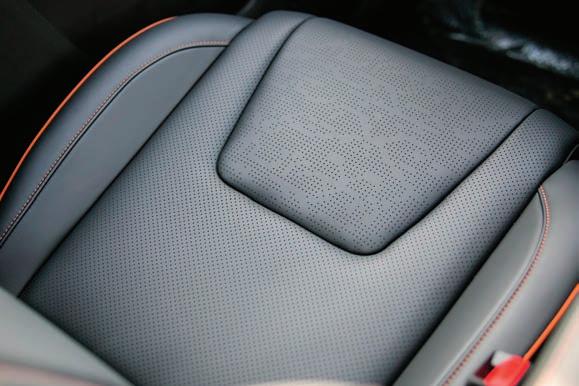
Moreover, the cabin has four USB ports (two type-A and two type-C), a front 12-volt power connector, a trunk 12-volt power connector, a wireless charging pad, a button reading light, ambient lighting, and trunk lighting.
The JETOUR T1 Lightning i-DM features Advanced Driver Assist System (ADAS) such as Lane Departure Warning (LDW), Lane Keeping Assist (LKA), Front Collision Warning (FCW), Active Braking (AEB), Adaptive high and low beam, Adaptive Cruise Control, Blind spot monitoring, Open Door Warning, Rear Collision Warning (RCW), and Rear Cross Traffic Alert System (RCTA).
Other active safety features are Corner Brake Control (CBC), Antilock Braking System (ABS), Brake assist (EBD/CBC/EBA/ BAS/BA), Traction control (ASR/TCS/TRC), Hill Assist, Hill Decent control (HDC), Stability Control (ESC/ESP/DSC), tire pressure monitoring function, Front/Rear Parking Radar, and Driver Assistance Image (540° panoramic image).
Standard safety features include airbags (driver, passenger, front/rear, side, and curtain), seat belt reminder, child seat
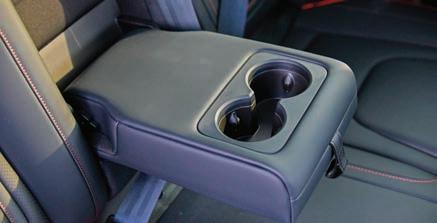
interface (ISOFIX/LATCH), mechanical child lock, and electronic engine immobilizer. The front brakes are ventilated discs, while the rear brakes are solid discs, and equipped with Electronic Parking Brake (EPB).
The JETOUR T1 Lightning i-DM retails at P1,898,000. It comes with a general 6 year or 1M kilometer mileage warranty (whichever comes first), 10 year engine warranty and 8 year or 150,000 km Battery warranty.
Available colors are Night Black, Sand Gold, Khaki White, Electroplated Green, and Silver.
RANDY S. PEREGRINO
SPECIFICATIONS
JETOUR T1 Lightning i -DM
Vehicle type: subcompact crossover SUV
Engine: 1.5-liter turbocharged gasoline 4 Cylinder
Power: 154 hp (115 kW)
Torque: 220 Nm (94 lb-ft)
Electric Motor: Permanent Magnet Synchronous
Power: 201 hp (150 kW)
Torque: 315 Nm (232 lb-ft)
Combined range: 1,300kms
EV Range: 117kms
Transmission: One-speed Dedicated Hybrid Transmission (DHT)
Front Suspension: Independent MacPherson Strut
Rear Suspension: Multi-link independent suspension
Front Brakes: Ventilated Disc
Rear Brakes: Disc
Steering: Electric Power Steering
Length: 4,705mm
Width: 1,967mm
Height: 1,843 mm
Wheelbase: 2,800 mm
Curb Weight: 2,000 kg
Cargo Capacity: 574 liters / 1455 liters (second row folded)
Fuel Tank capacity: 70 liters
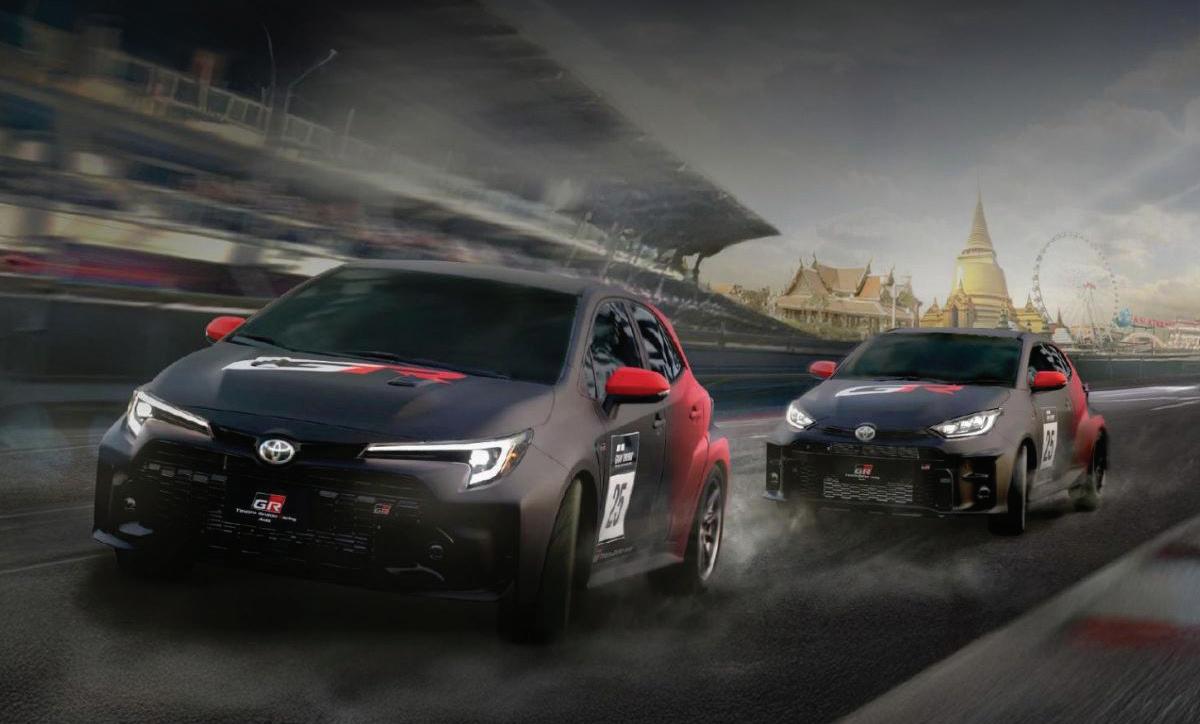
Toyota Motor Philippines (TMP) held its first-ever eSports racing series, the Toyota Gazoo Racing (TGR) GT Cup PH, during the height of the COVID-19 pandemic lockdowns, with the mission of inspiring future Filipino racers. Fast forward to 2025, TMP is at it again, igniting the sim racing fire with a challenge to those who have what it takes to qualify.
Now called the TGR Philippines eSports GT Championship, TMP is opening the competition’s qualifying rounds, which will last until September 14, 2025. The tournament features sprint races on the Gran Turismo 7 video game using PlayStation consoles.
TMP states that the tournament will serve as an opportunity for top qualifiers to participate in the Asia Finals, to be held in Thailand later this year. If they succeed, they’ll move up to the regional stage to represent the Philippines.
Those who have what it takes to conquer are in for some high-stakes prizes. These include cash prizes, GR merchandise, and an invitation to join
the TGR Academy.
For some people, coming out as an eSports racing champion is more than enough of an experience. However, for most participants, being invited to the TGR Academy via conquering the eSports challenge is the top goal. The TGR Academy gives them a chance to join TMP’s well-established one-make race, the Toyota GR Cup. The sim racing to real-world domination holds true for Russel Reyes and Luis Moreno, who are now champions of Toyota GR Cup in 2024 and 2025, respectively.
According to TMP, specific

requirements must be met to participate in its eSports racing challenge. It said that eligibility is open to Filipino citizens or permanent residents living in the Philippines. Additionally, participants aged 17 and under must have valid consent from a parent or guardian.
Participants may complete their qualifying heats online or offline. Online participants must have a PlayStation 4 or 5, an active PSN account, a PS Plus subscription, and a copy of Gran Turismo 7. On the other hand, those who prefer an offline experience may visit select Toyota GR Performance dealerships, where they’ll need to present a valid government-issued ID.
The registration for the 2025 TGR Philippines eSports GT Championship qualifiers is available through an online form. The qualifiers will determine the top 40 players who will advance to the quarterfinals on October 11, 2025, at Ayala Malls Manila Bay in Pasay City. Then, on October 12, the semifinals and national finals will be held at the same venue.
Last September 27 to 28, 2025, all roads led to the 3.5 km long Barangas Racing Circuit (BRC) for Round 2 of the SEAOIL Radical Challenge Philippines. Mikey Jordan and Juha Turalba would retain their leadership in the SR3 and SR1 Challenge Cup standings, respectively. But that action-packed race weekend left the leaderboards wide open.
Saturday qualifying set the tone with Mikey Jordan claiming pole in SR3 after a blistering best lap time of 1:37.364. But the biggest surprise came when Juha Turalba took charge, claiming not only the SR1 pole position, but also the 2nd overall position on the grid, beating several SR3 drivers in the process.
Jordan’s luck was challenged even before Race 1 began when his neon green #23 SR3 encountered a clutch problem. This left Turalba with a clear track ahead, holding off his SR1 rivals Jamal Almario and Miguel Quiñones in the opening laps. By the time Quiñones found his groove to give chase, Turalba had already built a commanding lead. Turalba crossed the line ahead of Quiñones, while Almario claimed a respectable 3rd. Up in SR3, Rafa Caceres took advantage of Jordan’s absence and won with a clean, consistent pace.
Jordan returned on Sunday for Races 2 and 3 with a spare SR3 machine. Starting from the back in Race 2, he stormed to

take the lead as the lights went green. After passing everyone on the straight leading to turn 1, he went on to take command, leading to his first win of the weekend. In SR1, Turalba found himself in a three-way fight along with Almario and Quiñones. However, the race was stopped when Turalba hit the barriers at turn 8. In the end, Almario secured the win with Turalba in 2nd, and Quiñones completing the SR1 top 3. The good news is that Turalba walked away with minor injuries and is expected to make a full recovery.
The final race of the weekend saw Jordan shrug off a slow start to take home another dominant SR3 win. In SR1,

Quiñones dodged Almario as the latter took a spin at turn 1. With a clear view ahead, Quiñones went on to clinch his first SR1 victory of the season.
Jordan maintains his lead in the SR3 Challenge Cup standings, followed by Rafa Caceres and Andre Rodrigues in 2nd and 3rd places, respectively. In SR1, Turalba continues his reign, although his Round 3 participation remains uncertain. Quiñones climbs to second overall, while Almario sits close behind in third.
Catch the action as the SEAOIL Radical Challenge Philippines heads to Clark International Speedway on October 18- 19, 2025, for Round 3, the season’s halfway point.
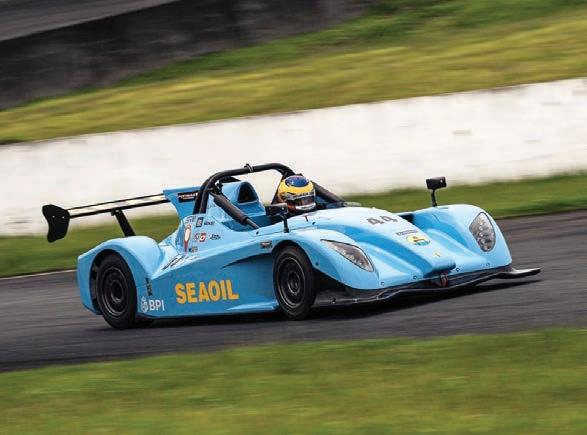



























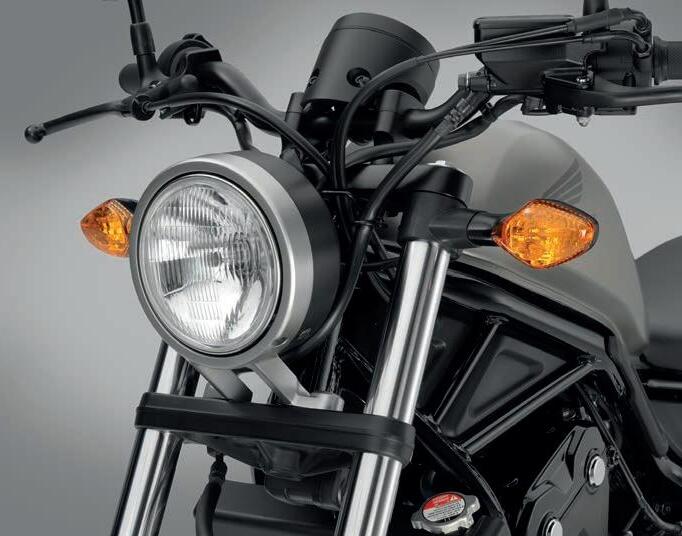



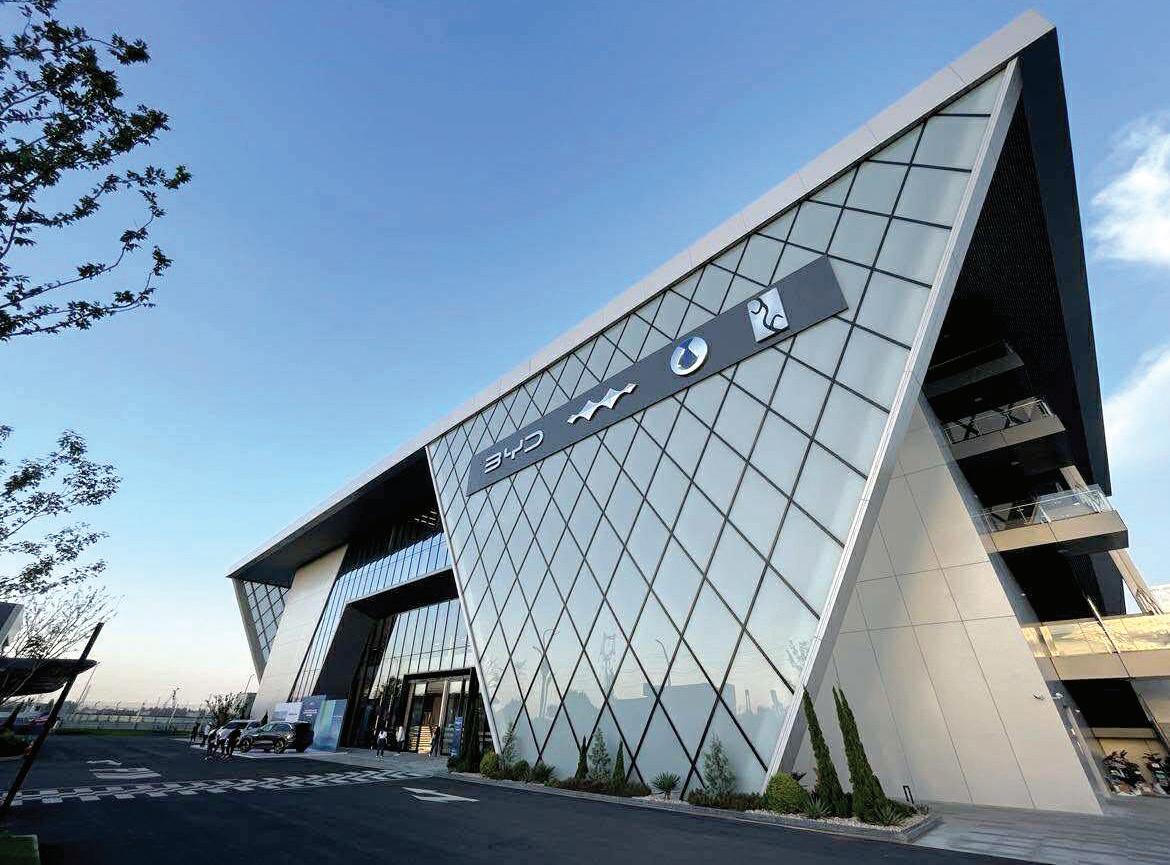

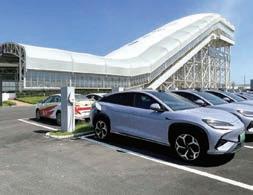
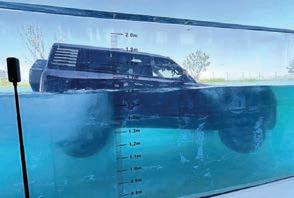
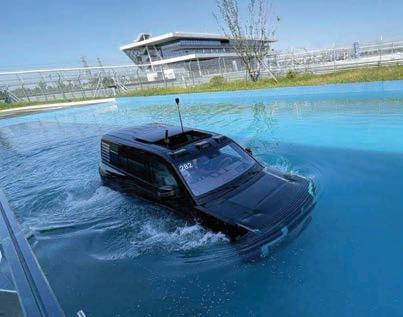

Words by Anjo Perez
hen the gates of BYD’s brand-new proving ground in Zhengzhou swung open, the world’s biggest electric vehicle maker wasn’t just showing off a test track—it was revealing the next chapter in its evolution. Among the first to witness this milestone were a handful of Filipino motoring journalists, invited to take part in a full day of driving activities at what can only be described as an
automotive playground built for the age of electrification.
Spanning hundreds of hectares in China’s Henan province, the Zhengzhou proving ground represents a 5 billion RMB investment and is the first of three massive new testing complexes BYD is building across the country. Designed from the
ground up to push its vehicles to their mechanical, electronic, and structural limits, the facility will serve as a proving ground for everything—from the company’s entry-level city EVs to its flagship supercars under the Yangwang performance sub-brand.
The track network features more than a dozen test zones: high-speed ovals, skid pads, slalom courses, off-road trails, water crossings, and even a race circuit built to professional
standards. For BYD, the site is not just an R&D playground but a physical manifestation of its growing dominance in the global new-energy vehicle (NEV) market.
The Filipino media delegation’s day began with a taste of controlled chaos—the low-friction circle, a water-drenched ring designed to simulate slippery
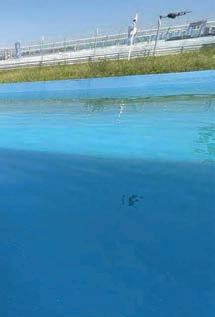

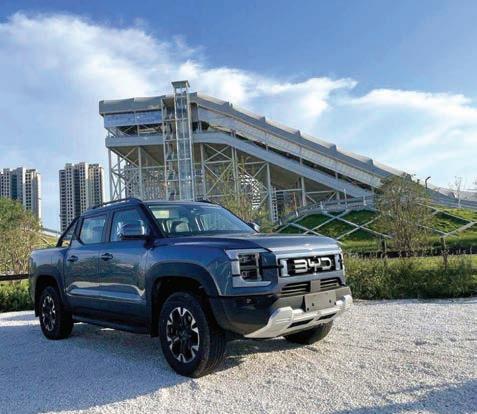
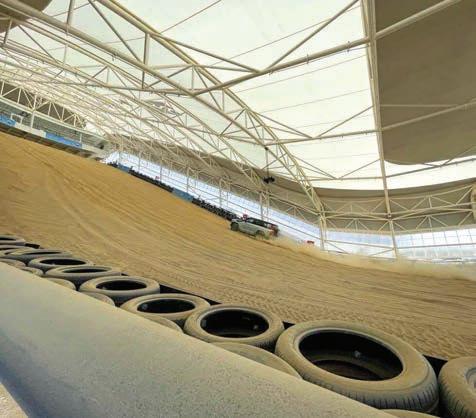
road conditions. One of BYD’s performance sedans was switched into drift mode, its tires scrabbling for grip as the car slid gracefully sideways. The point wasn’t to show off power, but control. Stability systems kicked in instantly, turning what would once have been a wild fishtail into a perfectly balanced slide. It was an early glimpse of how far BYD’s electronic driver aids and software integration have come.
Next came the water wading test, where the towering Yangwang U8 SUV, BYD’s new luxury off-road flagship, rolled confidently into a deep pool. Waves broke over its massive 22-inch wheels, but the U8 emerged without a sputter. The test underscored BYD’s obsession with sealing integrity and electrical waterproofing—an essential demonstration for skeptics who still doubt the durability of EVs in harsh, realworld conditions.
Then came the kick-plate exercise—a favorite among test drivers worldwide. As cars passed over a hydraulic plate that violently kicked the rear wheels sideways, the vehicles immediately corrected themselves using BYD’s Dynamic Traction Control. The recovery was instantaneous, demonstrating how fast the system’s sensors and actuators could respond to maintain control. It was a visceral reminder that electronic stability isn’t just about convenience—it’s about safety.
The highlight of the event, however, was reserved for the end. On the main track, BYD’s Yangwang U9 hypercar was waiting. The all-electric supercar, with its quad-motor e4 platform, has already claimed the record for the world’s fastest production car, with a verified top speed of 496 km/h.
it’s part of a systematic investment in R&D that already includes more than 90,000 engineers, tens of thousands of patents, and a commitment to innovation unmatched even by legacy automakers.
With two more proving grounds under construction, BYD is building a nationwide testing ecosystem that can replicate virtually every driving condition on Earth. From extreme heat to arctic cold, from highways to mountain passes, each site will specialize in different scenarios to refine every aspect of the company’s next-generation EVs and hybrids.
From water, the group moved to sand. On a steep, loose incline, another BYD SUV crawled effortlessly upward. Torque management, traction control, and instantaneous power delivery all came together seamlessly, proving that electric drivetrains are not only efficient but capable of precision control on unstable surfaces.
The off-road loop that followed was perhaps the most relatable for the visiting journalists. It featured ruts, rocks, and sharp ridges—terrain not far removed from provincial roads back home. The BYD test vehicles soaked up the punishment with surprising refinement. There was minimal cabin harshness, and suspension compliance felt finely tuned. For the Filipino guests, it was easy to imagine these same cars handling the unpredictable mix of city streets and countryside roads of the Philippines with ease.
Strapped into the passenger seat, journalists braced themselves as the U9 launched from zero to 100 km/h in an astounding 2.36 seconds. The surge of acceleration was violent yet smooth, pinning everyone into their seats as the horizon blurred. Laughter and disbelief filled the cabin—it wasn’t just speed, it was an experience that redefined what performance means in the EV era.
What made the day remarkable wasn’t only the performance of the cars, but the clarity of BYD’s message. The Zhengzhou proving ground is more than a spectacle—
For the Filipino journalists who attended, the visit to Zhengzhou was both a glimpse of the future and a statement of where BYD stands in the global hierarchy. The brand that once played catch-up to European and Japanese giants now leads the charge—not only in EV sales but in technological development and engineering infrastructure.
The Zhengzhou proving ground encapsulates that transformation. It’s a cathedral to precision, endurance, and ambition—a physical testament to how quickly BYD has evolved from a battery maker into an automotive powerhouse shaping the future of mobility.
As the convoy of test vehicles rolled out at sunset, the air buzzed with both electricity and optimism. The cars had proven themselves under pressure, the technology had impressed, and the message was unmistakable: BYD isn’t following the future of mobility—it’s building it.
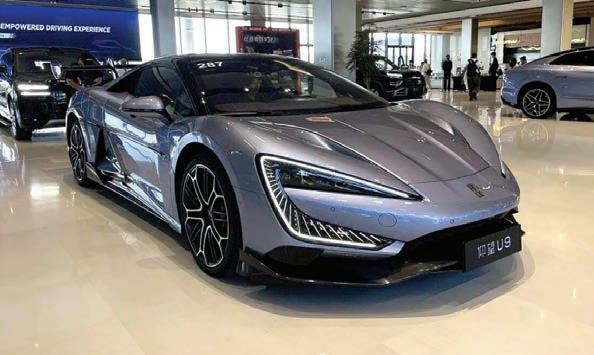
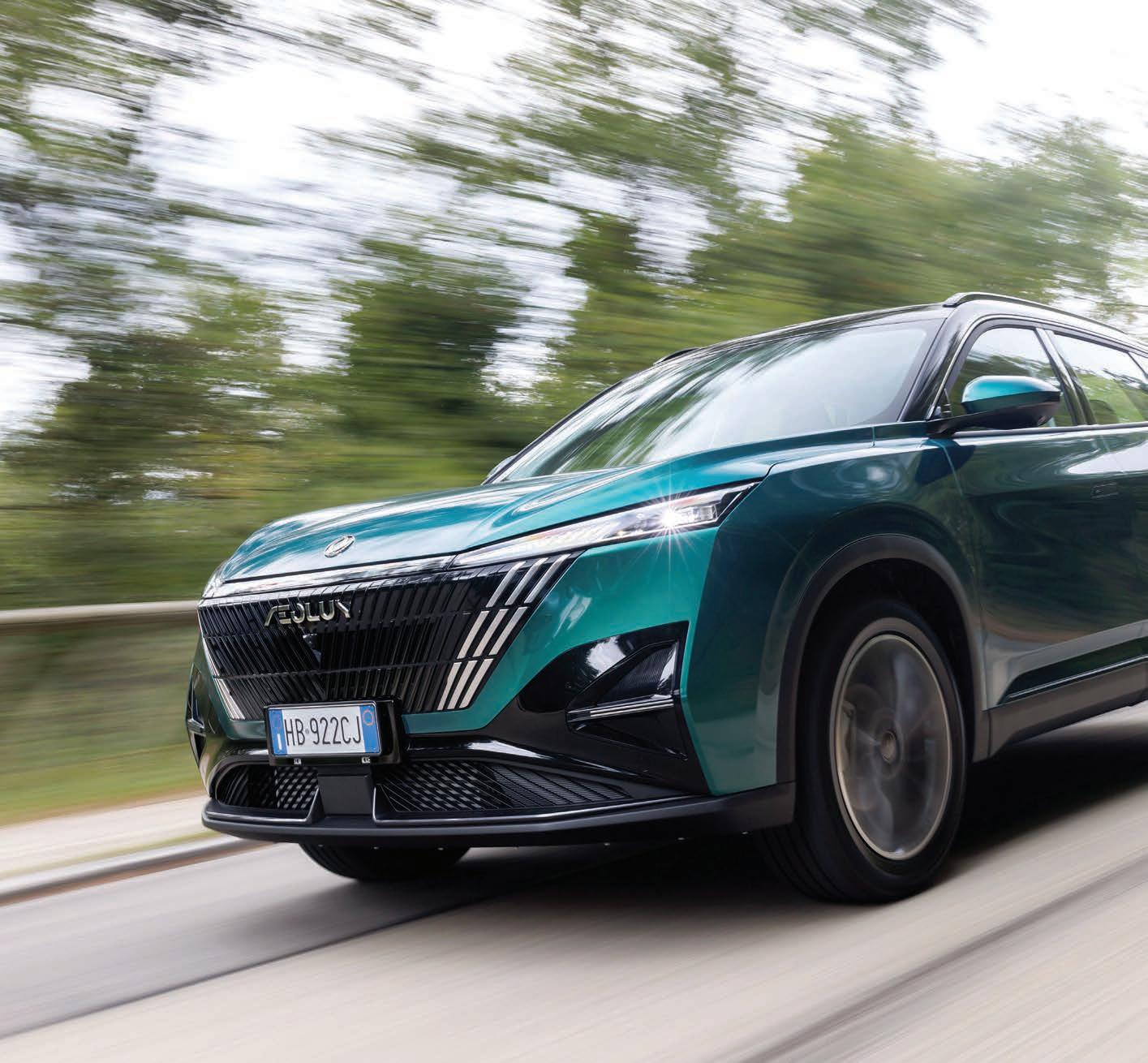
CHINA’S BOLD NEW PLAYER IN THE COMPACT SUV CLASS

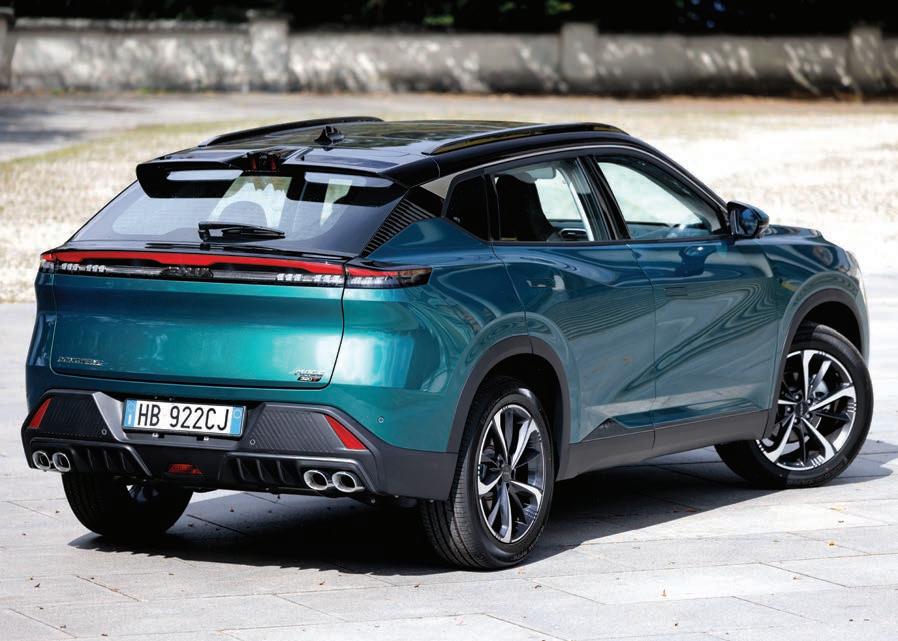
There’s a new player shaking up the local compact SUV scene, and it’s not shy about its intentions. The Dongfeng Mage, newly introduced by Legado Motors Inc., arrives with bold styling, premium features, and a surprisingly potent engine— making it a serious rival to familiar names like the Toyota Rush, Geely Coolray, and Chery Tiggo 7 Pro.
From the outside, the Mage doesn’t look like a newcomer trying to find its footing—it looks like it’s here to lead. At 4.65 meters long with a 2,775 mm wheelbase, it strikes a sleek, fastback profile more common to crossovers twice its price. The lines are tight and confident: slim LED headlights, hidden door handles, and a sculpted rear end capped with a spoiler and diffuser. The result is a design that looks dynamic even when standing still.
The brand’s designers clearly aimed for a fusion of European sophistication and Asian modernity. The Mage’s presence is sporty without being loud, elegant without being
conservative—a balance that’s hard to get right but impressive when achieved.
Under the hood lies a 1.5-liter turbocharged gasoline engine producing a solid 204 horsepower and 305 Nm of torque. Mated to a 7-speed dual-clutch transmission with paddle shifters, the Mage feels lively and quick to respond. Whether weaving through EDSA traffic or stretching its legs on the expressway, it carries itself with the confidence of a much more expensive SUV.
Drivers can toggle between Eco and Comfort modes to tailor performance, while the top speed sits at 190 km/h—more than enough for local roads. Yet despite the punchy output, the Mage maintains commendable efficiency at 7.2 liters per 100 km, proving that spirited driving and practicality don’t have to be mutually exclusive.
Beneath its striking form, the Mage rides on MacPherson struts in front and a multilink rear suspension, tuned for that delicate middle ground between comfort and handling. Ventilated front disc brakes
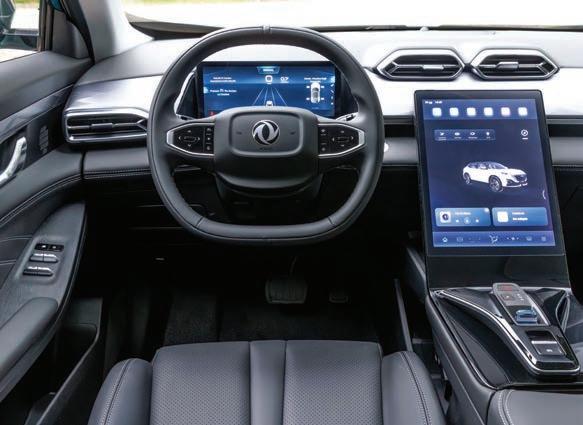
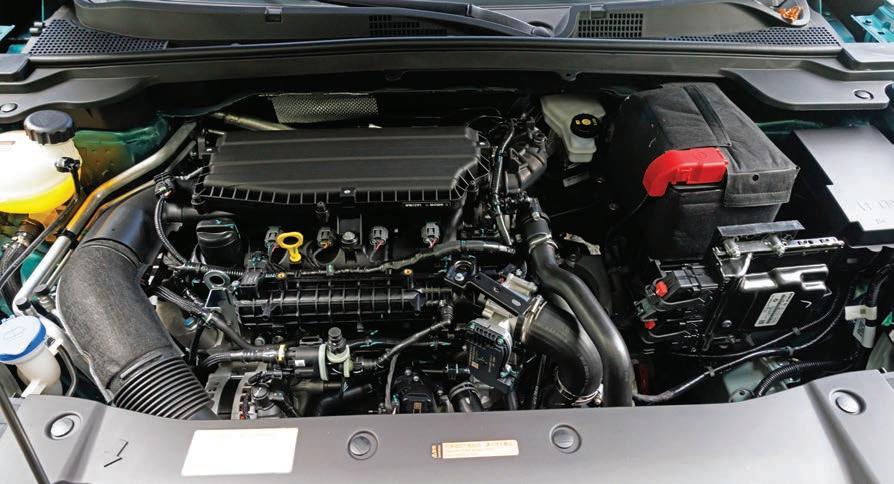
provide confident stopping power, and the standard 18inch wheels fill out the arches nicely.
Step into the cabin, and the Mage reveals a distinctly premium atmosphere. The materials feel substantial, from the Nappa leather upholstery to the minimalist metallic accents. A 13.2-inch vertical touchscreen dominates the dash, complemented by a 10.2inch digital instrument cluster. The interface is fluid and intuitive, with controls logically laid out for both driver and passenger.
Creature comforts abound. There’s a 50-watt wireless charger, USB-C ports front and rear, dual-zone climate control, and heated, poweradjustable seats. The panoramic sunroof floods the cabin with light, while a gamepad-style steering wheel adds a quirky,
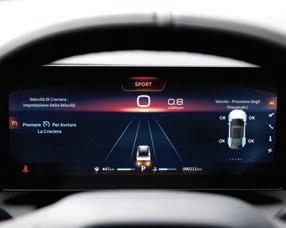
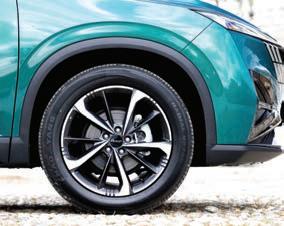
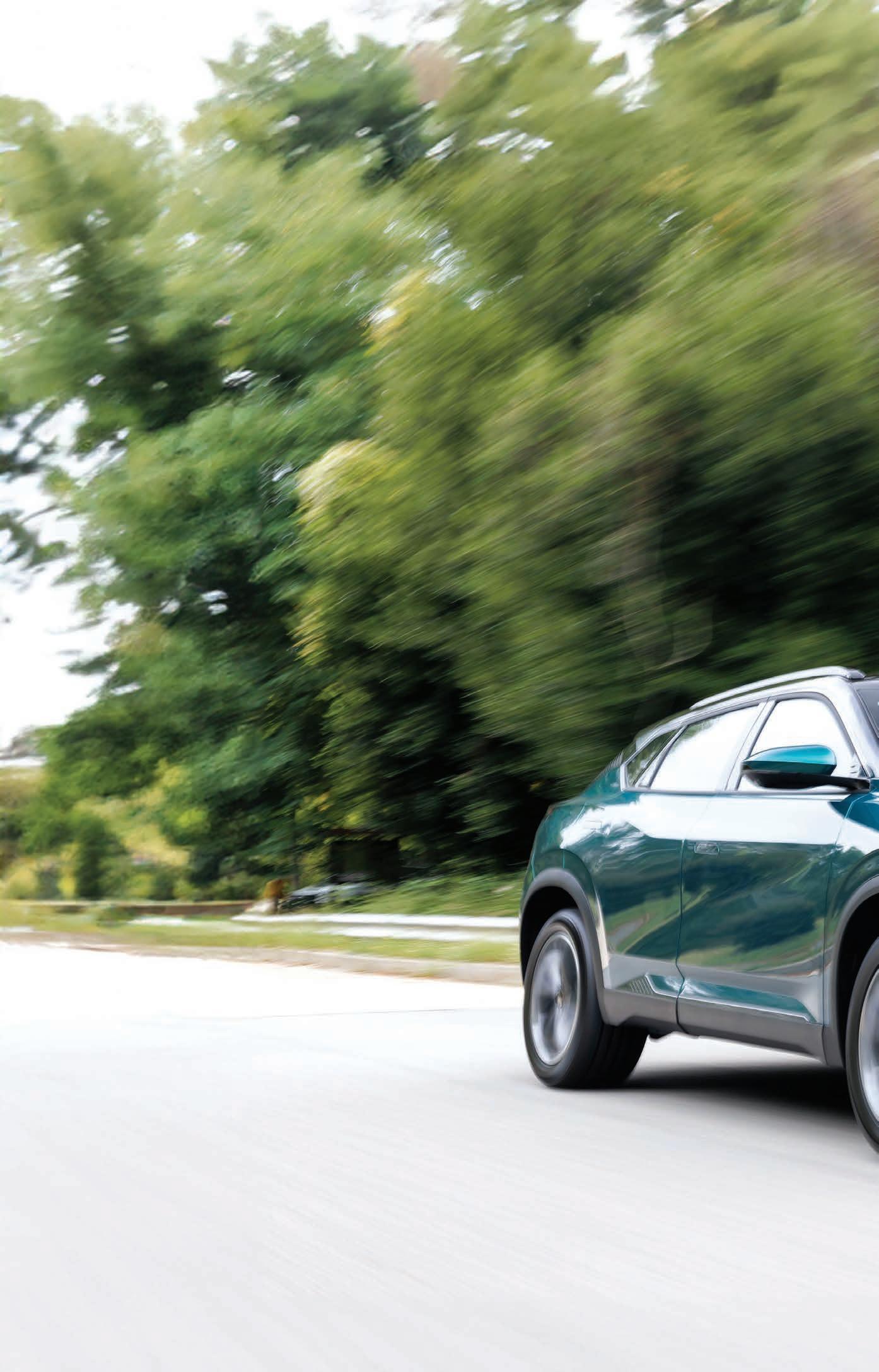

Electric vehicles have officially arrived in the Philippines, not just as luxury statements or experimental concepts, but as practical daily drivers. Leading this new generation of approachable EVs is the VinFast VF 5, a compact electric crossover that’s turning heads for its affordability, style, and city-friendly practicality. Built for the realities of Metro Manila traffic and the growing appetite for sustainable mobility,
the VF 5 has quickly become one of the most talked-about entrylevel EVs in the country.
The VF 5’s appeal lies in its simplicity. It’s small enough to conquer tight city streets yet substantial enough to feel like a proper SUV. At just under four meters long, it slides easily into cramped parking spots while offering the raised driving position Filipinos love. Its short
overhangs and compact turning radius make it a natural fit for dense urban areas, from Makati’s office districts to the winding roads of Antipolo.
Despite its compact footprint, the VF 5’s interior feels surprisingly spacious. Clever packaging gives it generous headroom and legroom, while the flat floor and flexible rear seats make the most of every inch. There’s enough cargo space for grocery runs, sports
gear, or an overnight bag for spontaneous road trips. For solo professionals, young couples, and small families, it strikes the right balance between comfort and practicality.
What makes the VF 5 particularly relevant to Filipino motorists is its long-term affordability. As a fully electric vehicle, it eliminates fuel costs
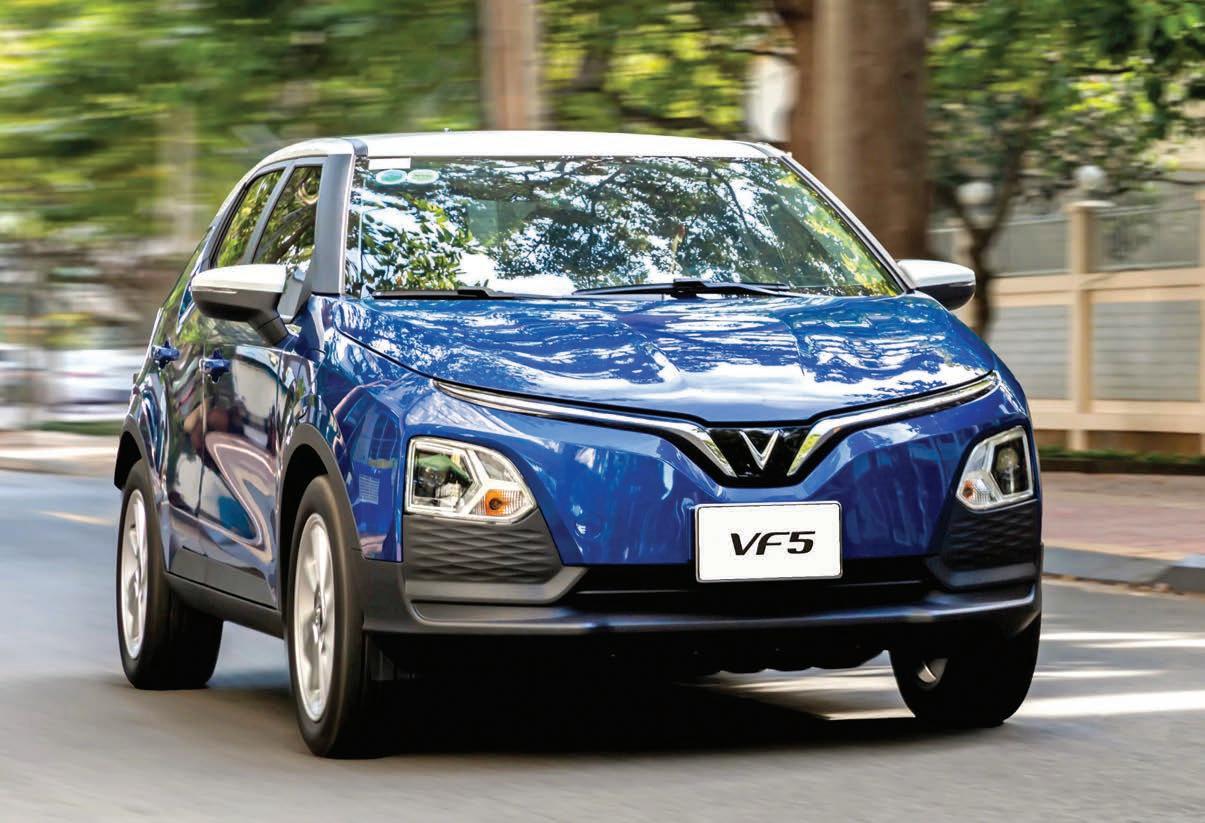
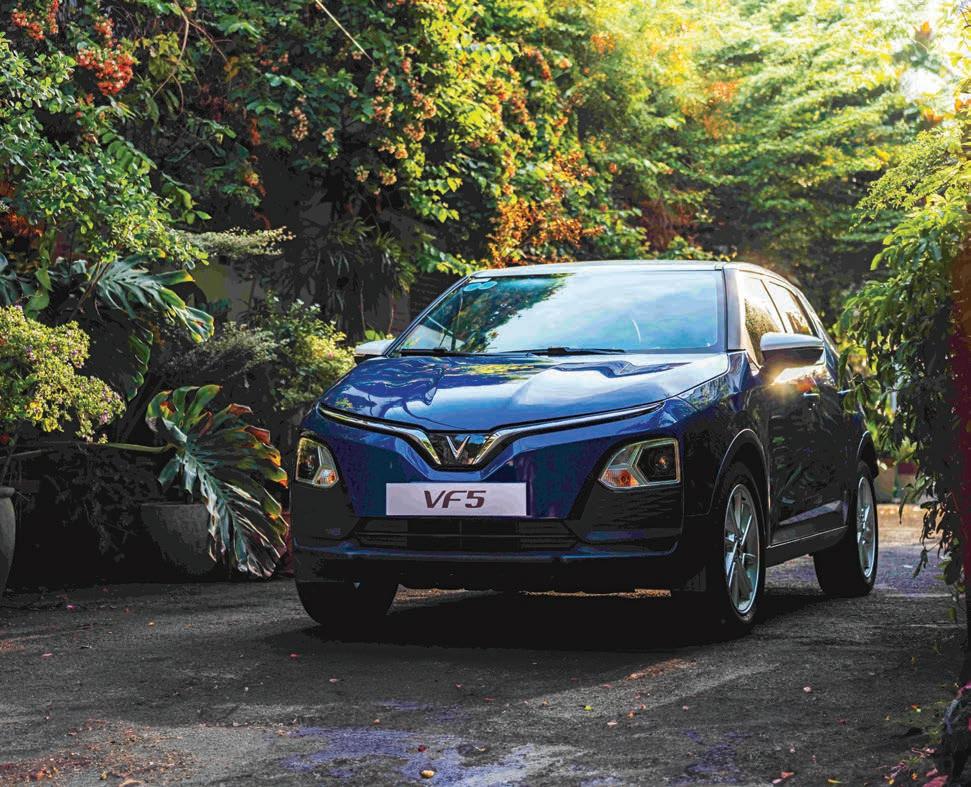
and reduces maintenance expenses dramatically. There are no oil changes, no spark plugs, and no traditional engine parts to worry about. It’s also covered by the Electric Vehicle Industry Development Act (EVIDA), which grants zero excise tax to EVs, making ownership more financially accessible.
VinFast sweetens the deal further with its V-GREEN public charging network, where VF 5 owners can enjoy free charging until 2027. With an expanding network of stations nationwide, this program not only reduces running costs but also makes
EV ownership easier and more convenient than ever. For many Filipinos wary of charging infrastructure, it’s a reassurance that the brand is investing in the ecosystem, not just the vehicle.
Powering the VF 5 is a 100 kW (134 hp) electric motor producing 135 Nm of torque, providing smooth, silent acceleration that feels both effortless and refined. The power delivery is instant—perfect for quick overtakes or merging into fastmoving traffic. Whether zipping
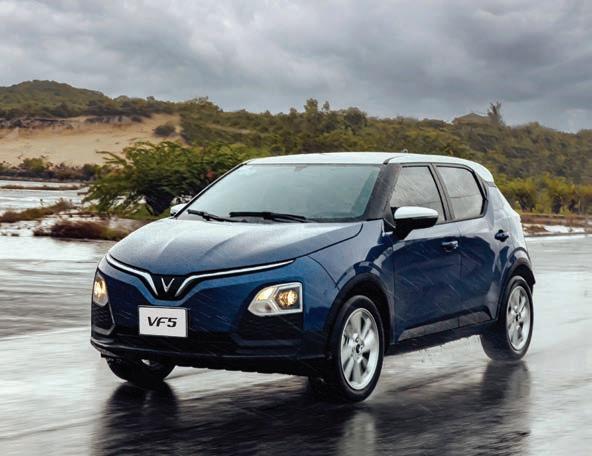
control (ESC), hill-start assist, and blind-spot monitoring— features not always found in vehicles of this size or price point. A reinforced high-strength steel frame provides structural integrity, offering peace of mind for both city commutes and outof-town drives.
through EDSA or cruising down the South Luzon Expressway, the VF 5 delivers the kind of linear, confident performance that makes electric driving addictive.
On a full charge, it can travel up to 326 kilometers (NEDC), comfortably covering several days of city driving or even a weekend trip to Pampanga or Batangas without recharging mid-journey. When it’s time to top up, the VF 5 supports fast charging, reaching 70 percent from 10 percent in roughly 30 minutes—just enough time for a coffee break or quick errands.
Inside, the VF 5 blends simplicity with sophistication. The centerpiece of the dashboard is an 8-inch touchscreen that integrates Apple CarPlay and Android Auto, allowing seamless smartphone connectivity for navigation, calls, and entertainment. Everyday convenience features such as keyless entry, push-start ignition, and cruise control make driving smoother and more intuitive.
Safety is another strong suit. The VF 5 comes equipped with six airbags, electronic stability
Designed by Torino Design in Italy, the VF 5 captures attention with its bold proportions and youthful energy. The styling is clean yet expressive, defined by sculpted lines, a distinctive grille, and sharp LED lighting signatures. The overall effect is modern and upbeat—perfect for young professionals and styleconscious families who want their car to make a statement.
VinFast also offers customizable two-tone color combinations, adding a touch of personalization and playfulness. Whether it’s gliding through Bonifacio Global City or parked at a Tagaytay café, the VF 5 looks right at home in every setting, reflecting a cosmopolitan yet approachable personality.
As electric mobility becomes more mainstream, the VF 5 has carved out its niche as the EV for everyday Filipinos—those who want the benefits of going electric without the intimidation factor. It appeals to practicalminded drivers who want an economical, future-proof vehicle, as well as to eco-conscious consumers ready to reduce their carbon footprint.
The VF 5 embodies the idea that clean mobility doesn’t have to be complicated or expensive. It’s an EV that feels familiar yet forward-looking, accessible yet aspirational. And in a market increasingly defined by traffic congestion, fuel uncertainty, and environmental awareness, the VF 5 might just be the right car at the right time.
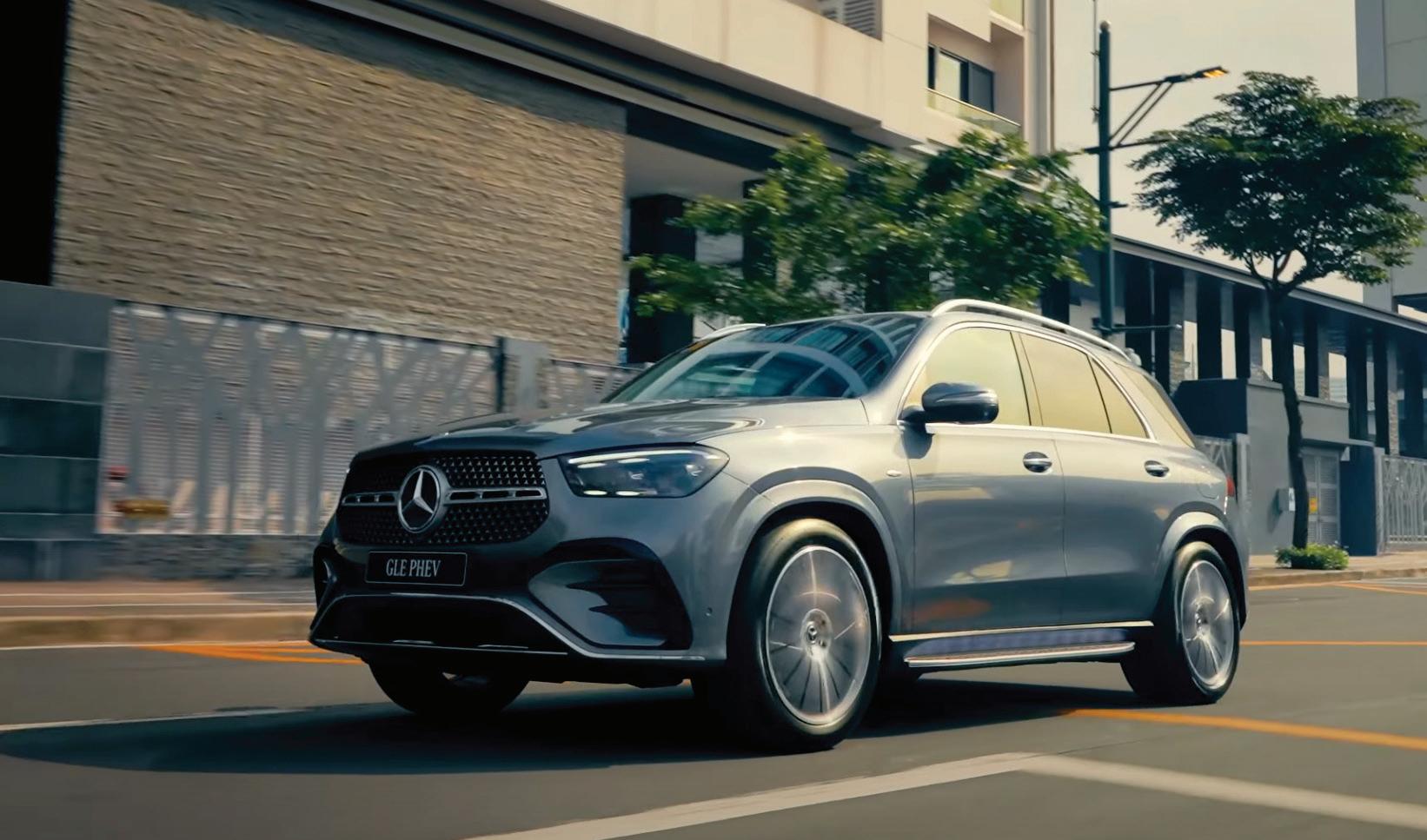
Mercedes-Benz Philippines has entered the next chapter of its electrified journey with the launch of the GLE 400 e, a plug-in hybrid SUV that blends traditional elegance with cutting-edge hybrid performance. It’s the latest proof that luxury and sustainability can coexist without compromise—offering refinement, power, and quiet sophistication in one commanding package.
A Familiar Form with an Electrified Heart
At first glance, the GLE 400 e looks every bit like a modern Mercedes—bold, sculpted, and confident. But underneath that familiar silhouette lies the
brand’s EQ Hybrid Technology, a sophisticated system that seamlessly pairs a 2.0-liter turbocharged gasoline engine with an electric motor. Together, they produce 252 horsepower and 400 Nm of torque, channeled through a 9G-TRONIC nine-speed automatic transmission and 4MATIC allwheel drive.
What sets this SUV apart is its all-electric capability. The GLE 400 e can travel over 100 kilometers purely on battery power, allowing most urban drives—say, a full day around Metro Manila—to be completed without consuming a single drop of fuel. Plug it in overnight using a home wallbox or a standard outlet, and it’s ready to go again by morning. It’s electric convenience wrapped in
the serenity and assurance of a Mercedes-Benz.
On the road, the GLE 400 e feels instantly familiar to anyone who’s driven a Mercedes, yet distinctly modern
in character. Electric torque makes acceleration smooth and effortless, while the hybrid system manages power delivery so seamlessly you can barely tell when the engine kicks in. The nine-speed automatic transmission shifts with characteristic precision, and 4MATIC all-wheel drive ensures

unwavering traction whether gliding through Skyway traffic or winding up to Tagaytay.
Despite its size, the SUV handles with composure. The suspension feels well-judged—comfortable over bumps but taut enough to keep the chassis flat through corners. There’s a sense of refinement to every movement, that signature Mercedes mix of calm and confidence.
Mercedes-Benz has always mastered the art of understated presence, and the GLE 400 e continues that legacy. The AMG Line package adds a dose of athleticism, with a diamondpattern grille, aggressive front and rear bumpers, and 21-inch AMG alloy wheels that complete the SUV’s commanding stance.
MULTIBEAM LED headlights adapt automatically to road and traffic conditions, while chrome accents on the rear lend a touch of timeless luxury. It’s bold without shouting— distinctly Mercedes in form and philosophy.
Step inside, and the GLE 400 e reminds you why Mercedes-Benz cabins remain the benchmark in automotive luxury. Every surface exudes craftsmanship—from the ARTICO leather and MICROCUT microfiber upholstery to the brushed aluminum trim that runs across the dashboard.
Dominating the cockpit are twin 12.3-inch digital displays that make up the MBUX Widescreen Cockpit. It’s not just a pretty interface—it’s one of the most advanced infotainment systems in the world, capable of augmented reality navigation that overlays real-time directions on live video. The system responds to voice commands as naturally as it does to touch, while the Burmester surround sound system turns every journey into a concert.
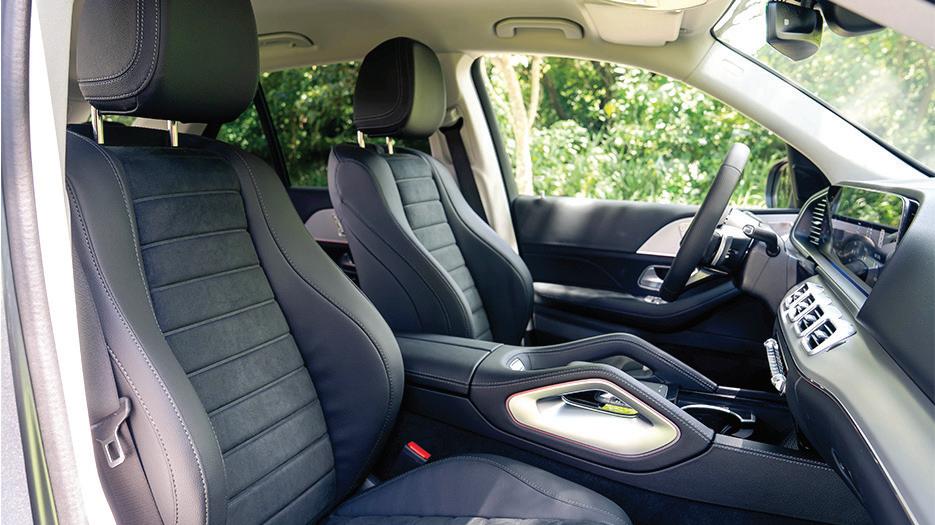
Comfort features abound: electrically adjustable seats with memory, ambient lighting that transforms the cabin mood, and tri-zone climate control for every occupant’s comfort. At night, the soft illumination from the ambient LEDs creates a cinematic glow, a subtle reminder that luxury doesn’t have to be loud—it just has to feel right.
While the GLE 400 e is built for city sophistication, it isn’t afraid to get its wheels
dirty. The Transparent Bonnet function gives drivers a virtual view beneath the vehicle when navigating rough terrain or steep driveways, essentially “seeing through” the hood via cameras and displays. Paired with Active Parking Assist, a 360-degree camera, and Parktronic sensors, maneuvering this nearly five-meter SUV in tight spaces feels surprisingly effortless.
Safety, as expected, is nonnegotiable. The GLE 400 e comes equipped with PRESAFE collision anticipation,

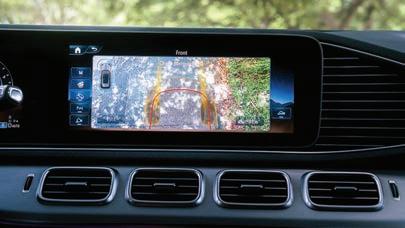
Active Brake Assist, Blind Spot Monitoring, and Attention Assist, all working discreetly in the background to keep both driver and passengers secure.
There’s an unmistakable satisfaction in the way the GLE 400 e drives. Whether running silently in EV mode or with the engine humming quietly alongside, it moves with grace and authority. It’s a showcase of balance—between power and efficiency, luxury and restraint, tradition and progress.
With an introductory price of P5,790,000, the GLE 400 e offers a compelling proposition: the full prestige of a Mercedes-Benz SUV, with the forward-thinking performance of a plug-in hybrid. The GLE 400 e doesn’t just represent the future of the brand—it represents the evolution of luxury itself. It’s what happens when heritage embraces innovation, and when silence becomes the new sound of power.
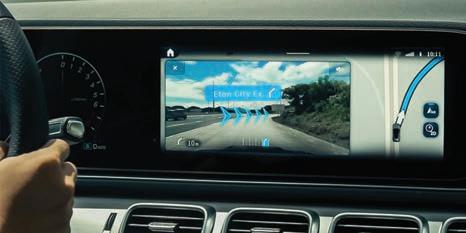
t the recent Boxer Madness 6 event, Subaru Philippines officially pulled the wraps off the 2026 Subaru Forester Hybrid, marking the brand’s long-awaited entry into the full hybrid SUV segment. For a company known for its rally-bred all-wheel-drive machines, the move may seem overdue—but Subaru has done its homework. This isn’t just another eco-badged crossover; it’s a proper Subaru with an electrified edge.
The First True Subaru Hybrid for the Philippines
While the outgoing Forester already offered a mild-hybrid system, that setup barely made a dent in real-world performance or efficiency. The new model is a different animal. Borrowing the e-Boxer hybrid system from the Crosstrek S:HEV, this Forester finally integrates electric power into Subaru’s mechanical DNA. At the heart of the SUV is a 2.5-liter four-cylinder boxer engine paired with an electric motor and a compact 1.1 kWh lithium-ion battery. Combined output stands at 194 horsepower, channelled through a Lineartronic CVT and Subaru’s trademark Symmetrical AllWheel Drive. The setup allows brief bursts of pure electric driving in stop-and-go traffic and delivers a smoother, quieter response under load. In Subaru’s own testing, the hybrid is capable of over 1,200 kilometers on a single tank—a range that could easily take Filipino families from Manila to Ilocos and back without refueling. Where other brands are leaning on electric front-wheeldrive platforms, Subaru stays loyal to its core. The brand’s symmetrical layout ensures balanced weight distribution and consistent traction whether on wet asphalt, rough backroads, or winding mountain passes. The e-Boxer doesn’t try to reinvent the wheel—it simply makes the

Subaru experience more efficient without losing its soul.
The arrival of the hybrid also heralds the sixth-generation Forester. The design is both evolutionary and modern: a wider grille that merges seamlessly into slimmer LED headlights, sharp C-shaped daytime running lamps, and a cleaner profile accented by 19inch alloy wheels. Subaru logos now share space with subtle e-Boxer and Symmetrical AWD badges, hinting at what lies beneath.
The structure itself is more rigid—about 10 percent stiffer, according to Subaru engineers— resulting in improved comfort and composure. The WRXderived steering rack lends the Forester Hybrid a sharper, more confident feel in corners, without sacrificing its trademark ride comfort.
Inside, the new Forester elevates the brand’s cabin experience. Taking center stage is a portrait-style 11.6inch Starlink touchscreen that supports wireless Apple CarPlay and Android Auto. The materials feel more upscale, highlighted by leather upholstery, Harman
Kardon audio, and poweradjustable front seats. Subaru has also invested in improved sound insulation, making the cabin noticeably quieter on the move.
While global versions get a fully digital gauge cluster, the Philippine model retains a pair of analog dials with a central display—a small compromise for what remains a well-executed cockpit. Every switch and surface feels built to last, exuding the robustness Subaru owners have come to expect.
Subaru’s latest EyeSight 4.0 driver-assist suite makes its debut in this model, now enhanced with a wide-angle

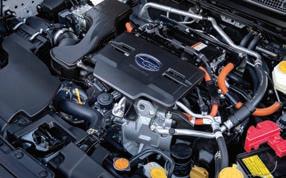
stereo camera and new support features. Among them is the Emergency Driving Stop System (EDSS), which can automatically bring the car to a halt if it detects an unresponsive driver. Other technologies include adaptive cruise control, lane centering, blind spot detection, rear cross-traffic alert, 360-degree camera, and automatic emergency steering. A rear seat reminder adds another layer of safety for families with children or pets.
In global tests, the Forester Hybrid delivers around 35 mpg combined, equivalent to roughly 15 kilometers per liter—a 40 percent improvement over its gasoline-only sibling. Yet, performance remains respectable: 0–100 km/h in 8.6 seconds. The seamless handoff between electric and gasoline power gives it a refined, almost European feel, ideal for city commutes yet confident enough for long highway drives.
At P2,498,000, the Forester Hybrid neatly positions itself between its segment rivals— undercutting the Honda CR-V RS e:HEV while sitting slightly above the Toyota RAV4 HEV. That pricing gives Subaru a strategic advantage: a true AWD hybrid SUV at a price point where most competitors only drive two wheels.
The 2026 Subaru Forester Hybrid signals more than a new model launch—it marks Subaru’s evolution. It bridges the brand’s rugged, rally-inspired past with an electrified, efficiencyconscious future. For loyalists, it’s proof that you can go green without giving up the traits that make a Subaru, a Subaru. And for everyone else? It might just be the best reason yet to rediscover the Forester nameplate.

